

9 Best Alaska Backpacking Trails To Thru-Hike
Looking for the best Alaska backpacking trips? Alaska has no shortage of amazing multi day backpacking trails to follow, especially thru-hikes.
Backpacking in Alaska can be an extremely fun and rewarding experience. You can choose to create your own path in the remote backcountry but there are plenty of established backpacking trails routes that won’t require any off-trail hiking.
Alaska long distance trails aren’t that long in comparison to other thru-hikes elsewhere. The longest fully established hiking trail in this list is only 39 miles long.
In this post, I’m going to share the best backpacking trails in Alaska and directions on how to get to each trail.
9 Best Alaska Backpacking Trips To Thru Hike
9. grace ridge trail, 1. resurrection pass trail.
Distance: 39 miles one-way Time: 3 to 5 days Elevation Gain: 2,200 feet Difficulty: Moderate
Resurrection Pass Trail is one of the best thru-hikes in Southcentral Alaska. This 39-mile long trail is well maintained and has a ton of campsites and cabins to stay in along the way.
You can complete this backpacking trip northbound from Cooper Landing to Hope or southbound from Hope to Cooper Landing.
The south trailhead in Cooper Landing is located 106 miles south of Anchorage and is best used from June to October. However, the trail is open year-round and a lot of people ski or bike to the public use cabins during the winter.
This trail also connects to Devils Pass Trail , which is another great option for backpacking.
Read the full trail guide: Backpacking Resurrection Pass Trail in Alaska
How to get to Resurrection Pass Trail South in Cooper Landing:
From Anchorage, head south on the Seward Highway and continue for 87 miles. Take a slight right onto the Sterling Highway. Continue for 16 miles through Cooper Landing. Resurrection Pass Trail South parking lot will be on your right.
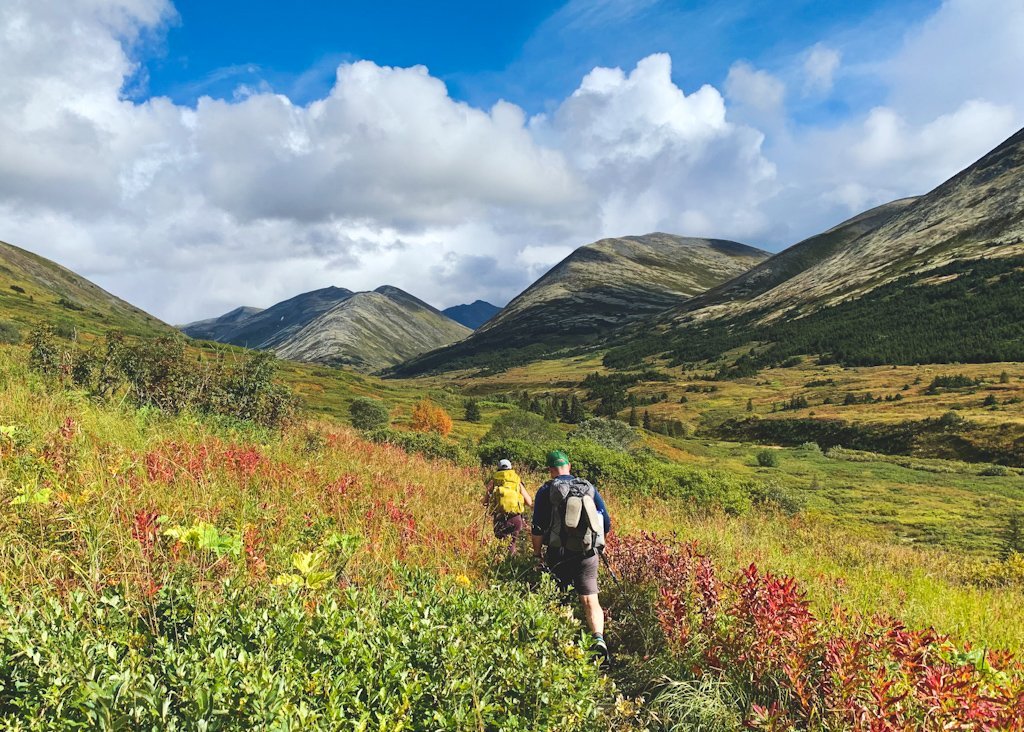
2. Historic Chilkoot Trail
Distance: 33 miles one-way Time: 3 to 5 days Elevation Gain: 6,800 feet Difficulty: Difficult
The Chilkoot Trail is a 33-mile historic trail that starts in Dyea, Alaska, and ends in Lake Bennett, British Columbia, and each summer over 10,000 people hike some or all of it.
Hikers set out to retrace the journey of gold rush stampeders and pass by artifacts left behind by gold rush stampeders. The hardest part of this trail is ascending the very steep gully, known as the “Golden Stairs.”
There are many designated campsites along the trail but you will need to acquire a permit to camp overnight as well as enter into the Canadian side of the trail.
The Chilkoot Trail is best hiked from June to August. You can access the trail from Skagway, which is a popular tourist and cruise-ship destination.
How to get to Chilkoot Trail in Dyea From Skagway:
From Skagway, head northwest on 5th Avenue toward State Street. Turn right onto State Street. Continue onto Alaska Route 98. Turn left onto Dyea Road. You’ll find a large overnight parking lot.
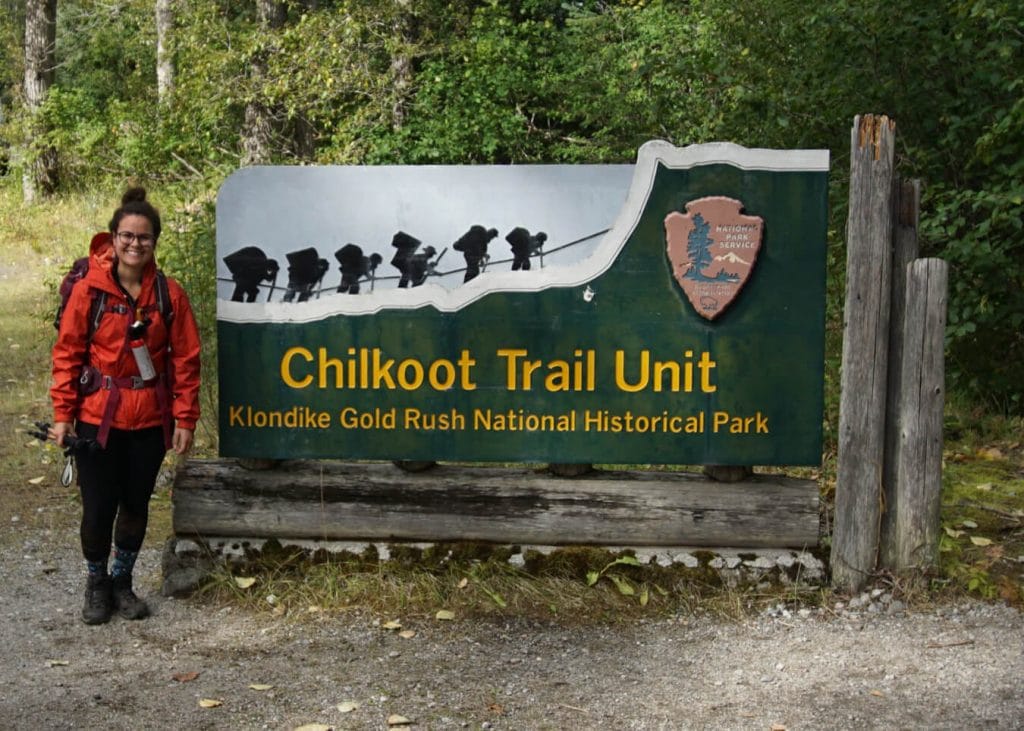
3. Bomber Traverse
Distance: 32 to 50 miles one-way Time: 3 to 5 days Difficulty: Difficult
The Bomber Traverse is a hut-to-hut backpacking trail in Hatcher Pass. This trail includes steep, loose boulder and scree slopes, and glaciers.
Part of the backpacking trail is established and the other part is not. Experienced hikers should be confident in bouldering, glacier crossings, and route finding.
In order to stay in the huts, you must be a member of the Mountaineering Club of Alaska .
How to get to Bomber Traverse:
You can start this trail from either the Reed Lakes or Gold Mint Trail parking areas. Depending on where you start the hike, you should leave another vehicle at the other parking area where you will end your hike.

4. K’esugi Ridge Trail
Distance: 29 miles one-way Time: 3 days Elevation Gain: 2,000 feet Difficulty: Moderate
K’esugi Ridge Trail is the best backpacking trail in Denali State Park. You will traverse miles of rolling alpine terrain with epic views of Denali.
This trail is best hiked between late June and mid-September. It’s also best to hike the trail from the north end at Little Coal Creek to the south end at Byers Lake Trailhead as the northern end of the trail is higher at 3,550 feet elevation.
How to get to K’esugi Ridge Trail in Denali State Park:
From Anchorage, head north on the Glenn Highway. Follow the Glenn Highway until Mile Post 163.9. Turn right towards the Little Coal Creek Trailhead parking lot.
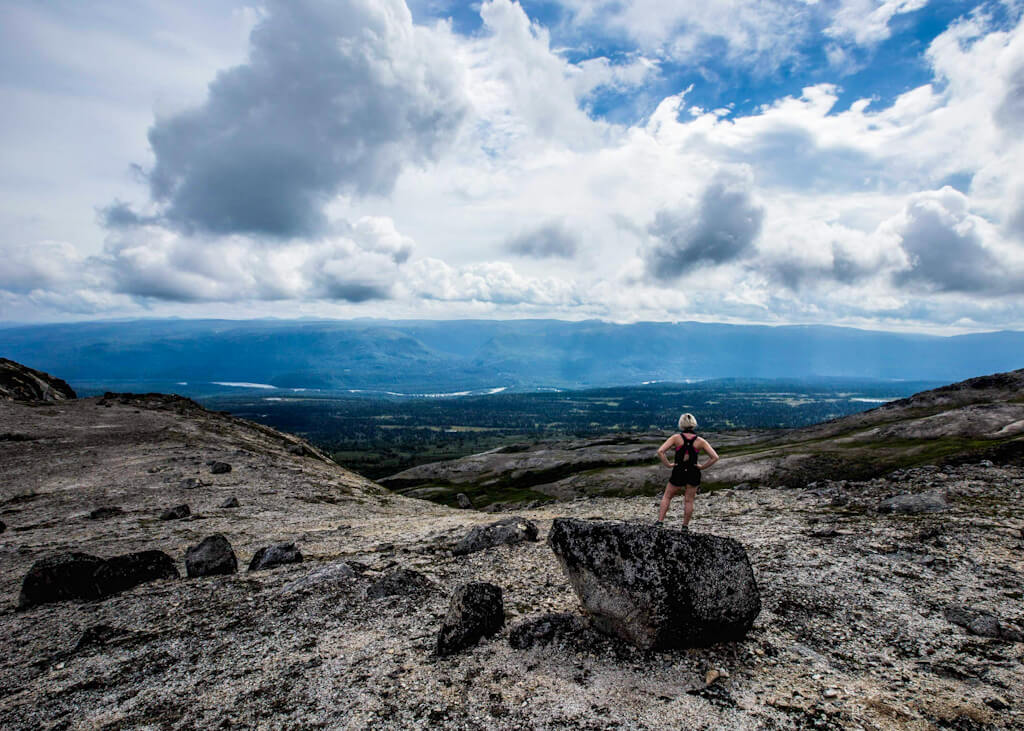
5. Crow Pass Trail
Distance: 23.1 miles one-way Time: 2 days Elevation Gain: 2,100 feet Difficulty: Difficult
Crow Pass Trail is one of the most scenic and diverse trails in the Chugach Mountains . Crow Pass is best hiked from Girdwood to Eagle River because after the initial climb, it’s basically all downhill from there.
You’ll find a bit of everything on this trail including, glaciers, waterfalls, gorgers, valley views, and wildlife sightings, which definitely makes this one of the best Alaska backpacking trips.
Even though the mileage is shorter than other backpacking trails in Alaska , the river crossings and rope and ladder obstacles make this a difficult trip.
Crow Pass is one of the closest established backpacking trails near Anchorage, Alaska.
How to get to Crow Pass Trail in Girdwood:
From the Alyeska Highway, turn left onto Crow Creek Road. Crow Creek Road turns slightly left and becomes Pack Trail. You will find parking for Crow Pass Trail at the end of the road.
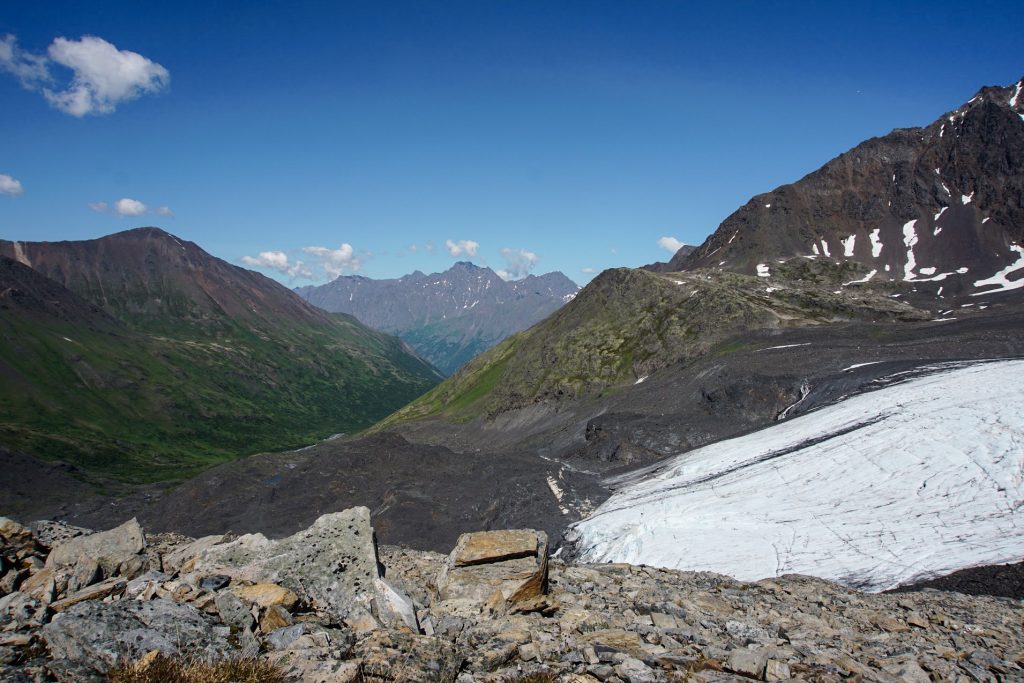
6. Johnson Pass Trail
Distance: 23 miles one-way Time: 2 days Elevation Gain: 1,000 feet Difficulty: Moderate
Johnson Pass Trail is a 23-mile well-maintained trail on the Kenai Peninsula. The views along the trail are incredible. From mountain vistas and bridge crossings to lakes and waterfalls, this trail has it all.
You’ll find designated campsites along the trail that have storage lockers and backcountry toilets. Keep in mind that this trail can get muddy, very overgrown, and mosquito heavy.
Johnson Pass is also a very popular mountain biking trail in Alaska and I think it’s a great way to complete this trail.
How to get to Johnson Pass Trail From Anchorage:
From Anchorage, head south on the Seward Highway. Follow the Seward Highway for 63 miles until you reach the Johnson Pass Trail North parking area.
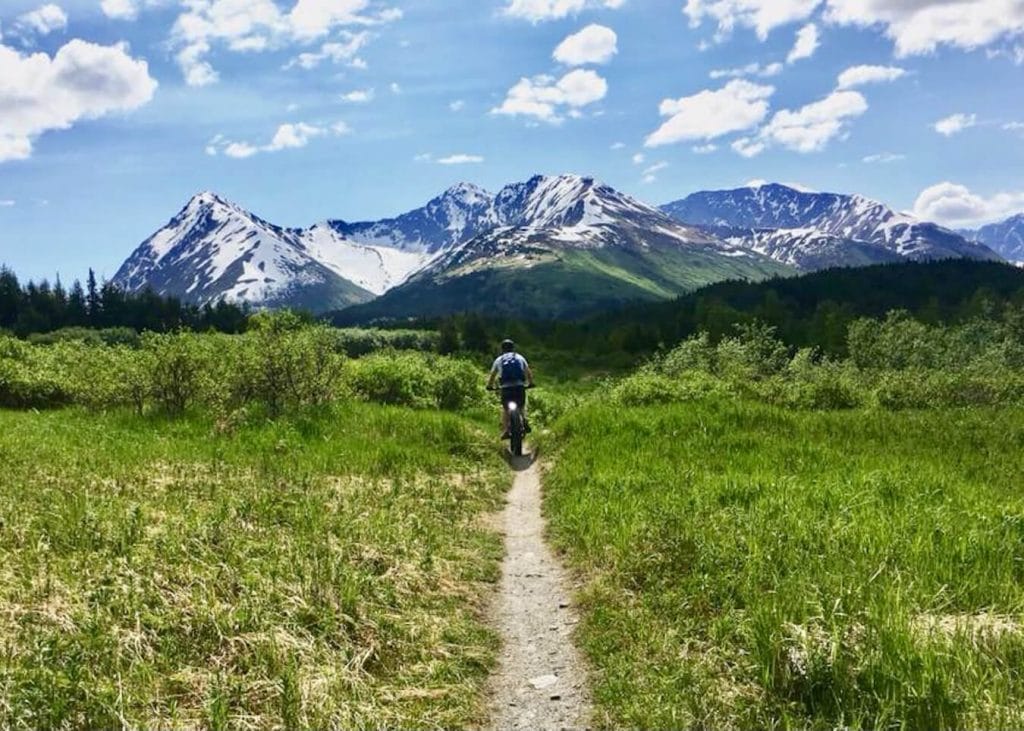
7. Russian Lakes Trail
Distance: 21.8 miles one-way Time: 2 days Elevation Gain: 1,100 feet Difficulty: Easy
Russian Lakes Trail is a hut-to-hut backpacking trail near Cooper Landing. This trail has 3 public use cabins and 7 designated campsites.
Highlights along the trail include Russian River Falls, Lower Russian Lake, and Upper Russian Lake.
I will mention that this trail is very bear-y! I’ve never seen so much bear scat on a trail in my entire outdoorsy life in Alaska.
On top of that, the trail can be very overgrown, which makes it super intimidating.
How to get to Russian Lakes Trail from Anchorage:
From Anchorage, head south on the Seward Highway and continue for 87 miles. Take a slight right onto the Sterling Highway. Continue for 15 miles through Cooper Landing. Turn left onto Russian River Campground Road. Follow for one mile until you reach the trailhead parking.
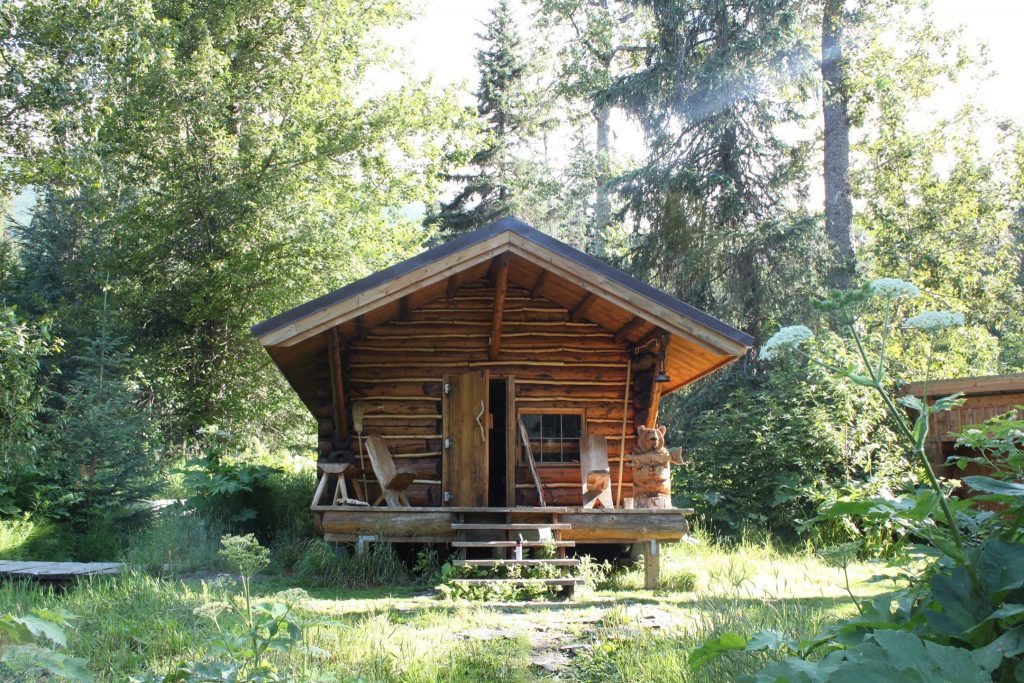
8. Lost Lake Trail
Distance: 16 miles one-way Time: 2 days Elevation Gain: 2,000 feet Difficulty: Moderate
Lost Lake Trail near Seward is an incredibly scenic route, especially on a bluebird day. The trail follows an alpine ridge full of lakes and vistas. You can either start from the Lost Lake side or the Primrose side.
You’ll start off in the rainforest and gradually climb above the treeline to open landscapes. You can see everything from lakes and waterfalls to glaciers.
Lost Lake Trail is another popular mountain biking trail in Alaska (bike northbound). It’s best used from June to September but you should check conditions because the trail may still be covered in snow.
How to get to Lost Lake Trail in Seward:
From Anchorage, head south on the Seward Highway and stay left towards Seward. Turn right onto Scott Way which turns into Rough Drive. Turn left onto Heather Lee Lane. Turn right onto Hayden Lane. Continue to the Lost Lake Trailhead.

Distance: 9 miles one-way Time: 2 days Elevation Gain: 3,100 feet Difficulty: Moderate
Although it’s the shortest thru-hike in Alaska, Grace Ridge Trail is one of my favorites. It’s easy enough to complete this trail in one day but there are some amazing ways to turn your day hike into an overnight adventure.
The main reason I love this trail is because of the epic views. You’ll be rewarded with 360-degree summit views of the surrounding mountains, fjords, and islands in Kachemak Bay.
The location of this hiking trail is also a treat. You can only access the trail by taking a water taxi from Homer, which is a really fun change.
Read the full trail guide: Hike Grace Ridge Trail in Kachemak Bay
How to get to Grace Ridge Trail from Homer:
The only way to get to Grace Ridge from Homer is by water taxi. Two companies on the Homer Spit that offer roundtrip services to Grace Ridge: Coldwater Alaska and Mako’s Water Taxi .

Happy backpacking!
Other Thru Hikes in Alaska
Other thru-hikes you can find around Alaska are Ship Creek to Indian Valley , Crescent Lake to Carter Lake , Seven Pass Route in Wrangell St. Elias National Park, and Mt. Eielson Loop in Denali National Park, which is one of the only established backpacking loop trails in Alaska.
Answering Your Questions
What is a thru hike.
A thru hike means to hike an established end-to-end or long-distance trail heading in one direction.
What is the longest hiking trail in Alaska?
Currently, the longest established hiking trail in Alaska is Resurrection Pass Trail. This trail is 39 miles long.
The Southern Trek of the Iditarod National Historic Trail (INHT) would be the longest but it’s only partially completed at 120 miles.
There is also a proposal to build a 500-mile trail from Seward to Fairbanks called the Alaska Long Trail .
What do you need for a 4 day backpacking trip?
If you are planning a 4 day backpacking trip, you will need the right backpacking gear. Check out my 4 day backpacking checklist to get started.
Do I need bear spray in Alaska?
Yes, you will need to carry bear spray in Alaska. There are bears everywhere and it’s best to be prepared.
Backpacking Resurrection Pass Trail in Alaska
4 Day Backpacking Checklist
Everything I Ate Backpacking
Alaska Travel Guide
Pin For Later
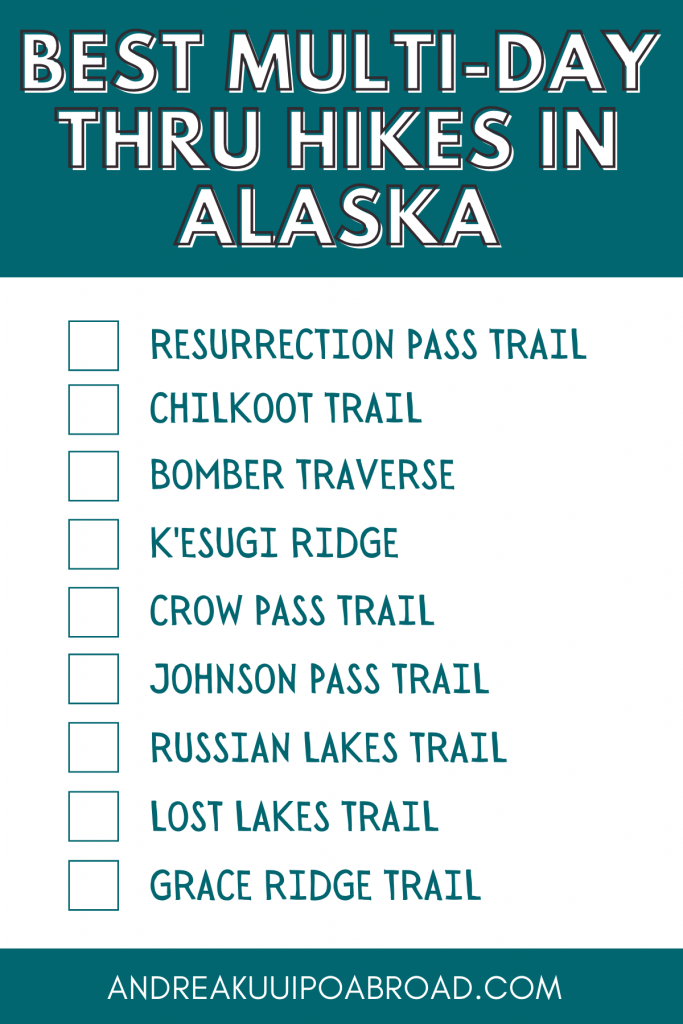
Do you have any questions about the best Alaska backpacking trips? Leave them in the comments.

About Andrea Kuuipo
I was born and raised in Anchorage and have been able to travel to many places around Alaska. As an Alaska Travel Blogger, I love sharing my favorite things to see and do in my home state to help others plan an incredible trip!
Leave a Comment Cancel reply
This site uses Akismet to reduce spam. Learn how your comment data is processed .
- Adventures Hiking Appalachian Trail Camino de Santiago Dolomites Grand Canyon Machu Picchu Mont Blanc New Zealand Patagonia Switzerland Mountain Biking Croatia European Alps France Cycling Cuba Italy Japan New Zealand Tuscany Backcountry Skiing British Columbia European Alps Japan Norway Rock Climbing California Colorado Kalymnos Sardinia Utah More Activities Avalanche Education Ice Climbing Kayaking Kiteboarding Mountaineering Sailing Surfing Trail Running
The 7 Best Trails for Backpacking and Hiking in Alaska

Alaska is massive. At more than 660,000 square miles, it’s nearly one-third the size of the contiguous 48 states. It accounts for two-thirds of the country’s national parklands, about 80% of wildlife refuges and is home to the two largest national forests. I was fortunate enough to spend nearly four years here. That’s not nearly enough time to see it all, but it gave me a pretty good idea of what the 49 th state has to offer. I’m happy to be able to share some of the best trails for hiking in Alaska!

A brief overview of Alaska: the Last Frontier for hiking
Outside of hiking in San Diego or exploring the wondrous trails of Colorado , few other places offer such a diverse setting as Alaska. In the remote corners of the north lies the Arctic tundra. Transitional and boreal forests spread across the state’s south central and interior area.
The southeast is the wild kingdom of fjords and old-growth temperate rainforests. Kayaking through Prince William Sound lets you see the tidewater glaciers descend right into the water, and with the relatively low tree lines, you can even enjoy alpine hiking without gaining too much elevation.
Why hiking and backpacking is the best way to see Alaska
Alaska might seem like a place only for the daring. While opportunities abound for backcountry wilderness adventure, you can also find easy day hikes on well-prepared trails. With hundreds of options at your disposal and plenty more treasures off the beaten beath, every kind of hiker, regardless of fitness level, gear, and experience, can find a way to enjoy these stellar hiking tours .

If you’re planning a visit to the largest state and one of the best hiking destinations in US, whose adventures rival even the best hikes in Washington , be sure to set aside enough time to explore parts of the Last Frontier you won’t see from a tour bus or cruise ship.
1. Chilkoot Trail, Skagway
Starting in the coastal lowlands near Skagway and ending at the shores of Bennett Lake in British Columbia, the Chilkoot Trail follows the route of the 1897-1899 Klondike Gold Rush. The only long-distance traverse in southeast Alaska, the trail passes through a coastal rainforest, high-mountain basins, and alpine terrain with views above treeline.

Along the way, you’ll see relics from the gold-rush era when prospectors had to ferry a year’s worth of provisions across the pass. You’ll need camping gear and food for a few days for this Skagway hike, along with warm layers and rain-appropriate clothes. The weather can change in a snap. There are designated places to camp with separate cook shelters and caches to keep your food safe from bears.
What to expect on the popular multi-day Skagway trail
This is one of the most regulated trails in Alaska. You’ll need to secure a permit (a certain amount is set aside each day for walk-ins, but most are for reservations). Chilkoot Trail also crosses an international boundary, so you’ll want to be up to date on the current requirements for checking in with either Canadian or U.S. customs, depending on which direction you go. The trail is also rather popular. Despite the permit requirements, you’re not likely to have it to yourself, especially during peak season. On the other hand, it’s a wonderful opportunity to meet fellow hikers from around the world.

Chilkoot Trail, Skagway - Good to Know
Developed trail with some boulder hopping
3-5 days for trekking the full distance
South end: 9 miles from downtown Skagway; North end: Lake Bennet train station (not accessible by road) or Log Cabin on the Klondike Highway 5 miles past the Canadian Customs station.
Late June to mid-September
Consider taking the White Pass and Yukon Route Railway between Skagway and the northern end of the trail
Plan your visit with info from the National Parks Service and Parks Canada
2. Exit Glacier/Harding Icefield, Seward
The Exit Glacier and Harding Icefield hikes give adventurers of all ability (and ambition) a few different choices to see one of Alaska’s most easily-reached glaciers. You’ll also get to experience the Kenai Fjords National Park. The two trails also share a trailhead at the Exit Glacier Nature Center. The Glacier View Loop trail is a fully accessible, paved trail featuring views of the glacier’s face and outwash plain. The short Edge of the Glacier overlook trail features steps to help negotiate a brief climb to a vantage point above the foot of the glacier. It’s a brilliant opportunity to see how a forest develops as a glacier recedes. Signposts along the access road and the trail show just how far the ice used to extend.
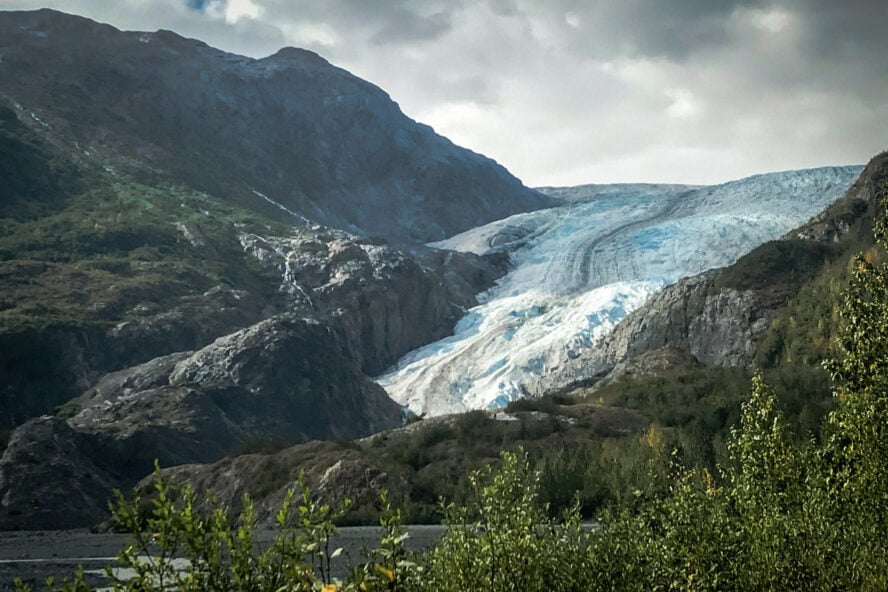
Head to Harding Icefield for views of surrounding peaks and fjords
If you’re an ambitious hiker, you can make a day out of it and follow the switchbacks up to Harding Icefield . This 500-square-mile frozen mass feeds almost three dozen glaciers, including Exit. The trail is well developed but steep with nearly 3,000 feet of elevation gain. After climbing above the forest and through the low brush and alpine meadows, the trail gets rocky. The view out over the expanse of ice and the jagged gray peaks surrounding it is worth the effort – even if it’s cloudy like it was for our visit.

Exit Glacier/Harding Icefield, Seward - Good to Know
Exit Glacier – choice of trails up to 1 mile long; Harding Icefield – 4 miles one way
Exit Glacier – easy; Harding Icefield – strenuous
Accessible/developed trail with some rocky sections near the icefield
Up to 4 hours, depending on fitness level
11 miles from downtown Seward in Kenai Fjords National Park
May to September
Seward is also a great place to take a sightseeing cruise or sea-fishing charter
Plan your visit to Exit Glacier
Plan your visit to Harding Icefield
3. Reed Lakes, Anchorage/Wasilla
The Reed Lakes Trail is one of the most popular trails in the Hatcher Pass Management Area, and possibly one of the most popular hiking trails in Anchorage. The trail gives you a sample of interior Alaska hiking terrain only 1.5 hours from Anchorage (and even closer to Palmer and Wasilla). I tried to visit as many different trails as I could when I lived in the state, but this is one of the few I made a point to visit again.
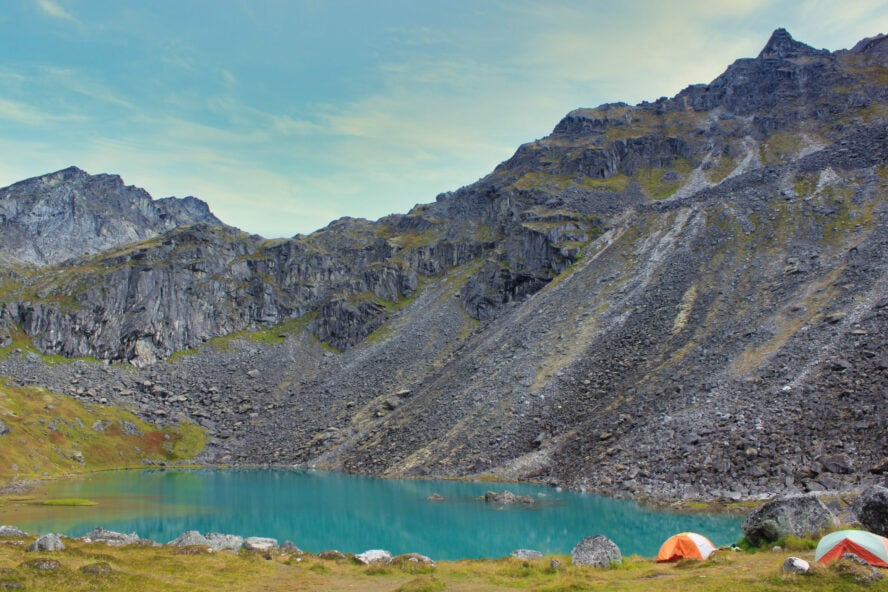
Reed Lakes trail starts relatively flat and clearly defined for the first 1.5 miles or so. As the climb begins to get steeper, the trail gets more rugged. You’ll encounter a couple of stretches of boulder travel that would be a challenge for smaller children and some dogs. If you’re like me, though, you’ll think it’s all worth it when you catch sight of the lower lake glowing like a turquoise jewel. The meadows around the lower lake are also popular for camping, which often leads to unexpected crowds, evoking the best Joshua Tree hikes .
Hike to Upper Reed Lake to see an abandoned plane wreckage
The trail continues, passing cascading waterfalls that feed the lower lake from the upper one. If it’s early enough in the day, and you can manage the steep ascent through rock and scree, you can continue up past the upper lake. Here you’ll find the wreckage of an Air Force bomber that crashed in the 1950s on aptly-named Bomber Glacier. Some people make this Anchorage hiking trail part of a multi-day traverse that includes the Gold Mint Trail the next valley over. This involves stretches of ice travel that should only be attempted by people with the proper training and equipment.
When I lived in Anchorage, Hatcher Pass was one of my favorite places to go. And Reed Lakes was one of my favorite parts of Hatcher Pass.

Reed Lakes, Anchorage/Wasilla - Good to Know
3 miles to Lower Reed Lake, 4 miles to Upper Reed Lake
Moderate, with some boulder hopping
Forest, brush, alpine meadows and lakefront
Archangel Road, Hatcher Pass (19 miles from Palmer, 60 miles from Anchorage)
June to September
Nearby Independence Mine State Historical Park offers a fascinating and photogenic look at the area’s past with grooming for Nordic skiing in the winter.
Plan your visit to Reed Lakes/Hatcher Pass
4. West Glacier Trail, Juneau
If you want to get close to a glacier but can’t fit Seward into your itinerary, Mendenhall Glacier is practically in Juneau’s backyard. The trailhead is minutes away from downtown’s cruise ship terminals, the airport and the state ferry dock. There’s even a city bus stop a mile from the trailhead!
This Juneau hiking trail starts well-defined and not particularly steep with only 250 feet of elevation gain in the one mile it takes to get to the first overlook. Here, you get a beautiful view of the glacier and lake at its base, as well as Nugget Creek Falls on the far side. The first section of the trail is an excellent option for those short on time or not interested in the steeper climb later on.

Continue hiking to take in views of Mendenhall Glacier
If you keep following the West Glacier Trail path, you’ll eventually climb out of the young forest and find yourself following cairns across bare rock. After cresting a rock shoulder, you come right to the edge of the glacier. When we did this Juneau hiking trip, the air noticeably cooled as we neared the ice. We appreciated the temperature dip as it was a warm afternoon for late May!
You can get right up to the ice and take in the varying shades of white and blue. Keep in mind, extended travel on the glacier is for those with the proper experience (or guides!) and equipment. Commercial outfits in Juneau offer guided glacier explorations and even the chance to explore ice caves within the glacier!
This hike is worth the trek to the top for the incredible views of the Mendenhall Glacier — a seemingly endless ocean of vibrant blue ice.

West Glacier Trail, Juneau - Good to Know
3.4 miles one way
Moderate (mainly due to the incline at the end)
Developed trail through forest brush, then bare rock
4-6 hours round trip
About 1 mile from Mendenhall Loop Road and Montana Creek Road, just past the Mendenhall Campgrounds
Mid-May through September
There are shorter and easier hikes on the east side of the lake near the national forest visitor’s center. They also offer a view of the glacier, but don’t get as close to it.
Plan your visit to West Glacier Trail
5. Deer Mountain, Ketchikan
Deer Mountain is a popular Ketchikan hiking trail for locals but not as well known outside Alaska as the Chilkoot Trail. Although it lacks Chilkoot’s historical legacy, the Deer Mountain Trail offers fantastic views of the islands, fjords, and channels that make up southeast Alaska. Like many of Alaska’s trails, you’ll get to experience forests, climb through meadows and alpine basins, and hike past mountains that hold snow well into the summer.

Traverse Deer Mountain trail for a variety of views and alpine
The Deer Mountain Trail starts steep shortly after leaving the parking area. You happen upon viewpoints at both the one- and two-mile marks. At 2.5 miles, a short spur runs up to the top of Deer Mountain itself. The main trail continues past a shelter available for camping on a first-come, first-served basis. You can also take shelter at Blue Lake, and the basin between Mahoney and John Mountains is suitable for tent camping. You can also find plenty of water along the way, as long as you filter or treat it first.
If you traverse the entirety of this Ketchikan hiking tour, you’ll be crossing the mountainous spine of Revillagigedo Island. Here winter comes early and stays late. You might want to consider having an ice ax with you, even in the summer. If the weather or snow conditions seem questionable, play it safe and turn back at Blue Lake
No other trail in this region offers such dramatic views of surrounding islands, the ‘First City’ itself, and alpine lakes, than Deer Mountain.

Deer Mountain, Ketchikan - Good to Know
2.5 miles to Deer Mountain, 4.5 miles to Blue Lake, 12.5 miles for the full traverse
Developed trail as far as Deer Mountain, then rough alpine footpath
Half day to Deer Mountain; long day hike to Blue Lake; usually 2-3 days for the full traverse
1 mile southeast of downtown Ketchikan. Start on Steadman Street and follow the signs.
June through September
This is one of the wettest areas in Southeastern Alaska. Even if it’s sunny when you start, make sure you take rain gear!
Plan your Deer Mountain hike
6. Eielson Alpine Trail, Denali National Park
Spanning a staggering 6-million acres, Denali National Park and Preserve offers an entire world of hiking opportunities all by itself. You won’t follow many established trails, though, which is a conscious decision by park management to preserve as much wilderness for visitors as possible. For many who enjoy backpacking in Denali , this is the biggest draw.
Fortunately, however, for those who aren’t quite ready for route finding and unprepared surfaces, you can explore a handful of Denali hiking trails marked for ease of use, like the beautiful area around Savage River . Most are near the park entrance, but you can find a few marked trails farther inside the park.
Getting deeper into the park requires riding one of the busses. Limited vehicle traffic is also part of the effort to minimize human impact.

Hike the steep face of Thoro Ridge to gain impressive views of Denali
By the time you reach the Eielson Visitor’s Center, you might be ready to stretch your legs a bit, and the Eielson Alpine Trail will do the trick! Even when clouds obscure Denali itself – which was the case for us – the view across the valleys to the west is panoramic.
It’s a short but steep trail, climbing the ridge across the Park Road from the Visitor’s Center in a series of switchbacks. When we embarked on our Denali National Park hiking trip , marmots seemed quite fascinated with watching humans make their way up and quite happy to pose for pictures. The ridge is broad where the trail reaches the top, and you can easily walk a bit west and take in the expansive valley to the north. This view of Mount Galen and the distant hills is completely hidden from those who never stray from the busses.
Most people return the way they came, though you could continue west and descend back to the highway about a mile or so west of the Visitor’s Center. More ambitious hikers could head east and make the steep trek up 5,629-foot to Thoro Peak. You won’t regret taking more time for hiking in Denali .
Even when clouds obscure Denali itself – which was the case for us – the view across the valleys to the west is panoramic.

Eielson Alpine Trail, Denali National Park - Good to Know
1.75 miles round trip
Moderate (steep)
Developed trail through low brush and alpine meadow
Across the Park Road from Eielson Visitor Center, about 4 hours from the entrance
June through mid-September
Leave time to enjoy the Visitor Center and some of the other short trails; off-trail hiking is also welcome
Get started at the Eielson Visitor Center and plan your hike from there
Hiking in Denali National Park
7. Flattop Mountain, Anchorage
Flattop was one of the first hikes I did after moving to Anchorage. The Glen Alps Trailhead is right at the edge of town and easy to reach. You could even take a taxi or Uber if you happen to be in town without a rental car. Flattop Trail is short enough to enjoy time in nature without investing an entire day. The views of the water, mountains, and skyline are more than worth the minimal effort to reach this Anchorage hiking trail. On a clear day, you can even see Denali in the distance, where adventurers are probably attempting the West Buttress climb .
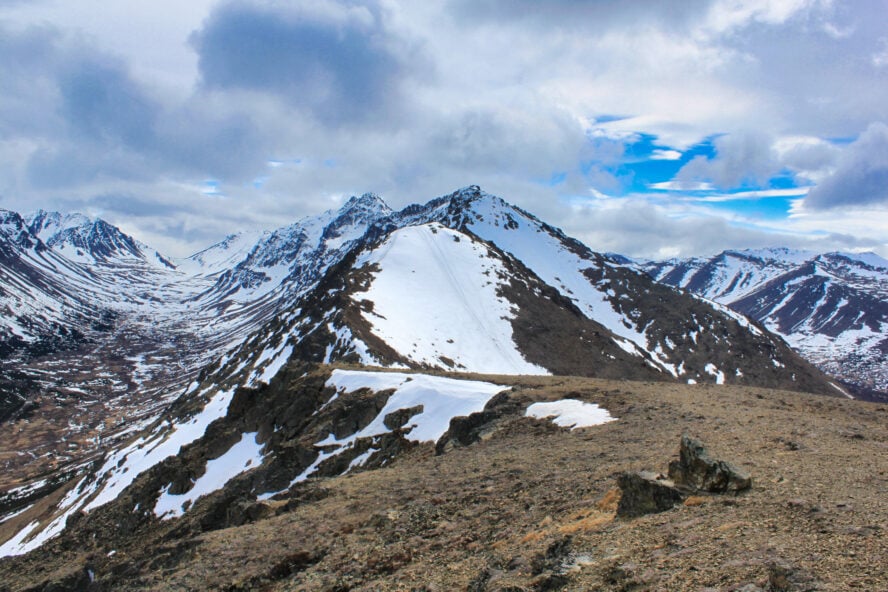
Climbing the popular but worthwhile Flattop Trail
The Flattop trail is a well developed and easy to follow Anchorage hike. Most of the hike is relatively easy, aside from a steep final pitch that’ll get your heart rate up. The last climb is on a north-facing aspect and can retain snow well into summer, which can make things slippery. When I went on a late May afternoon, I found hard-packed steps in the snow left by an endless stream of previous hikers. The top is a broad flat expanse (hence the name) where you can also camp overnight. Flattop is also the site of an annual summer solstice celebration where hikers get to take advantage of almost 20 hours of daylight.
Hikers with an appetite for more hikes near Anchorage can follow the ridge to the southeast to bag two more peaks. Here you’ll find the less creatively named Peak 2 and Peak 3 in the front range of the Chugach mountains.
Flattop trail is short enough to enjoy time in nature without investing an entire day. The views of the water, mountains, and skyline are more than worth the minimal effort.

Flattop Mountain, Anchorage - Good to Know
1.7 miles one way
Developed and well-marked trail
Glen Alps Trailhead in south Anchorage
May through September
Blueberry Loop offers a shorter hike without the climb at the end; on the north side of the trailhead parking lot an accessible paved trail provides a panoramic viewpoint for those who don’t want – or can’t – hike to the mountain
Plan your Flattop hike
8. My Advice for Planning Your Alaska Hiking or Backpacking Trip
When is the best time to hike in alaska.
Alaskans, or at least some that work in outdoor equipment stores, offer similar logic as fellow locals in cold, damp climates: There’s no such thing as bad weather, only poor preparation. Even though you could explore many of the trails listed here in snowshoes in the wintertime, most people will prefer to hike them in the summer. Daylight lasts longer in the summer, so you won’t get caught in the dark and many of these areas are prone to avalanche with winter snows.
Because of the latitude and elevations involved, you might still encounter snow on some of these trails as late as June or July. It’s never a bad idea to check on conditions for each location before setting out.
Permits and fees
Fees involved vary depending on the agency managing the trail. Chilkoot Trail is the only Alaska hiking trail I feature in this article that requires a permit. You can visit the rest by paying modest parking or park entrance fees. Some even offer free entry!
Overnight camping rules
Rules for camping also vary depending on the agency, so it’s best to check ahead if you think your trip might involve overnight camping. National parks tend to have more restrictions. Chilkoot Trail only allows camping at designated spots, and Denali has regulations governing how far from the road to make camp. State-managed lands tend to be more permissive. You can pitch your tent right on top of Flattop, for example.
Safety tips for encountering wildlife while hiking
Alaska isn’t necessarily a dangerous place to explore, but backpack through the remote corners of Denali or take a tour of Lake Clark National Park and you’ll immediately understand how wild vast portions of it are. This is all bear country. If you’re in a wooded area where you can’t see very far ahead, make noise to prevent any surprise encounters. Consider hiking in a group, which deters aggressive bears, and carrying bear spray—just make sure you know how to use it safely.
Also, be prepared to encounter moose along the trail. They are known to be aggressive, and a mother moose with calves to protect is the most dangerous. Despite their beauty, they’re best viewed from a distance and aren’t tolerable of close-up photo ops. If you find one enjoying lunch in the middle of the trail (which happened to me!), it’s best to turn back or wait for the animal to go on about its business. Again, be aware and cautious when it comes to wildlife on the trail.
Do your research or hire a guide before hiking in Alaska
Alaska’s rough terrain can pose its own risk, so if you’re not accustomed to the outdoors, make sure to check out our essential tips for beginner hikers . Many of these trails involve stretches of bare rock, which can be slippery during and after rain. Boots with good tread are in order and trekking poles can help you keep your balance. Pack for weather events and bring a GPS, especially if you’re headed into remote areas. And regardless of the terrain or weather, make sure someone knows where you’re going and when you expect to be back.
Check out some other National Parks hikes
Looking to cross some more big names off your bucket list? Try the best hikes in Yellowstone for geothermal wonders and extraordinary wildlife. The best hikes in Grand Teton will have you exploring the largest intact ecosystem in the Lower 48, while the hikes in Yosemite promise larger-than-life adventures among granite monoliths, towering sequoias, and waterfall-filled valleys.
About the author
Karl is an adventurer and outdoor enthusiast living in the Pacific Northwest, where he enjoys alpine skiing, hiking, road biking, and camping. He’s been skiing for more than 35 years, mainly in the Cascades, Sierra Nevada, and Alaska. He’s camped under Alaska’s midnight sun, toured Washington’s San Juan Islands on bicycle, and his hiking adventures have taken him from the foothills of Denali and the glaciers of Alaska to Mount Adams in the Cascades and the high deserts of the Great Basin.
Related articles

Choose a currency
- USD - $ US Dollar
- EUR - € Euro
- AUD - AU$ Australian Dollar
- CAD - CA$ Canadian Dollar
- GBP - £ British Pound Sterling
- CHF - CHF Swiss Franc
- JPY - ¥ Japanese Yen
- SGD - S$ Singapore Dollar
- HKD - HK$ Hong Kong Dollar
- DKK - Dkr Danish Krone
- NOK - Nkr Norwegian Krone
- SEK - Skr Swedish Krona
CELL COVERAGE LAYER
See where you can dial 911 and scope out data for (really) remote work with Gaia GPS.
BEST WEEK EVER
Try out unlimited access with 7 days of Outside+ for free.
Start Your Free Trial
Powered by Outside
Best Backpacking In Alaska
Our comprehensive guide to the best backpacking you can find in alaska..
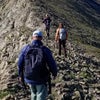
- Share on Facebook
- Share on Reddit
Heading out the door? Read this article on the new Outside+ app available now on iOS devices for members! >","name":"in-content-cta","type":"link"}}'>Download the app .
Denali National Park and Preserve
“The” mountain. To those who have hiked or dream of hiking in Alaska’s 6-million-acre Denali National Park, 20,320-foot Mt. McKinley is “the” mountain. Though the park boasts many wonders-wolves, grizzlies, 430 species of flowering plants, glaciers, tundra-the mountain will most capture your imagination. The hiking opportunities are endless but the backcountry permit system can be complicated. Do your homework, apply early, and be open to options.
Contact: Denali National Park and Preserve, (907) 683-2294; www.nps.gov/dena .
Chilkoot Trail
Once known as “the meanest 33 miles in history,” the Chilkoot Trail remains a tough hike and a walk back in time. Look for Gold Rush relics along the trail and gold nuggets in the creeks. Or find your own treasure among the craggy mountain peaks and endless waterfalls.
Contact: Klondike Gold Rush National Historical Park, (907) 983-2921; www.nps.gov/klgo .
Chugach National Forest
Often overshadowed by its larger and more controversial cousin, Tongass National Forest, the 5.6-million-acre Chugach is 98 percent roadless and just as wild. Migrate there during spring with millions of shorebirds by walking the 70-mile Resurrection Trail system, or set up a basecamp at one of more than 40 public-use cabins.
Contact: Chugach National Forest, (907) 271-2500; www.fs.fed.us/r10/chugach .
Popular on Backpacker

Join Outside+ to get access to exclusive content, 1,000s of training plans, and more.
© 2024 Outside Interactive, Inc
- United States
- Backpacking
Looking for the best backpacking in Alaska? We've got you covered with the top trails, trips, hiking, backpacking, camping and more around Alaska. The detailed guides, photos, and reviews are all submitted by the Outbound community.
Top Backpacking Spots in and near Alaska

Hike Byron Glacier

Hike Reed Lakes, AK

Hut to Hut Across Alaska's Talkeetna Mountains

Summit Igloo Mountain

Hike to Rabbit Lake & McHugh Peak

Hike the Crow Pass National Historic Trail

Hike to Alaska's Mint Hut

Hike the Gold Mint Trail

Camp at Chugach State Park

Backpack the Mt. Eielson Loop

Backpack the Caines Head Coastal Trail

Backpack to Donoho Basin

Hike to Callisto Canyon Cabin

Backpack Kesugi Ridge

Upper Dewey Lake Trail

Hike Alpine Trail, Caines Head State Recreation Area
Top activities.
- Mountain Biking
- Photography
- Local Adventures
- Tours and trips
- Camping Nearby
- Outbound PRO Membership
- Add your property
Mobile Apps

© 2024 The Outbound Collective - Terms of Use - Privacy Policy

Where will you
Weekend getaways, week-long adventures, gritty expeditions, backpacking in alaska: america's untamed wilderness, endless wilderness meets endless days (or nights, depending on the season) in alaska’s great outdoors, a remote landscape filled with incredible backpacking and hiking trails. glaciers, mountains, fjords, and rainforests await find your next trip with our guide for the best backpacking locations in alaska, organized by weekend getaways, week-long adventures and gritty expeditions., *our information may not always be current and should be used for trip planning / selection purposes only. always call ahead for the most current information before setting out on your trip., weekend getaways.

Caines Head State Recreation Area/ Lowell Point State Recreation Site
Number of Miles of Trail: 14
Group Size Limit: 19
Best For: 1 night
Permit/Reservation: Not required

Hatcher Pass East Management Area
Number of Miles of Trail: 29
Group Size Limit: 10
Best For: 1-3 nights

Shuyak Island State Park
Number of Miles of Trail: 15

Kachemak Bay State Park & Wilderness Park
Number of Miles of Trail: 58
Best For: 1-7 nights

Klondike Gold Rush National Historic Park
Number of Miles of Trail: 33
Group Size Limit: 12
Best For: 1-4 nights
Permit/Reservation: Required

Arctic National Wildlife Refuge
Number of Miles of Trail: 19.6 million acres
Group Size Limit: N/A
Best For: 1-∞ nights
Permit/Reservation: Not required

Chena River State Recreation Area
Number of Miles of Trail: 164
Group Size Limit: 20
Best For: 1-9 nights

Chugach National Forest
Number of Miles of Trail: 500+

Chugach State Park
Number of Miles of Trail: 280+
Best For: 1-10 nights (hard limit)

Denali National Park and Preserve
Number of Miles of Trail: 6 million acres
Group Size Limit: 6
Best For: 1-30 nights (hard limit)

Denali State Park
Number of Miles of Trail: 74
Best For: 1-10 nights

Glacier Bay National Park and Preserve
Number of Miles of Trail: 3.3 million acres
Permit/Reservation: Required

Kanuti National Wildlife Refuge
Number of Miles of Trail: 1.6 million acres

Katmai National Park and Preserve
Number of Miles of Trail: 4 million acres
Best For: 1-13 nights (hard limit)

Kenai National Wildlife Refuge
Number of Miles of Trail: 110+

Kobuk Valley National Park
Number of Miles of Trail: 1.75 million acres
Group Size Limit: 11

Lake Clark National Park and Preserve
Number of Miles of Trail: 4 million acres

Togiak National Wildlife Refuge
Number of Miles of Trail: 4.3 million acres

Tongass National Forest
Number of Miles of Trail: 700+

Wrangell-St. Elias National Park and Preserve
Number of Miles of Trail: 13
million acres
Group Size Limit: 8
Don't see your favorite place? Found an error on the site? Let us know and help backpackers everywhere!
10 of the best hiking routes in Alaska
Jun 5, 2024 • 7 min read

From casual strolls to strenuous scrambles and climbs, here's our guide to Alaska's best hiking trails © Getty Images/Mint Images RF
Perhaps no other US location has the diversity of Alaska when it comes to hiking.
From casual strolls to hardcore alpine scrambling, the state proves itself over and over again as a destination of choice for trekkers. Those seeking solitude should venture out of the main city centers and tackle trails not usually traveled by the casual Alaska visitor. Staff at one of four public lands information centers in Anchorage , Fairbanks , Tok, and Ketchikan can assist hiking enthusiasts with all the details related to trails, permits and safety, and provide insight into transportation to remote locations.
Many of Alaska’s trails are also directly connected to its rich culture and history as well, offering a bonus for hikers through interpretive displays or guided opportunities to become more familiar with the largest state in the US. From wandering a national park trail lined with traditional totem poles to witnessing the retreat of an ancient glacier, hiking here means a real-time education into the cultural and environmental aspects that make each region unique. From casual strolls to strenuous scrambles and climbs, here's our guide to Alaska's best hiking trails.

1. Sitka National Historical Park, Sitka
Best short walk 1 mile (1.6km), easy
Located within walking distance of downtown Sitka, this park’s lush rainforests combine with 20 totem poles for a lovely walk of cultural history in Southeast Alaska. The site of a bitter battle between local Tlingit and the Russian army in 1804, interpretive signs tell the story while preserving the valuable traditions of local tribes for generations to come.
2. Trail of Blue Ice, Portage
Best accessible trail 5 miles one way (8km), easy
Located between Anchorage and the seaside village of Whittier, the Trail of Blue Ice is the result of an amazing effort by the US Forest Service to introduce visitors to the many glaciers of Southcentral Alaska’s Portage Valley. This fully-accessible trail features interpretive signs explaining the glacial valley and surrounding mountains, and the abundant flora and fauna of this popular isthmus of land. Start at Moose Flats on the western end and hike east, or start at the Begich, Boggs Visitor Center along the shores of Portage Lake and hike west. Watch for salmon in Williwaw Creek during July and August, and keep an eye out for bears at all times.

3. K’esugi Ken Complex trails, Denali State Park
Hiking trail with the best campground 2 mile loop (3.2km), easy
This shining star of the Alaska State Park system features a large campground , public use cabins, and expansive day use pavilion that all connect to a looping interpretive trail that offers spectacular views of Denali on clear days. It’s a perfect place to wander and admire the scenery and educational signage that explains the history, flora and fauna, and Alaska native cultures of the area. Bonus: It’s a delightful family-friendly stop as well.
Want to know more about Denali? Here's our guide for first-timers
4. Creamer’s Field Migratory Waterfowl Refuge, Fairbanks
Best trail for bird-watching 1–3 miles (1.6–5km), easy
Wandering Creamer’s Field means admiring this former dairy farm’s barns and outbuildings and spotting a plethora of birds coming and going nearly every time of year. A highlight is the August migration of the Sandhill crane, a leggy bird that spends winters in southern states but uses the fields of Creamer’s to rest and feed before flying in huge numbers across the Alaska skies. The Boreal Forest, Farm Road and Seasonal Wetland trails are all connected and flat, and naturalist walks are often conducted to better acquaint visitors with the area wildlife.

5. East Glacier Trail, Juneau
Best hike for glacier views 2.8 miles out and back (4.5 km), moderate
A visit to Juneau would not be complete without a hike in and around the Mendenhall Glacier area. This loop trail leaves from the visitor center, connects to the Trail of Time route, then leads to a great view of the Mendenhall Glacier. There’s also a side trail route to the A-J Waterfall (another 1.3 miles/2km) where visitors can witness the tumbling water flowing over the rocky ledges. This trail can be busy, so consider going early in the morning or later in the evening. Watch for bears during salmon spawning season (July to August).
Ready to plan your trip to Alaska? Pick the right time of year with our seasonal guide
6. John Hunter Memorial Trail, Valdez
Best hike to a lake 3.8 miles round trip (6km), moderate
Formerly known as the Solomon Gulch Trail, this trail provides an excellent look at the Port of Valdez, where the 800-mile Trans-Alaska Pipeline ends. After a steep initial climb, the trail wanders through a forest and some industrial yards before ending at Solomon Lake and its two dams for hydroelectric power. There's great berry picking during the summer months and you may see bears during salmon spawning season (July to September).
7. Angel Rocks Loop Trail, Fairbanks
Best hike for geology features 3.8 mile loop (6km), moderate
Rockhounds, alert! This popular but usually uncrowded trail is fascinating for its unique outcroppings or tors, formed when molten rocks pushed upward from beneath the earth and cooled before it reached the surface. Subsequent erosion over centuries left these formations in full view, and now they're part of the amazing topography of Interior Alaska. In the summer, wildflowers are abundant and the scent of sage, unusual this far north, dominates the south-facing slopes. Great photo opportunities abound here, but be aware that climbing on the tors is not allowed to preserve both safety and the geology of this area.
Looking for more things to do? Don't miss Alaska's best experiences

8. Jumbo Mine Trail 508, Kennecott (Wrangell-St Elias National Park)
Best trail for fit hikers 5 miles (8km) one way, strenuous
If you’re looking for a combination of Alaska history, scenery and a heart-pumping hike, the climb to Jumbo Mine delivers. Located near the Kennecott Mines National Historic Landmark , the trail is but one of several maintained by the National Park Service to educate visitors about this former copper mill town. This very steep trail winds up switchbacks for 3400ft before reaching the Jumbo Mine site along a rocky former road. Make time to stop along the way to both catch your breath and capture amazing views of the mill townsite, Root Glacier, and the surrounding mountains topped with snow all year. Allow all day for this hike and be sure to carry plenty of food and water.
9. Twin Peaks Trail, Chugiak/Anchorage area
Best route for scramblers and adrenaline junkies 2.6 miles (4.2 km) one way, strenuous
This short, steep trail departs from the shores of Eklutna Lake, a popular state park about 45 minutes northeast of Anchorage. Perfect for hikers using Eklutna Lake campground as a home base, the trail switchbacks nearly the entire length, offering amazing views of the lake the farther one climbs. Dall sheep are often spotted near the top, making the hike a special one, indeed. Want to go farther? Continue along the ridgeline to Pepper Peak for another 4 miles and make an entire day of it.
10. Curry Ridge, Denali State Park
Best multiday backpacking hike 6.5 miles (10.5km) one way, strenuous
The views from upper Curry Ridge are nothing short of spectacular, as are the wild blueberry bushes during the latter part of summer. Departing from the K’esugi Ken Complex near Willow, Curry Ridge trail winds uphill from the K’esugi campground before wandering the alpine areas; it's a great choice for backpackers wanting to spend the night in the shadow of Denali. Carry all water and food, and be aware that weather conditions can change with little notice. Be bear-aware at all times.
Tips for hiking in Alaska
- Be wildlife aware. Bears inhabit every region of Alaska, and often use the same trails as humans. Carry bear spray (and know how to use it), make noise while hiking, travel in groups, and avoid brushy areas along stream and river banks during salmon spawning season, which varies depending on where you are in Alaska, but is broadly June through September.
- Be self sufficient. Few hiking areas have cell service. Carry a first aid kit and extra water, food, and gear to stay safe should an emergency arise.
- Pay the fees in state and national parks. Visit the Public Lands Information Centers for more information.
This article was first published May 13, 2021 and updated Jun 5, 2024.
Explore related stories

Apr 5, 2024 • 6 min read
Washington State’s trio of national parks, Mt Rainier, North Cascades and Olympic never disappoint. Here’s our guide to this trio of treasures.

Jan 19, 2024 • 7 min read

Oct 18, 2023 • 8 min read

Feb 16, 2023 • 6 min read

Sep 28, 2022 • 8 min read
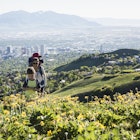
Mar 14, 2022 • 6 min read

Feb 7, 2022 • 5 min read

Jan 31, 2022 • 6 min read

Dec 9, 2021 • 9 min read

Aug 21, 2020 • 8 min read
Alaska Backpacking Trips
Thoroughly curated, meticulously planned, and expertly guided.
Since our humble beginnings in the late 90’s, Alaska Alpine Adventures has been guiding Alaska Backpacking trips across the last frontier. Backpacking continues to be one of our most popular activities, and is one of the best, and certainly most authentic, ways to see the unexplored Alaska. Set yourself on a ridge top and survey the remote majesty of Alaska’s unclimbed peaks, clear streams, verdant tundra, cobalt lakes, and massive glaciers. We have itineraries for experienced backpackers, aspiring mountaineers, and even for those who have never backpacked before. We pioneered many of our award-winning backpacking treks, some of which are now considered Alaska classics!
Seek the challenge and savor the wonder – join us for the Alaska backpacking trek of a lifetime. Most of our Alaska backpacking trips are limited to 8-guests, while our trips into the Arctic National Wildlife Refuge are limited to even fewer at 5-guests. And with a guest to guide ratio of 4:1 paired with a 24-hour emergency response network, you can rest assured that our commitment to risk management and safety-conscious operations is held to high standards.
Backpacking through the most remote wilderness areas of Alaska can be extremely challenging and, at times, humbling. These are just a few of the many reasons why people coming to Alaska to backpack often choose to be guided by us.
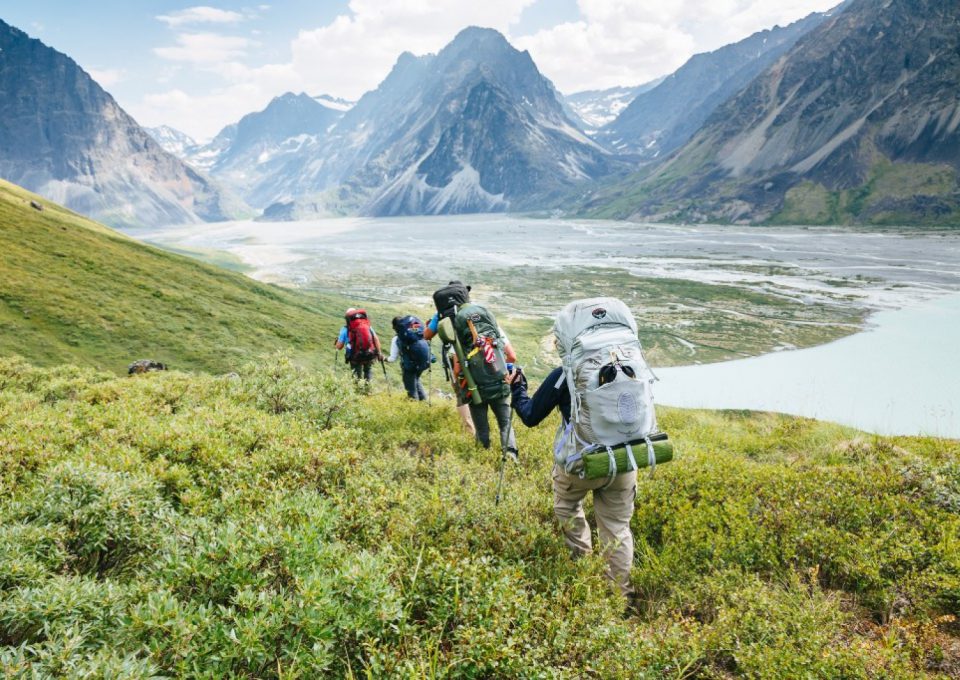
Turquoise Glacier High Route – Lake Clark National Park
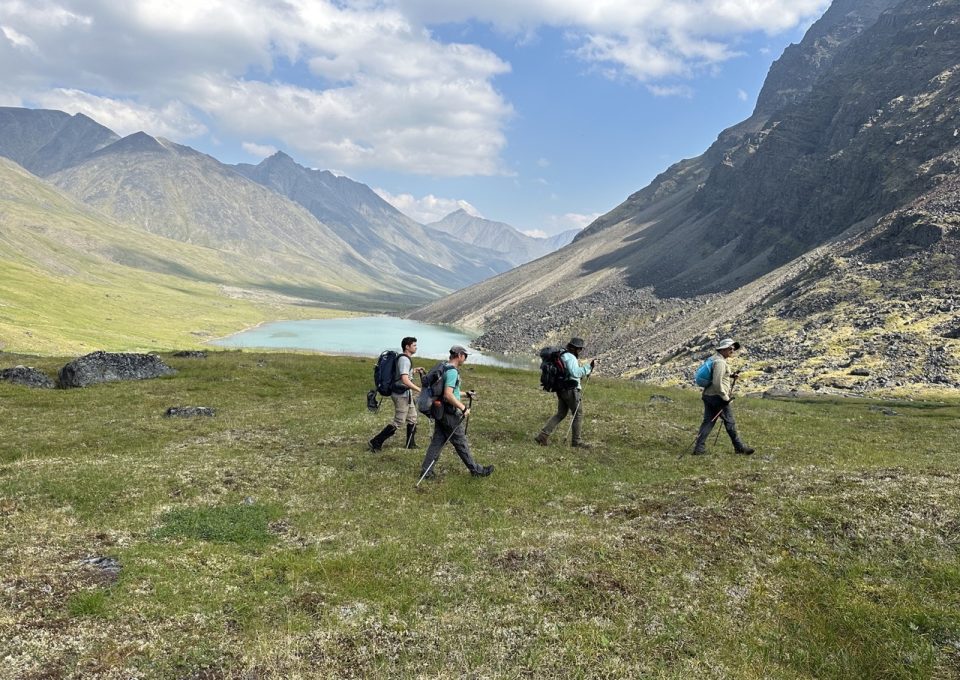
Oolah Valley High Route – Gates of the Arctic National Park
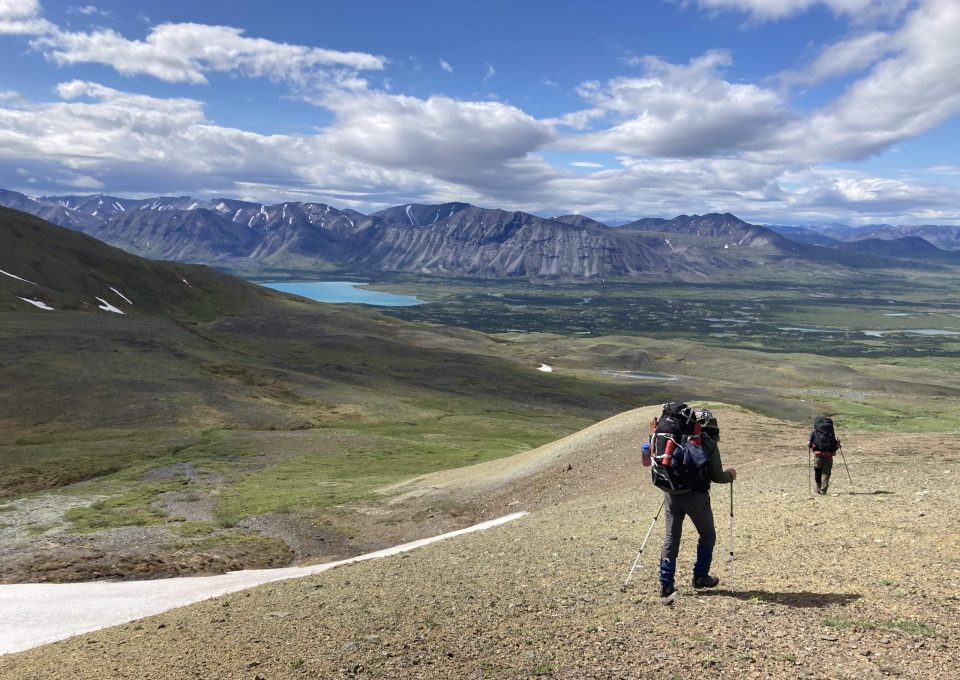
Turquoise to Twin Traverse – Lake Clark National Park
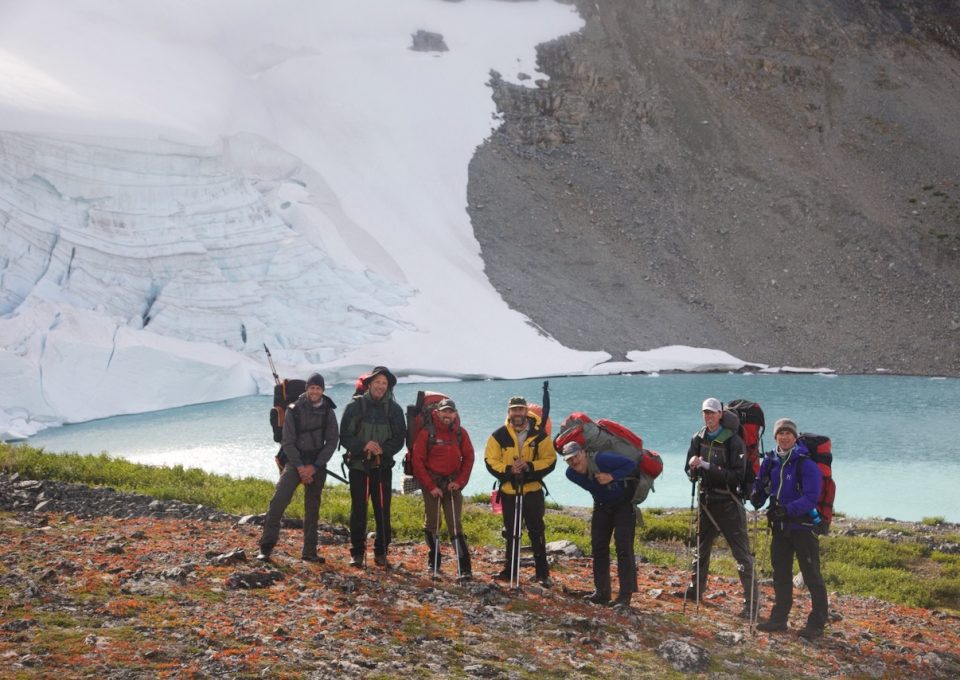
Backpacking Katmai – Katmai & Lake Clark National Parks
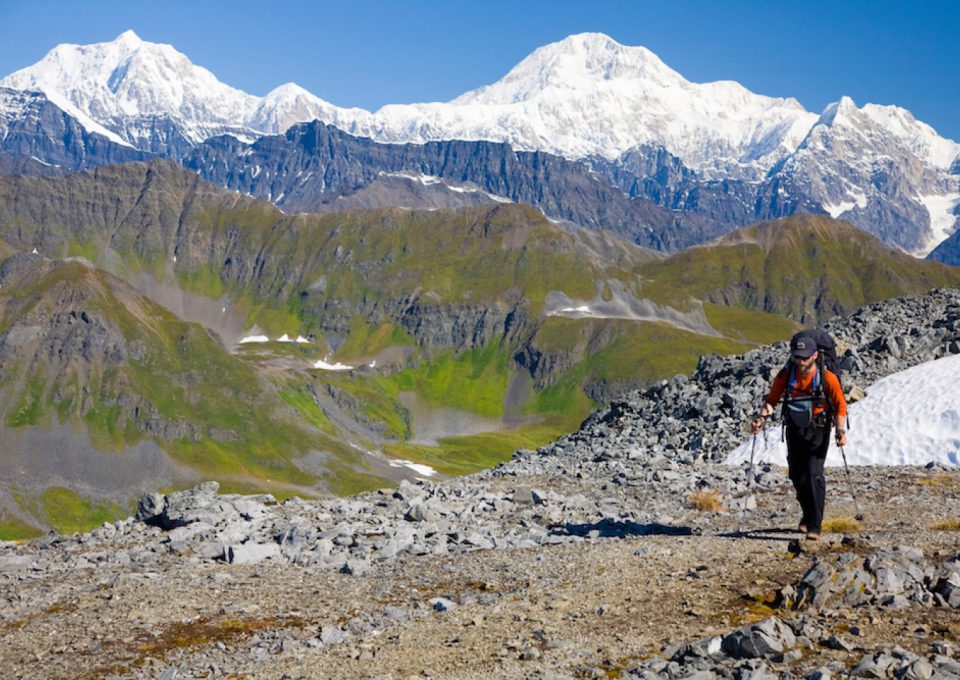
Backpacking Denali National Park – 7 Day

Backpacking Denali National Park – 10 Day

Arrigetch-Alatna Pack Raft – Gates of the Arctic National Park

Backpacking the Arrigetch Peaks – Gates of the Arctic National Park

Backpacking ANWR – Arctic National Wildlife Refuge

The Valley Experience – Katmai National Park

Backpacking the Revelation Mountains – Lake Clark National Park
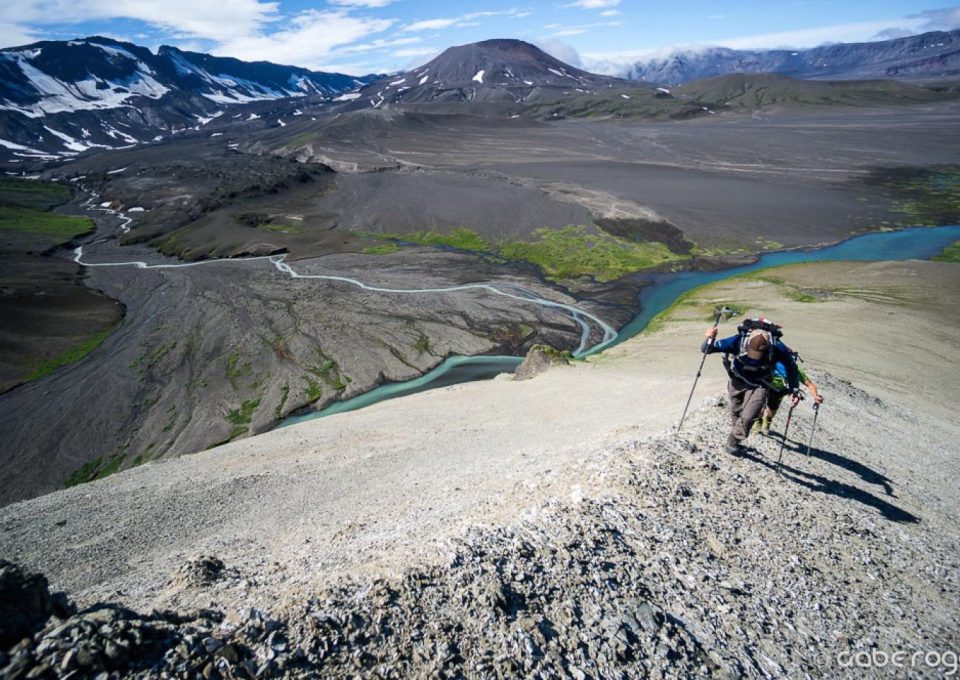
Backpacking the Ring of Fire – Aniakchak National Monument
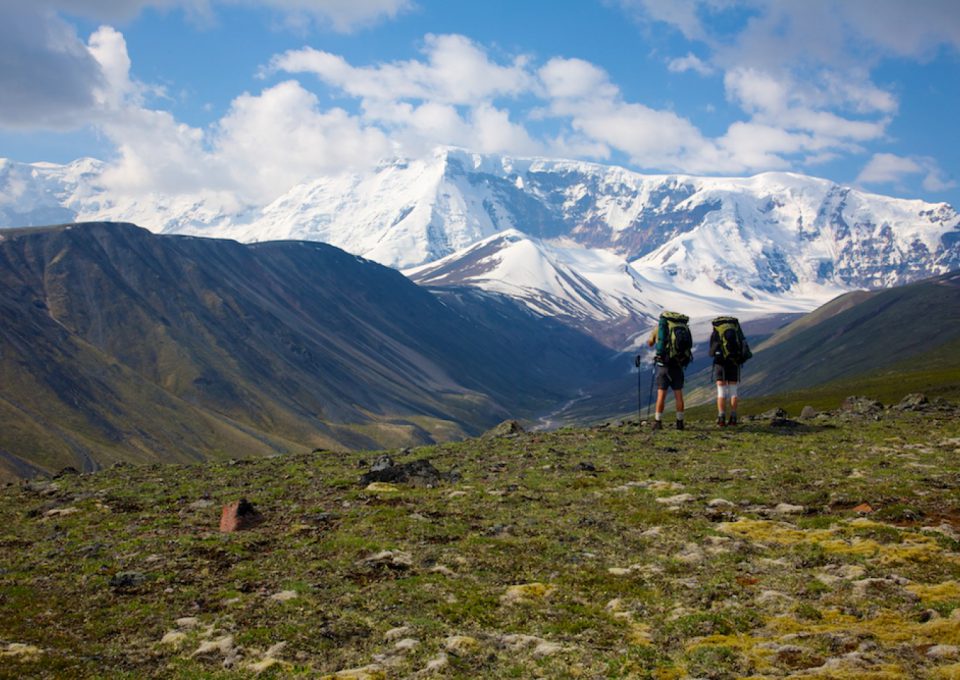
Backpacking Wrangell-St. Elias National Park
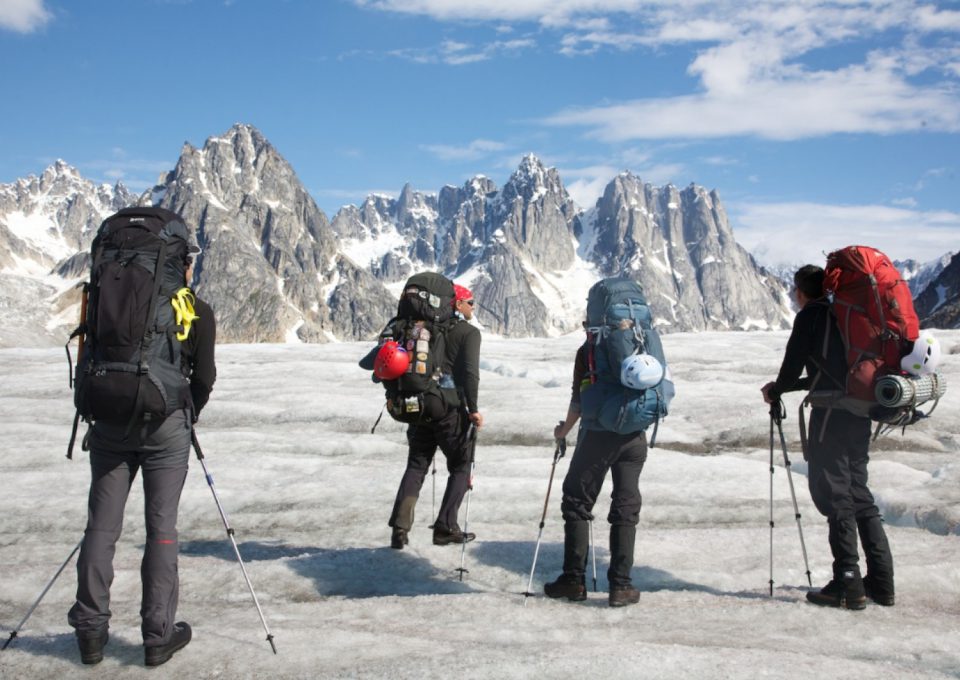
Neacola High Route – Lake Clark National Park
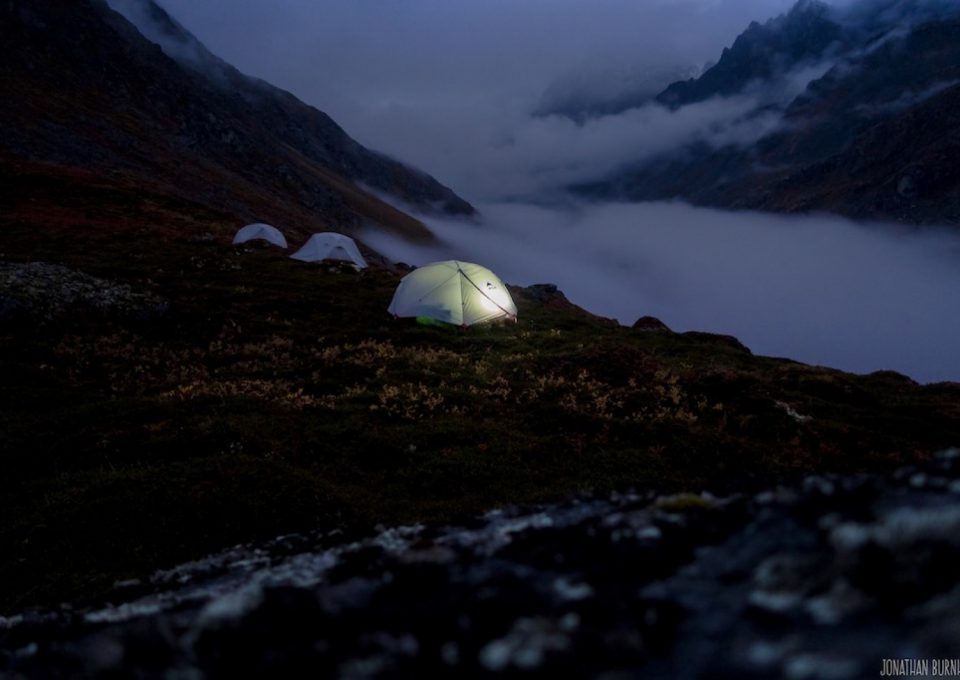
Backpacking the Talkeetna Mountains

Exploring the Northern Revelation Mountains – Lake Clark National Park
- All Adventures
- Backpacking Trips
- Hiking Trips
- Kayaking Trips
- Rafting Trips
- Multisport Tours
- Packaneering Trips
- Family Adventures
- Quick Getaways
- All Destinations
- Lake Clark National Park
- Denali National Park
- Gates of the Arctic National Park
- Katmai National Park
- Wrangell-St. Elias National Park
- Kobuk Valley National Park
- Arctic National Wildlife Refuge
- Aniakchak National Monument
- Northwest Arctic Parks
- Prince William Sound
- Kenai Fjords National Park
- Find Your Trip
- Reservation Policies
- Private Adventures
- Intensity Levels
- Safety & Responsibility
- Alaska Weather
- Gear Rental
- [email protected]
- Direct: 907-351-4193
- Toll-Free: 877-525-2577
- Travel Guides Plan your adventure
- Destinations Our favourite places
- Tours Book a trip
- Travel Companies Independent specialists
- Travel Guides
- Destinations
- Travel Companies
Best Places For Backpacking In Alaska
Alaska's best national parks for backpacking trips.
Lisa Maloney
- In this guide
- Backpacking
Arctic National Wildlife Refuge
- Gates of the Arctic National Park
- Kobuk Valley National Park
Denali National Park
- Wrangell-St. Elias National Park And Preserve
- Katmai National Park
- Prince William Sound and Kenai Fjords National Park
Lake Clark National Park
- Aniakchak National Monument and Preserve
- Chugach and Talkeetna Mountains
- When to go to Alaska
- Packing list
- Where to go
Chugach State Park
- Arrigetch Peaks
- Revelation Mountains
Wrangell-St. Elias National Park
Alaska is a backpacker's paradise, where your trail cred will reach new levels.
Whether you’re cutting your teeth on classic tried-and-true routes, or flexing more advanced backpacking skills, Alaska is the place to gear up and get out there. Just remember to plan appropriately and book with a qualified guide if needed!
Here are some of Alaska's best picks for wilderness backpacking trips.
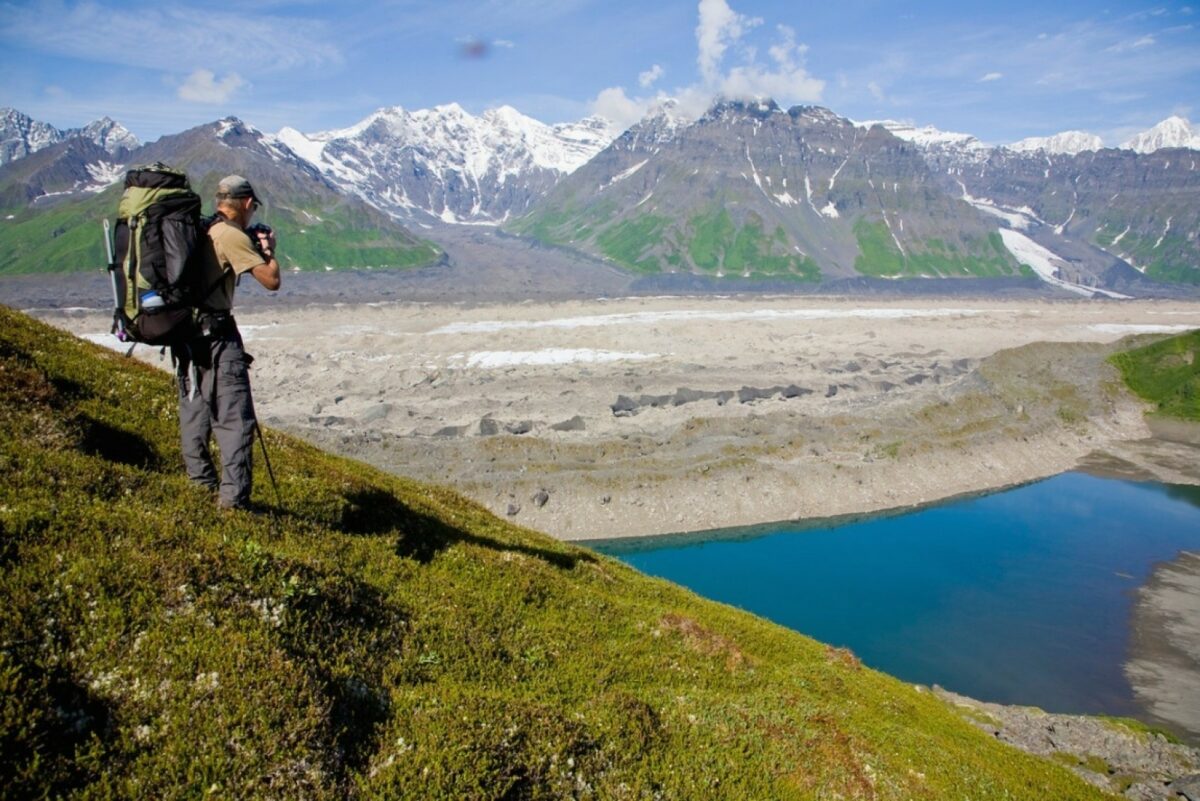
Backpacking through Denali National Park
featured trips
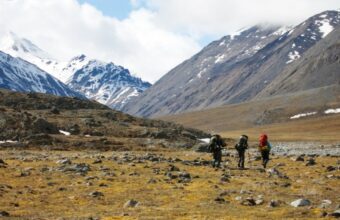
Backpacking ANWR
10 days in the arctic national wildlife refuge.
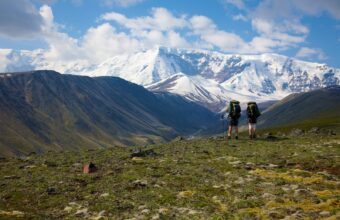
Backpacking Wrangell
Explore the dramatic wilderness of wrangell - st. elias national park.
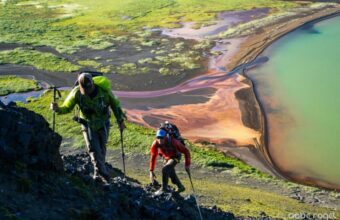
Backpacking the Ring of Fire
Explore ancient volcanoes at aniakchak national monument.
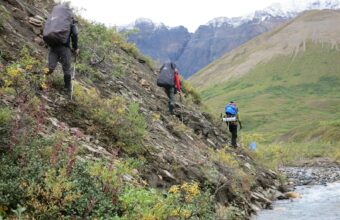
Backpacking the Revelation Mountains
Hike the remote mountains of lake clark national park.
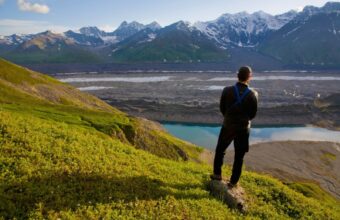
Backpacking Denali
7-day, 20+ mile backpacking adventure, where to go backpacking in alaska, alaska's best places for wilderness backpacking trips.
Note: Many of the following locations are true Alaska wilderness, and are best visited with the support of an organised and guided backpacking tour.
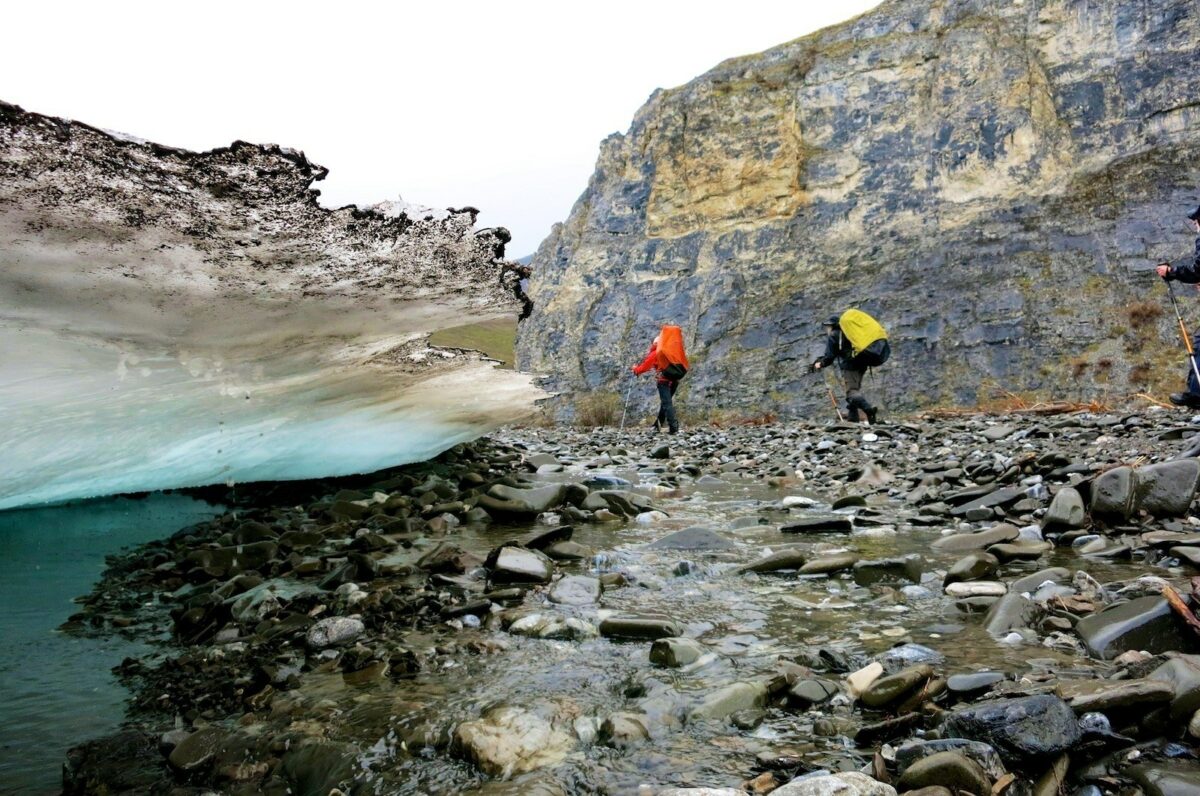
Backpacking in Arctic National Wildlife Refuge (ANWR)
The Arctic National Wildlife Refuge is a vast, trackless wilderness, ideally suited to remote hiking, backpacking, climbing and paddle/float trips. This is a true wilderness—one of the most isolated places on earth, receiving fewer than 1,000 visitors each year. People generally visit as part of a guided or organised adventure tour.
There are no roads or established trails in ANWR. The only way to get here is by air, by boat (on the rivers) or on foot; the latter happens only very rarely. Most visitors take a small plane from Fairbanks to either Arctic Village (south of the refuge) or Kaktovik (on Barter Island, in the northerly reaches of the refuge), then take a bush plane to their final destination in the park. The most efficient flight from Fairbanks to Kaktovik takes two hours with Ravn Alaska and Hagelund Aviation.
Read more: How to get to Arctic National Wildlife Refuge
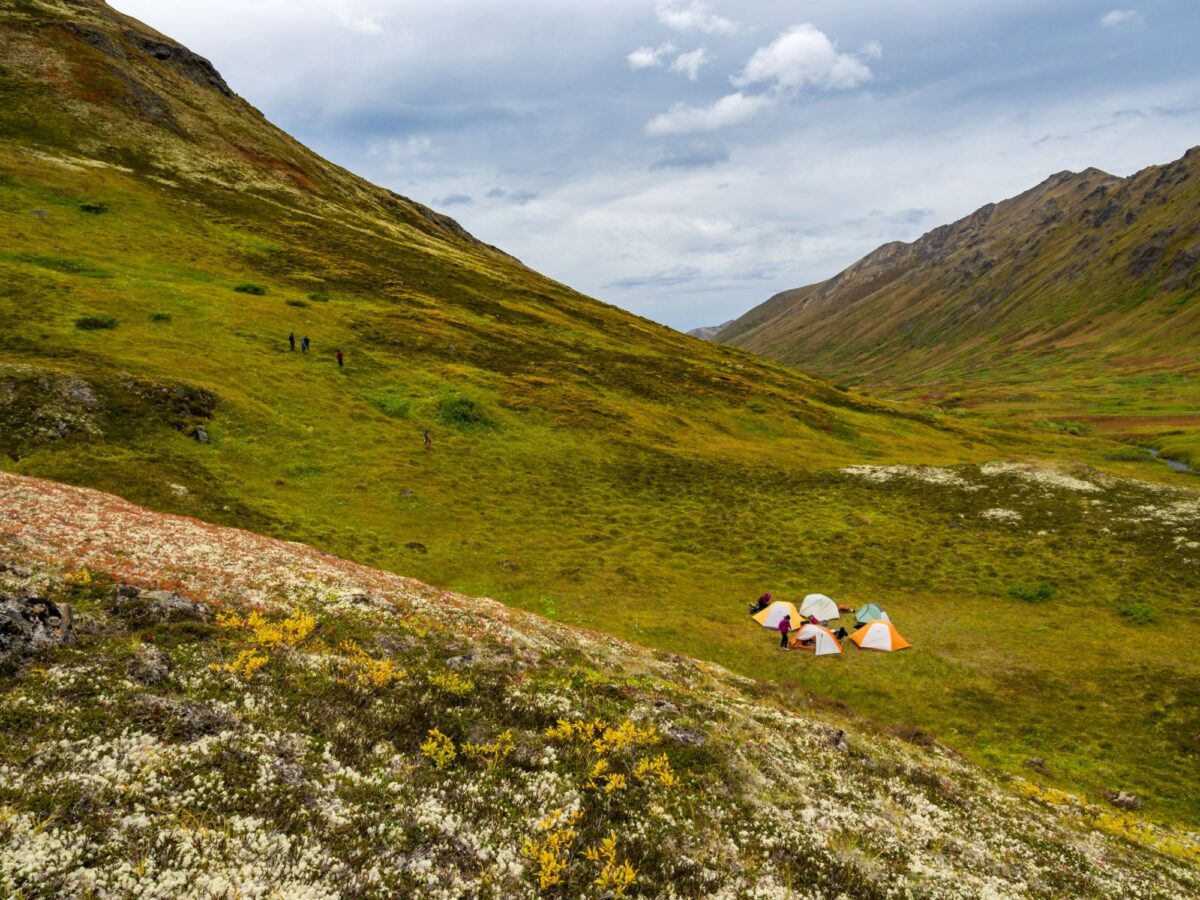
Camping in Mountain Valley, Chugach State Park
Extending for roughly 495,000 acres north, south and east of Anchorage and connected to the South-central Alaska road network, Chugach State Park is one of the state’s more accessible adventure spots. The Chugach Mountains offer several dozen excellent hiking and backpacking trails, much of which across high tundra landscapes, all within easy reach from Anchorage.
Almost all access to Chugach State Park is by road. The park is easily accessed from a number of trailheads in Anchorage, Girdwood, Eagle River, Chugiak/Birchwood, and areas in between.
Read more: How to get to Chugach State Park
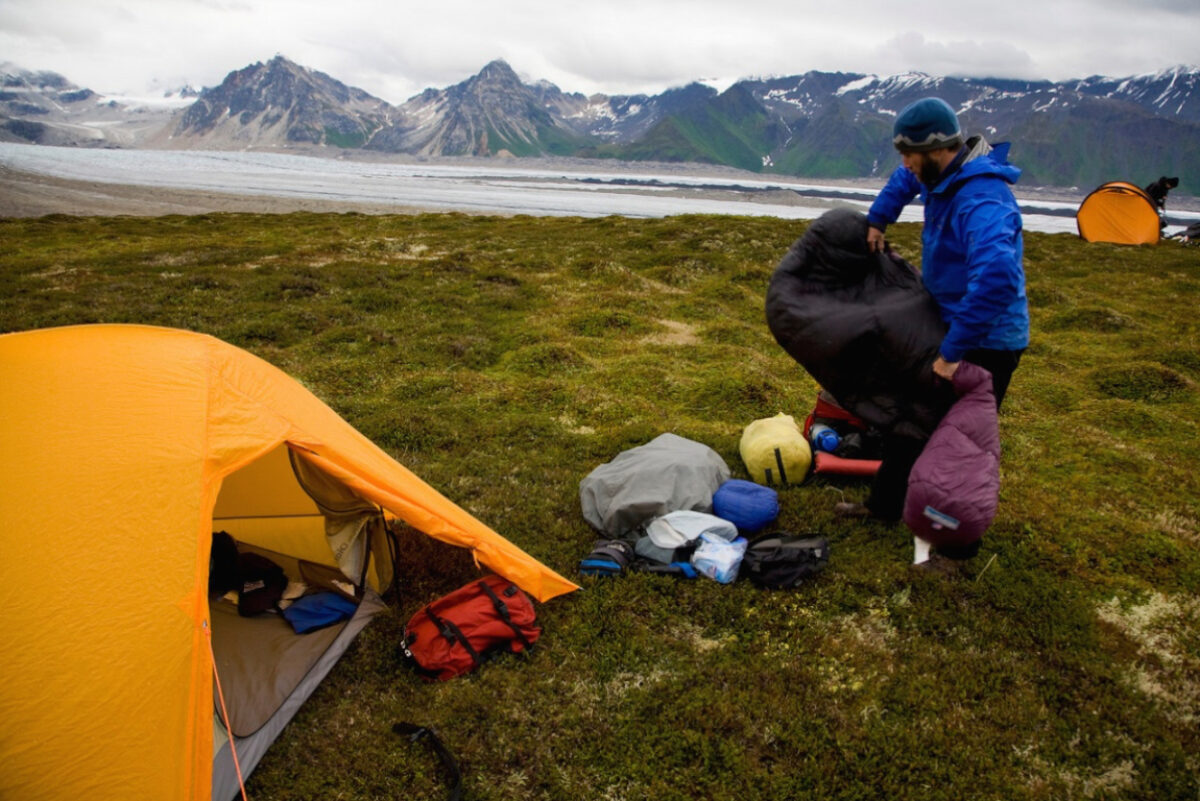
Striking camp in Denali National Park
Denali National Park and Preserve is a sprawling, 6-million-acre land of snow-clad peaks, tundra-carpeted hills and rushing glacier-fed creeks. Easy access from the road system and being home to Denali (formerly Mt. McKinley) which, at 20,310' / 6,200m, is the tallest mountain in North America, make this one of the most-visited parks in Alaska.
Backcountry hiking and backpacking are very popular. Most of this is done off-trail as there are no established long-distance trails.
Read more: How to get to Denali National Park
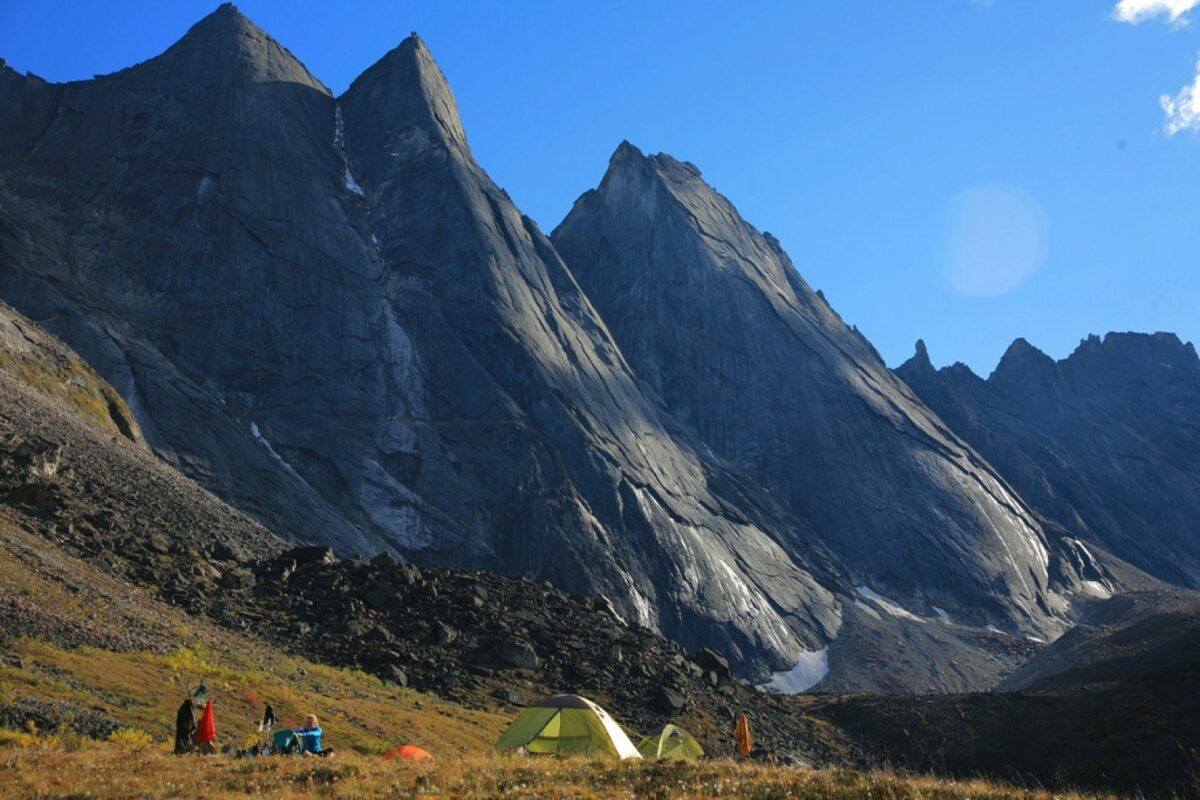
Camping in the shadow of the Arrigetch Peaks in Gates of the Arctic National Park
Arrigetch Peaks, Gates of the Arctic National Park
The Arrigetch Peaks, in Gates of the Arctic National Park, are known for their sheer walls, vertical spires and spectacular relief. They’re deep in the Brooks Range, with very low backpacker traffic.
Most famous for having one of the last completely intact Arctic ecosystems, there are no established or maintained roads or trails here, unless they were created by animals. Hiking and paddling or floating on the rivers are also very popular activities. Keep in mind that travel is difficult, and even seasoned backpackers may manage only five miles in a day.
Read more: How to get to Gates of the Arctic National Park
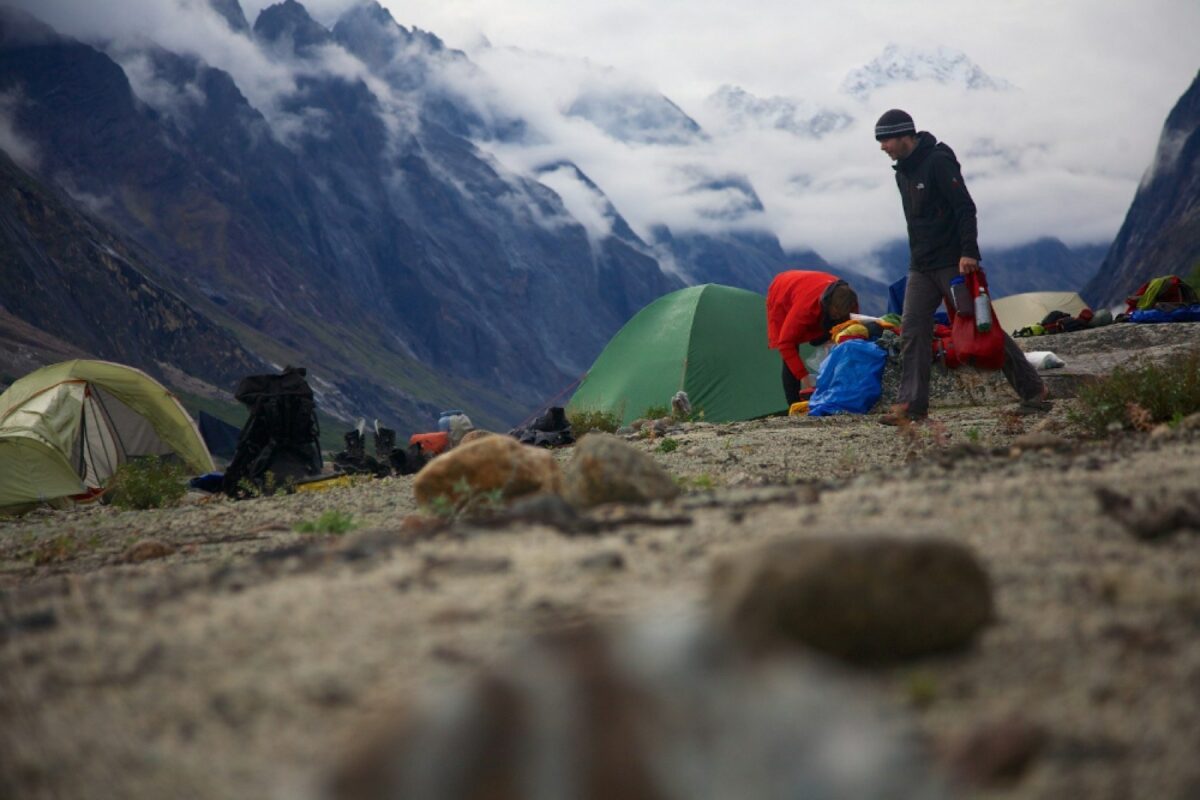
Revelation Mountains in Lake Clark National Park
Revelation Mountains, Lake Clark National Park
Lake Clark National Park is one of Alaska's preeminent backpacking locations, but despite its popularity there is still plenty of true wilderness for backpacking, such as the rugged and remote Revelation Mountains.
The Revelation Mountains have landscapes on a Himalayan scale and are visited by just a handful of hardy backpacking groups, typically on professionally-organised tours.
Read more: How to get to Lake Clark National Park
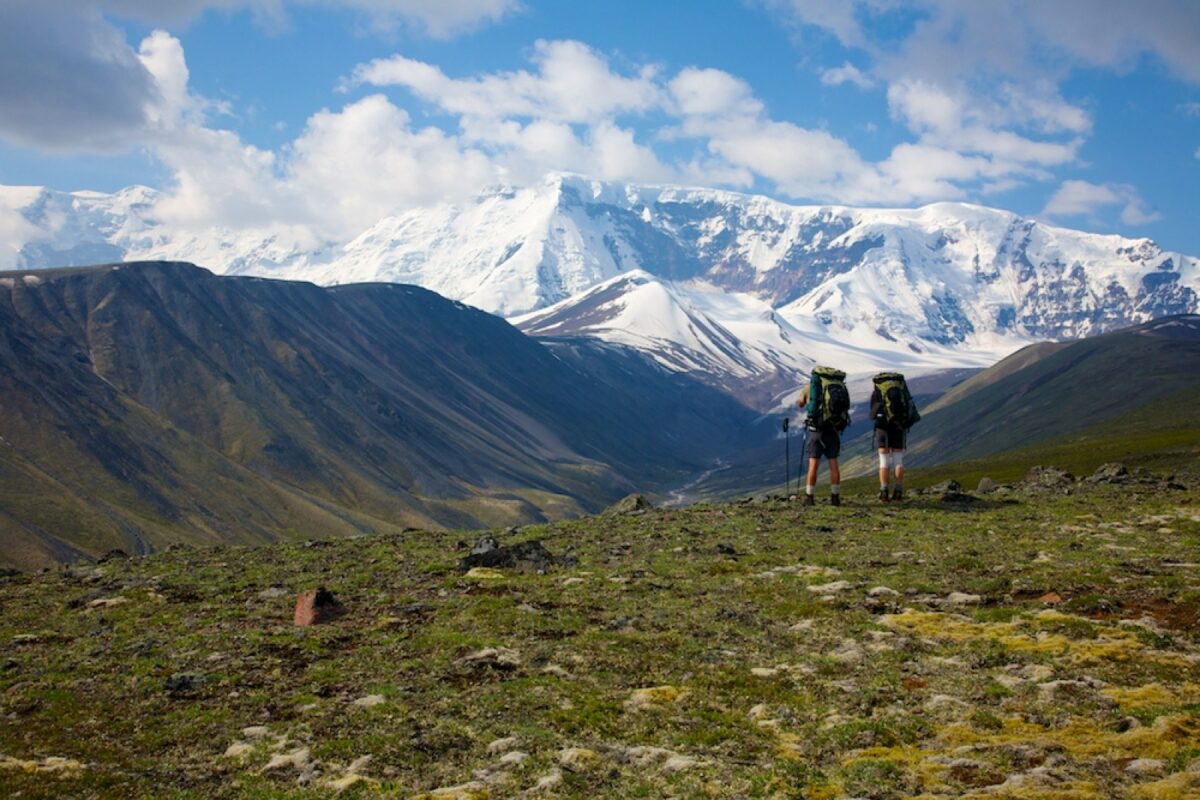
Hiking through glorious Wrangell-St. Elias National Park
Wrangell-St. Elias National Park may be best known for its enormous size; this 13.2 million acre behemoth is twice the size of Maryland. It's also a paradise for mountaineers, sporting some of North America's largest volcanoes but none of the traffic jams you'd find in Denali.
Although access is usually easiest by air taxi, two dirt roads offer limited access into the park.
Read more: How to get to Wrangell-St. Elias National Park
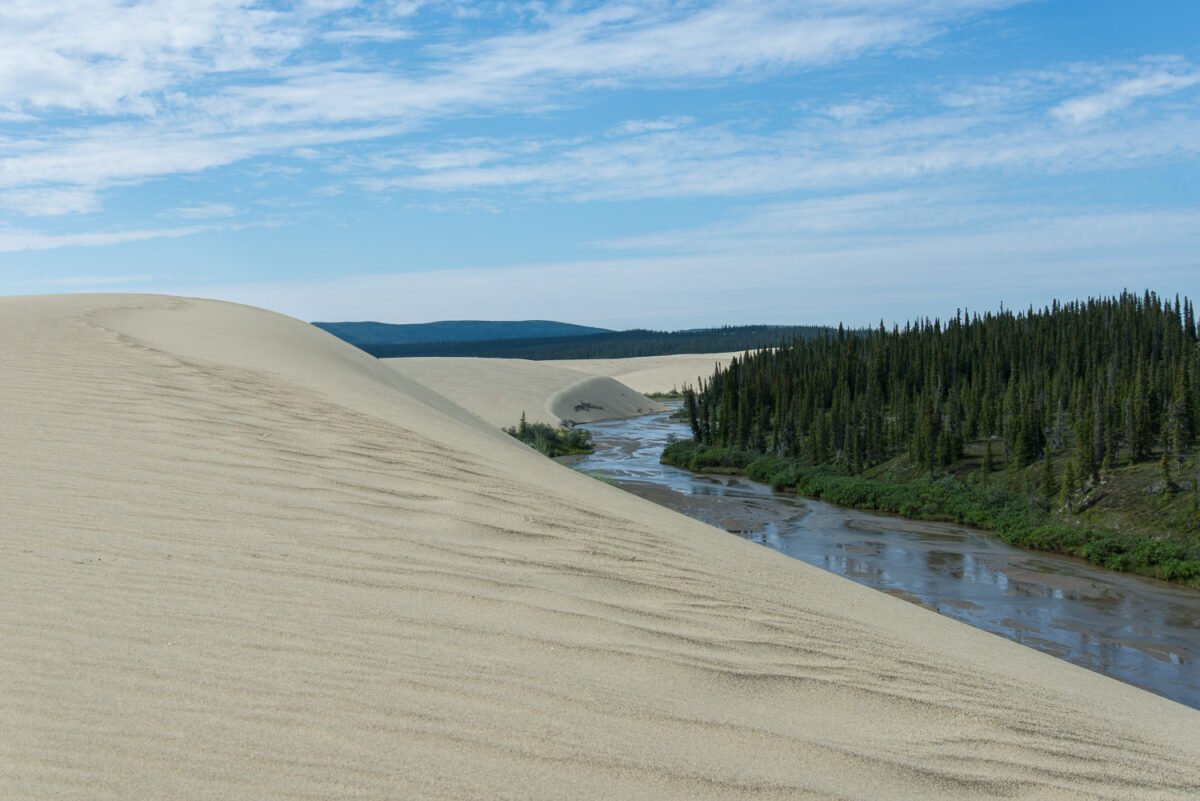
Brooks Range, Kobuk Valley National Park
Without road access, flightseeing trips are a popular mode of visiting Kobuk Valley National Park, with one of the most notable sites being the Great Kobuk Sand Dunes (and Little Kobuk and Hunt River dunes).
Hiking and backpacking are popular activities in Kobuk Valley National Park. With no designated campgrounds and no road access, be sure to pack everything you will need on your trip into the wilderness.
Kobuk Valley National Park is an excellent place for aurora-viewing in the winter and is a popular spot for activities such as snowmobiling (“snowmachining” to locals), skiing and dog mushing should only be attempted by people with the appropriate equipment and well-tested Arctic survival skills. For most visitors, this means: Don’t even think about it without a guide.
Read more: How to get to Kobuk Valley National Park

Things To Do In Arctic National Wildlife Refuge
About the author.
Lisa is an Alaska-based writer and journalist. She has authored the Moon guide to Alaska Alaska and served as senior editor at Alaska magazine among bylines in Via, Backpacker, the Wall Street Journal, Alaska magazine, Last Frontier, Northwest Travel & Life, The Writer, Funds for Writers, Natural Home and Garden and Outside Online.
Featured tours
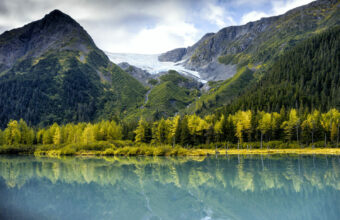
Alaska Highlights 5 Night/6 Day Guided Land Tour
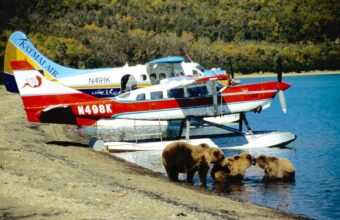
Bear Trekking in Katmai National Park
Alaska’s most unique bear viewing trip.
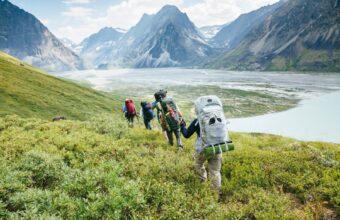
Turquoise Glacier High Route
10 days backpacking through lake clark national park.
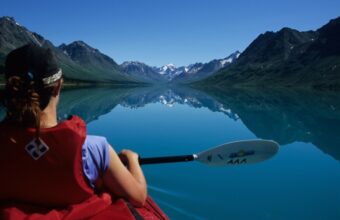
Twin Lakes Paddle
Explore the magic of lake clark's twin lakes.
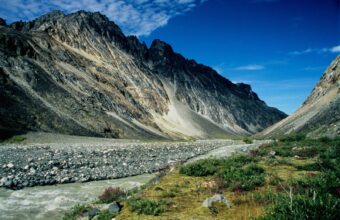
Lake Clark Unexplored
Why horizon guides.

Impartial travel guides
Our guides are written by the leading experts in their destinations. We never take payment for positive coverage so you can count on us for impartial travel advice.

Expert itineraries
Suggested itineraries and routes to help you scratch beneath the surface, avoid the tourist traps, and plan an authentic, responsible and enjoyable journey.

Specialist advice
Get friendly, expert travel advice and custom itineraries from some of the world's best tour operators, with no spam, pressure or commitment to book.
Our guides are 100% impartial and are written by independent, professional travel journalists. We make money by charging carefully-screened travel companies to list their business on our website. Our advertisers have no influence on our editorial content and we never accept payment for positive coverage.
Read more about how we work and what we believe in here .
- Travel guides
- Work with us
Sitemap , Privacy Copyright © 2024 Horizon Guides
- Search Please fill out this field.
- Newsletters
- Destinations
- United States
The 10 Best Hiking Trails in Alaska
:max_bytes(150000):strip_icc():format(webp)/Becker1-5b734a56c9e77c0025caddbd.jpg)
HagePhoto/Getty
Dubbed the "last frontier," Alaska is a place that has more than its fair share of stunning landscapes to explore. It has eight massive national parks and more public lands than any other state in the U.S. by a vast margin. That means that there are hundreds of miles of hiking trails to explore, many of which are incredibly remote and offer stunning views along the way.
Creating a list of the 10 best trails in Alaska isn't easy, as there are so many good ones to chose from. But we've combed through all of the options and made our selection. If you're heading to the 49th state, these are the hikes that you should have on your radar.
The Lower Trail (Kenai Fjords National Park)
brytta/Getty
The Lower Trail—or the "Edge of the Glacier Trail" as it is sometimes called—is one of the most memorable hikes you're likely to take anywhere on the planet. The route is relatively short and flat, stretching for just a little less than a mile one-way, but it takes hikers from the parking lot, right to the edge of the stunning Exit Glacier located in Kenai Fjords National Park . Along the route, hikers will find signs explaining flora and fauna of the region and the impact of the retreating glacier over the past 120 years. Suitable for everyone, this is a must-do if you're visiting the park.
Those looking for something a bit more adventurous should give the Harding Icefield Trail a try. It's 8.4 miles in length and a bit more challenging but provides even better views of the surrounding landscapes.
Lost Lake Trail (Chugach National Forest)
Grant Dixon/Getty
Just one of more than 30 trails found inside the Chugach National Forest , the Lost Lake Trail is nonetheless a standout option for hikers. Stretching for 13.8 miles out and back, the route distinguishes itself thanks to the wide variety of terrains that it passes through. In the beginning, you'll walk through rainforests, but later, you'll leave the woods behind and bask in alpine meadows and pristine lakes. The trail is moderately difficult in the summer, with more than 2,600 feet of vertical gain along its length. In the winter, it becomes more challenging with the addition of snow and ice. No matter what time of the year you visit, however, you're sure to be captivated by the scenic Alaskan backcountry.
Indian River Trail (Sitka)
Sitka Trail Works
Located just a short walk from the charming town of Sitka, the Indian River Trail is an enchanting walk that rewards hikers with a 70-foot waterfall at one end. The trail is 4.4 miles in length, but is a reasonably easy walk, requiring about two hours to complete one-way. The route follows the path of the Indian River, which carves its way through a lush Alaskan rainforest, which is as wild and untamed as you can imagine. Part of the joy of this hike is just how accessible it is from the city, although it doesn't take long to feel like you've wandered into a remote corner of the globe.
Bears are not frequently found on the trail, but the river itself is known for having a lot of fish. This will occasionally lure both black and brown bears into the area, so it is essential that make noise while hiking, bring a can of bear spray, and know what to do should you come face to face with these creatures. As with any wilderness hike, it is good to be safe and cautious along the way.
Chilkoot Trail (Skagway)
Imageexphoto/Getty
Chilkoot Trail gives hikers several reasons to get excited. For instance, not only is it an excellent option for day hikers looking to access some of Alaska's best backcountry, but its 33-mile length makes it an excellent choice for backpackers too. Generally seen as moderately difficult, the trail also happens to be an outdoor museum, passing through ancient cultural and archaeological sites along the way. The Chilkoot even crosses the border into Canada, providing an international wilderness experience that includes camping on both sides of the border. Taking a day hike on this legendary trail offers a good taste of what it has to offer, but to understand what it is truly all about, you'll need to spend 3-5 days walking it end to end.
Flattop Mountain (Anchorage)
Yu Takada/Getty
If you're visiting Anchorage and are looking for a great hike that isn't far from town, head to Chugach State Park and take a walk to the summit of Flattop Mountain. It is easily the most visited peak in the entire state, but it is easy to see why. From the summit, it possible to look down on the city, as well as Cook Inlet, the Chugach and Alaska Ranges, and if the weather cooperates, possibly even Denali itself. The trail is only 1.5 miles in length one-way, so it isn't exceptionally long. There are also some strategically placed stairs to be found near the 3,281-foot summit, which makes this a more comfortable hike than would typically be. Still, it will test your legs along the way, but offer some great views and have you back to the car in time for lunch.
Resurrection Pass (Kenai Peninsula)
Although it is broken up into shorter day hikes along its length, the 38-mile long Resurrection Pass Trail typically requires about five days to walk end-to-end. Those who take on this journey will be treated to some of the best views of the Kenai Mountains imaginable, passing through beautiful valleys, past towering waterfalls, and around alpine lakes. Despite its length, the trail is of moderate difficulty at most and is considered one of the best and most accessible ways to explore Alaska's backcountry. Well marked, generally smooth, and with only a gradual elevation gain and loss, this is a fantastic option for those looking to make their first Alaskan backpacking trip. However, day hikers will find plenty to love along its various segments as well.
Mount Marathon (Seward)
mhgstan /Getty
The legendary Mount Marathon is home to an annual foot race that is often described as the "toughest 5k in the world." The trail that the runners use is open to hikers all year round and provides fantastic views of the town of Seward and the Kenai Fjords beyond. This route isn't an easy one, however, as it features more than 3,000 feet of vertical gain over just three miles. In other words, there is a lot of climbing involved, which will likely leave in those in good physical condition gasping for air along the way. Stick it out to the top, however, and the payoff is more than worth it. On a clear day, you can see for miles, providing a great sense of the scope and scale of Alaska while you catch your breath.
Kesugi Ridge Trail (Denali State Park)
Scott T. Smith/Getty
Another somewhat-hidden gem in the Alaskan hiking line-up, Kesugi Ridge Trail is a multi-day hike that covers 29.2 miles through Denali State Park . Moderate to challenging in difficulty, there are many steep climbs throughout. This can make it somewhat discouraging for day hikers, although those who push through the tough starts at either trailhead, will soon be rewarded with easier walking and amazing landscapes to explore. On clear days, even Denali (formerly Mt. McKinley) can be seen from sections of the trail, bringing an added element of surprise to this hike. Thru-hikers will find this a rugged and challenging walk, but a very rewarding one, particularly as you'll usually have the route mostly to yourself. Along the way, you'll discover open tundra, rainforests, mountain views, and so much more. Indeed an excellent trek for those with an adventurous streak.
Kenai River Trail (Cooper Landing)
flownaksala/Getty
With so many scenic coastlines and mountain tops to explore, it's easy to overlook some of Alaska's fantastic river trails, many of which have plenty to offer adventurous hikers too. Take, for example, the Kenai River Trail, which runs for 10.1 miles (out and back) along a gorgeous stretch of the river. The route is lovely all year round, but especially so the autumn when the leaves begin to change. A relatively easy hike along most of its length, the trail gets a bit more challenging along the upper sections, which require some climbing to reach the top of the Kenai River Canyon. Once over the top, however, the views of the Kenai River are outstanding, with snowcapped Alaskan peaks often reflected in its serene waters.
Late in the summer, the river fills with spawning salmon, which in turn tends to lure in plenty of bears. While it can be exciting to encounter those creatures in the wild, it is best to avoid them when you can. Take caution, don't get too close to the animals, and give them a wide berth when hiking.
Skilak Lookout Trail (Cooper Landing)
Ken Marsh/Getty
Another relatively short, but oh-so-sweet trail, the Skilak Lookout Trail is a true Alaskan classic. A little over four miles in length round trip, the hike makes a gradual climb upward to a rock cliff face that provides stunning views not only of Skilak Lake itself but the Kenai Mountains beyond. But there are several other great views to be had while en route as well, making this a popular walk with photographers. A relatively easy hike from start to finish, the trail is easy to follow and requires about 3-4 hours to complete. In the summer months, some sections can get a bit thick with overgrown brush, so wear your long pants. Sturdy hiking shoes are a must all year long, but even beginner hikers can march this route without fear. Add a little extra time into your schedule for lingering at the overlook, because you're not going to want to rush back to the parking lot after you've seen that view.
Related Articles
More related articles.

Good for all ages and abilities, families with small children, first time campers, or those wanting an easygoing trip.
Steamboat Hills
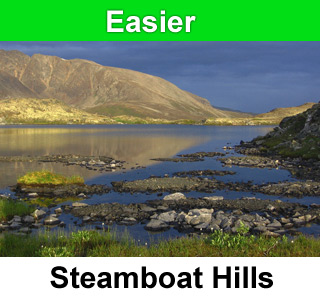
Alpine Alaskan lakes nestled amid rolling tundra and easier terrain make it a more laid back choice - also a great family spot. Usually done as a base camp or hybrid trip with some backpacking and some day hiking. Enjoy the fantastic scenery with more moderate hiking.
Fan Glacier
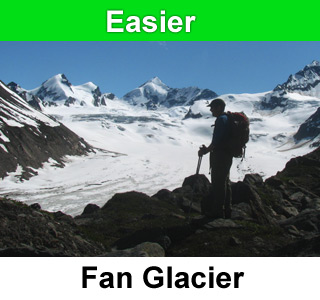
Ideal for folks with no backpacking experience as we usually set a base camp and do some day hikes on the Fan Glacier and alpine ridges with stunning views. This area of Alaska gets little snow making it a great early season hiking destination.
Turquoise Lake
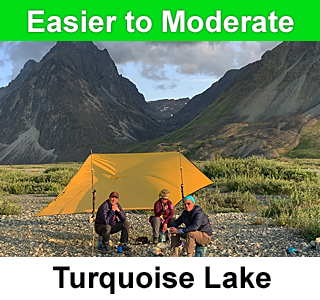
Enjoy deep wilderness adventure without heavy backpacking loads. On this base-camp style trip near the shores of Turquoise Lake the focus is on day hikes that can be as mellow or adventurous as you want.
Mt Wrangell
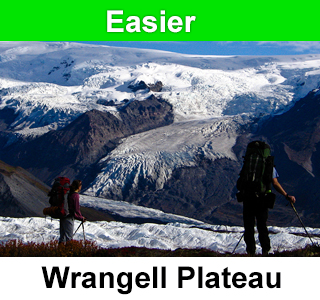
Perched on the knees of Mt. Wrangell, this spot offers stunning views of the mountain. The amazing scenery is matched with easy hiking terrain making this an excellent spot for an easy-going basecamp trip in Wrangell-St. Elias National Park.
Some prior backpacking experience may be required or preferred. Must be in good condition and able to hike about 6 hrs per day.
Donoho Glacier Trek
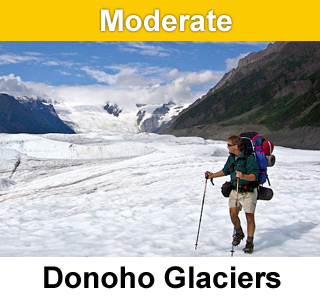
One of our most popular shorter trips. Quintessential Alaskan terrain featuring glacier exploration and jaw-dropping, in-your-face views of glaciers, icefalls and Wrangell range peaks. Our most economical backpacking trip.
Iceberg Lake
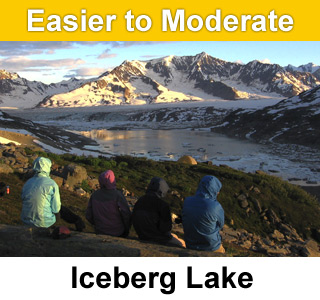
Stunning and dramatic terrain with hanging glaciers, icefields, glacier hiking, ridge walks, alpine lakes, moderate scramble summits. A classic Alaskan valley and ridge-line for moderate backpacking and exploration.
Skolai Pass
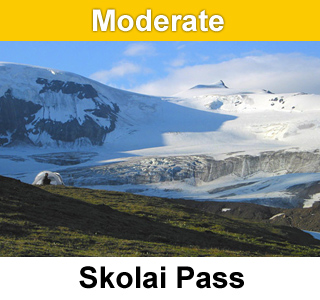
One of the most popular spots in the park due to the dramatic peaks, hanging glaciers and great Alaska wildlife spotting including Dahl sheep and caribou. Backpacking, base camp and loop style trips are possible. This is a classic Alaskan pass.
Wolverine Alpine NEW
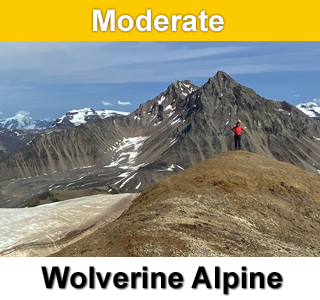
This trip is all about exploring the high country in the Wolverine Mountain area. Amazing ridge walks and exploring opportunties. This is a combination of backpacking and base camping so the best of both allows for a lot of flexibility. Discovering the many fossils in the region is a bonus on this trip!
Talkeetna Mts High Country
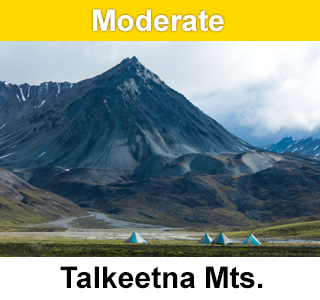
Great Alaska backpacking trip with moderate terrain and easy logistics. Trip departs out of Anchorage and has you in the backcounty by lunch same day! Reasonable cost and solitude on this backpacking trip in a seldom visited part of Alaska!
Agiak Lake - Gates of the Arctic
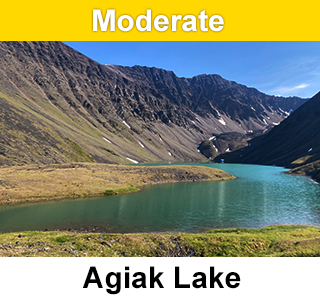
A new addition to our Alaska lineup. Enjoy an Alaska backpacking trip in remote solitude in Gates of the Arctic National Park. We have the freedom on this trip to do lots of backpacking or mix it up with some day hiking and exploration. Remote doesn’t have to mean hard-core.
Mount Drum NEW
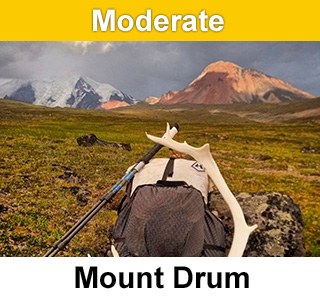
This trip has so much going for it. We put in at Chelle Lake at around 3100 feet at the base of Mt. Drum near Mt Sandford and Mt. Wrangell. So the landscape is stunning but the hiking terrain is fairly moderate.
Denali S.P. - Kesugi Ridge
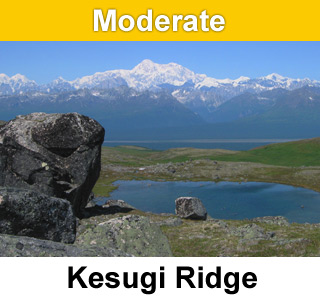
Shorter, closer to Anchorage - ridge walk with awesome Denali views! Great for those not looking for a hard core Alaska trip. We do backpack most days on this trip but once we hump it up the ridge the terrain eases back a bit. Good for fit beginners.
Sanford Plateau
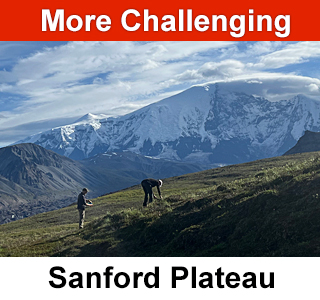
This trip presents the rare opportunity to hike directly beneath the shadow of the giants of the Wrangell range in Wrangell-St. Elias National Park - Mt. Sanford, Wrangell, Zanetti and Drum! If the weather gods cooperate you are sure to come home with some trophy photos in this incomparable setting.
These trips require prior backpacking experience. You must be in very good physical condition and up for some challenging and longer days. May include some bushwhacking. Must be ready to carry 50 lbs. plus over challenging terrain.
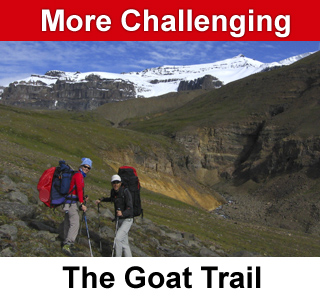
Unique Alaska high country backpacking route with amazing views, waterfalls, hanging glaciers…Our #1 trip for spotting wildlife including black and brown bears, dall sheep, mountain goats and caribou. Those with an interest in Alaska geology will love this trip - geodes, fossils and more abound.
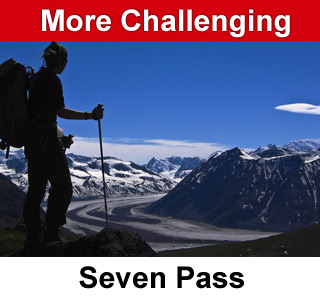
This is our ultimate Alaskan sampler trek with a lot of variety over the route. Terrain runs from glaciers to verdant valleys to high lonesome passes. If you think you will only go on one Alaska backpacking trip, this one should be on the short list.
Allie's Alpine Traverse
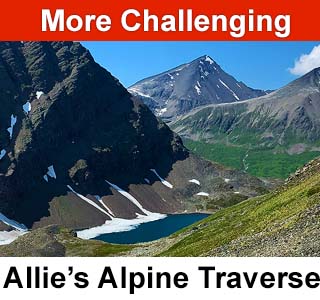
High alpine lakes, lush green valleys and views that change every day make this one of our top routes. Many folks find this the perfect mix of challenge and reward. It will test you at times but it doesn't go over the top into extreme challenge.
Alpine Gold Miners
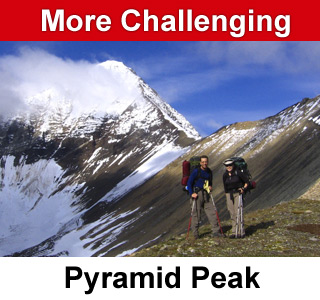
Guide's Choice! This trip is a consistent favorite with our guides. Remote Alaskan adventure with amazing ridge walks, stunning views of snow covered peaks near and far plus a bit of gold mining history. Trek Alaska pioneered this route and it is very lightly travelled. If you seek solitude this is the one!
Lake Clark Alpine
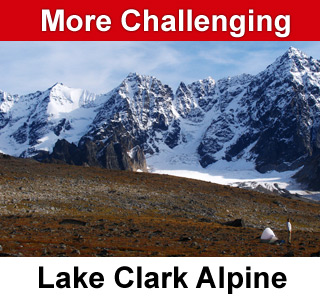
Alpine route through amazing Alaska lake country in the heart of Lake Clark National Park. This is a lake to lake backpacking trip with the added bonus of opportunities to fish at the lakes along the way. Trip originates with flight out of Anchorage so the day we depart is same day we start backpacking in this Alaska gem of a park. Challenging at times but overall not in the overly challenging range.
Arrigetch Peaks - Gates of the Arctic
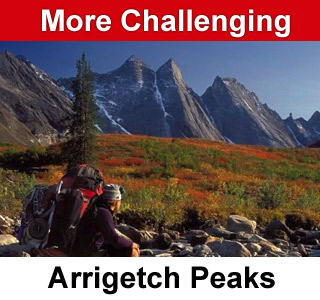
Explore one of the most stunning spots in Gate of the Arctic National Parlk in the heart of Alaska’s Brooks Range. The Arrigetch Peaks will leave a lasting impression. A challenging backpacking trip so you need to be ready. The payoff for the rugged hiking terrain is the chance to get up close to the unique granite spires of the Arrigetch bowl.
Extensive experience is required and you need to be ready for a very serious challenge. Must be ready to carry 50+ lbs. over very challenging terrain. Extended bushwhacking may be required.
Wrangell/Skyscraper
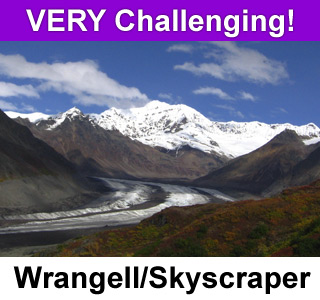
An extremely challenging Alaska backpacking trip recommended only for those with extensive backpacking experienced including experience on Alaskan routes. Very rugged and steep terrain but the reward is the chance to see Alaskan country that only a handful have travelled. One of the only routes that passes through the rugged Wrangell range. A great capper to a wilderness travel career.
anchorage alaska web design
- Skip to global NPS navigation
- Skip to the main content
- Skip to the footer section

Exiting nps.gov
Backpacking in alaska.
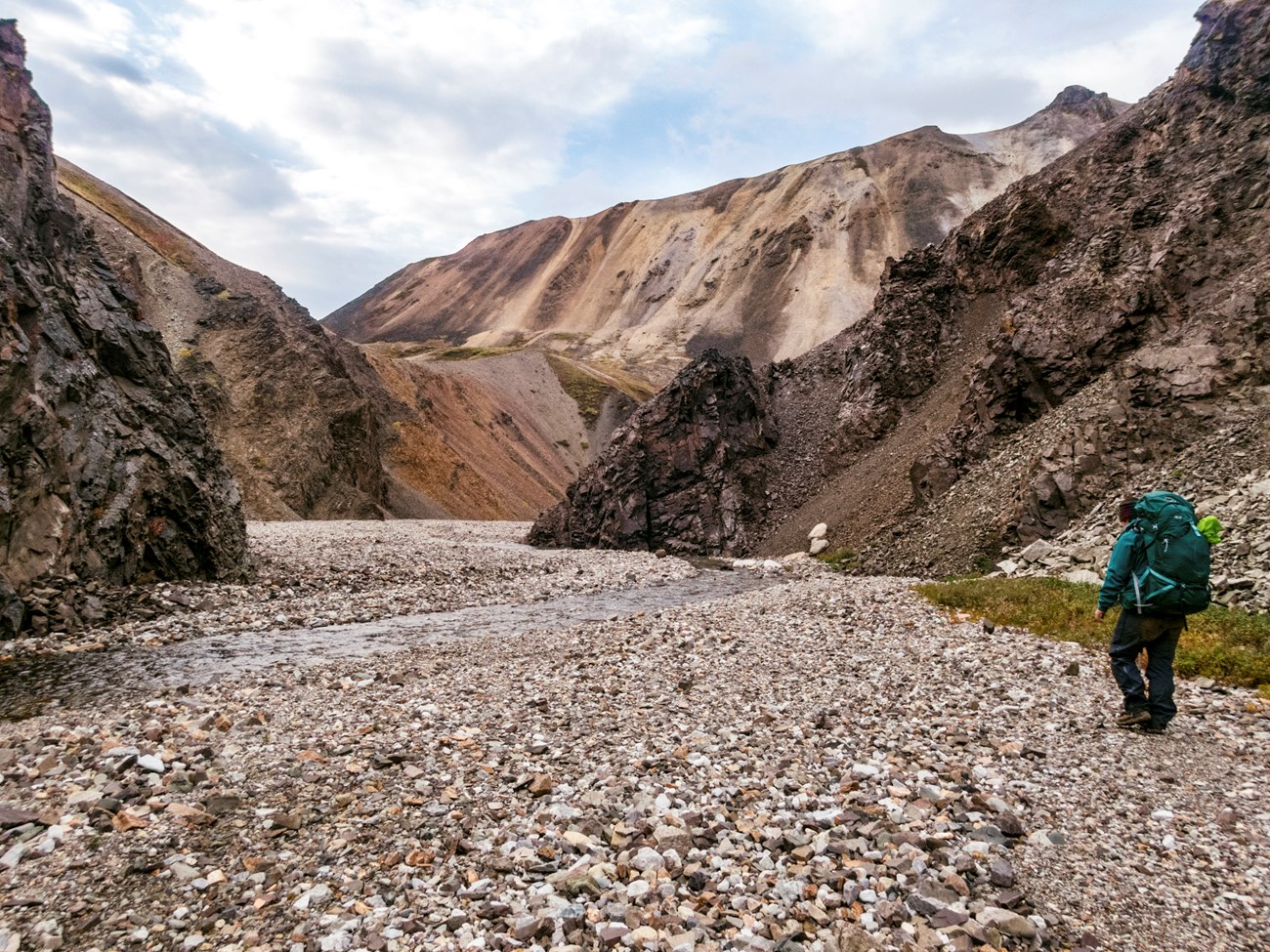
NPS / T. Vaughn
Hiking in a Remote Landscape
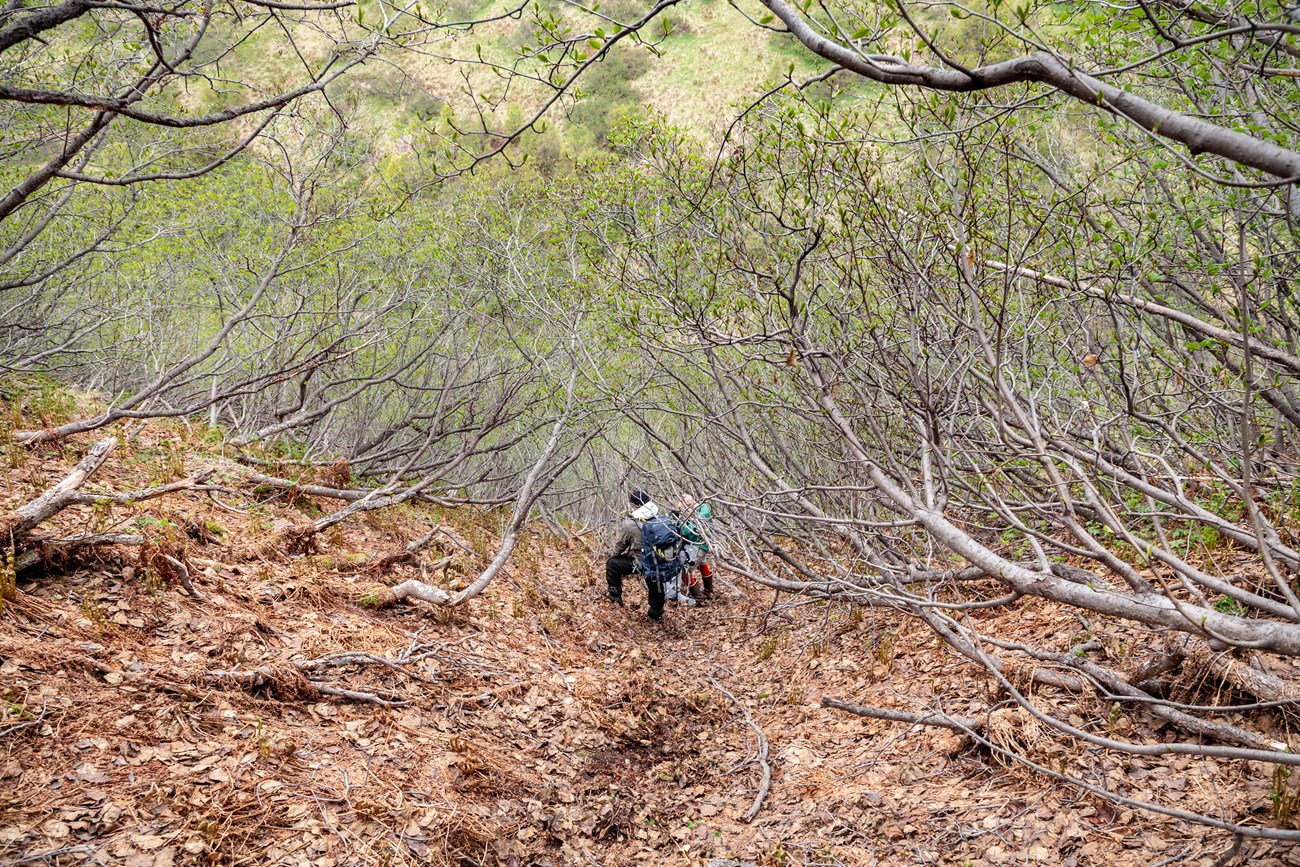
Backcountry Logistics
Food and Gear Prep: Planning is essential in Alaska, especially when fly-in backpacking. When landing in a remote area, there may not be groceries, gear or trash facilities available. You will want to have all you need ready for hiking and dispose of any trash before you load your plane or other mode of transport. You are dependent on your own resources here. Always pack plenty of food and fuel and carry emergency food rations. Come prepared with proper equipment and clothing, including weather-resistant outerwear, thermal layers and quality rain gear. You must be ready for changing weather conditions, as they often shift rapidly. Bear resistant containers are required in most areas. Bear spray and electric bear fences are effective deterrents. If you'll be carrying these with you, it's a good idea to practice their use before you leave for your trip.
Backcountry Electronics: Batteries for electronic devices often lose charge in the cold (even in summer), so bring a battery back-up or more batteries than you think you will need. It is highly unlikely there will be a place to charge your devices once you leave a big city or village. When hiking, it can be helpful to keep your batteries in a pocket on an inside layer; this will use your body heat to keep them warm for longer periods than inside your pack.
Trip Planning: Alaskan terrain is complex, often challenging, and ever-changing. For these reasons you may not hike as fast as you normally would on a trail or other cross-country routes in the Lower 48. As you plan your trip, always add more days than you may need, especially in the case that you or your scheduled pick-up does not arrive due to weather or high river levels.
Trip planning should not be measured by “miles per day” but rather with a “you get where you get” mentality. When hiking in a landscape that is unpredictable, it is best to go with the flow, have many options for potential campsites and try to not have a required daily end point. Give yourself room to relax, have fun, move around wildlife and make safe decisions.
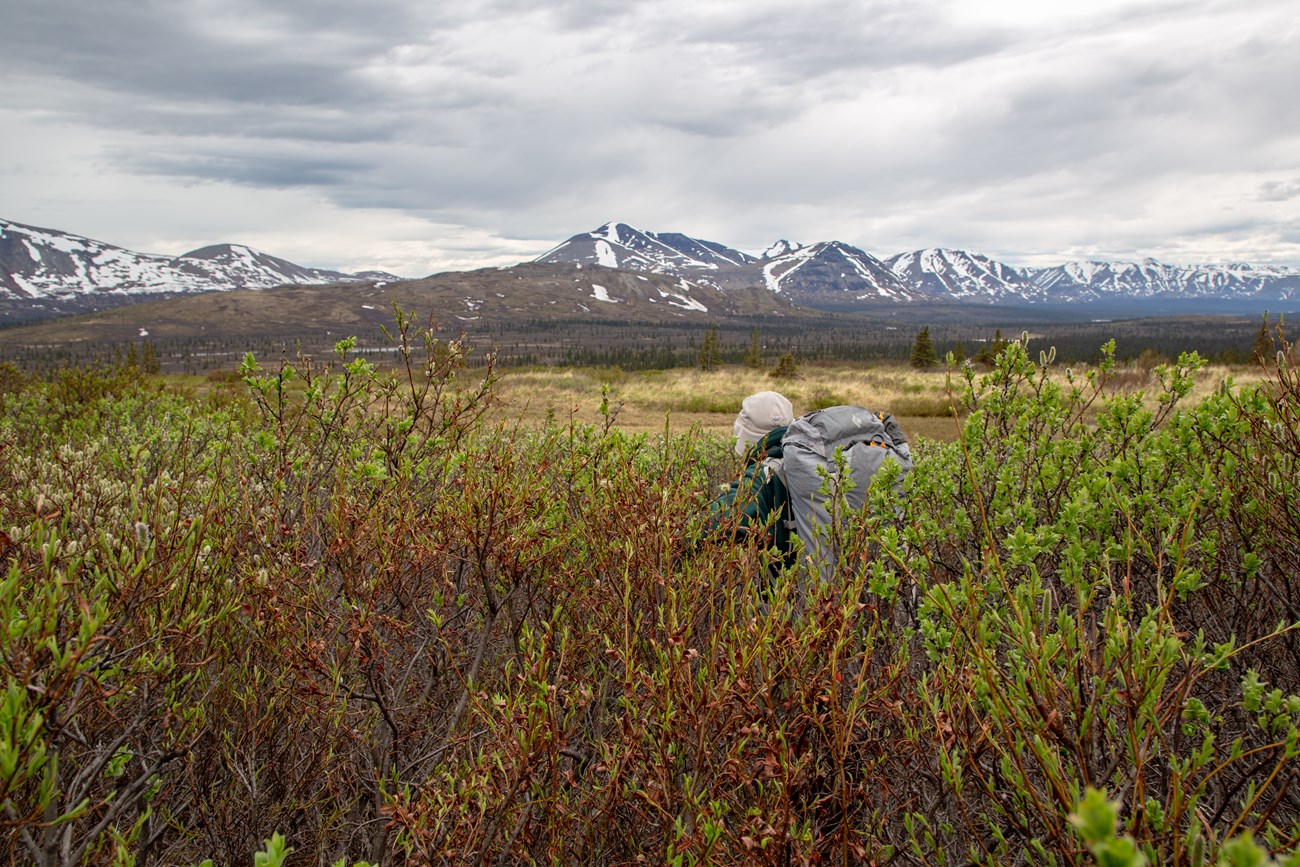
Terrain and Vegetation
There are various terrain types in Alaska’s trail-less wilderness. Plan on covering roughly one mile per hour to allow for errors in navigation, route selection and tough going. Vegetation types can dictate the difficulty of hiking and can affect how many miles you may be able to go in a day. If you're not familiar with Alaskan terrain, be prepared to turn back and try a different routes. Give yourself plenty of time to get where you're going. You may encounter the following:
Steep scree slopes with loose, sharp rocks.
Wet, muddy bogs where feet can sink into the ground up to your knees. This is often very slow hiking, usually found in low lying areas and very buggy.
Tussocks, brushy and lumpy areas with uneven terrain and “ankle busting” hopping from one frost heave to the next.
Tundra, with ankle to knee-high brush, generally more “easy going” for Alaska.
Dense brush, with expert-level bushwacking. Thick, waist-to-overhead height alders and willows. This can be very frustrating and slow going for long periods. Bushwhacking is often unavoidable and requires both practice and patience. Willow and alder habitats can drastically impact your speed. When traveling through willow habitats be cautious of objects or gear hanging from your pack, stow away trekking poles.
Fast and cold glacial waterways that must be forded by foot or packraft. Often their depth is obscured by glacial sediment.
Long stretches of exposed coastline. Be sure to consult tide tables and know whether the tide is rising or falling. If you are planning to hike along coastlines, you may have to hike when the tide is low. Be aware of changing tides and routes that may be impassable, either because large mudflats or high water.
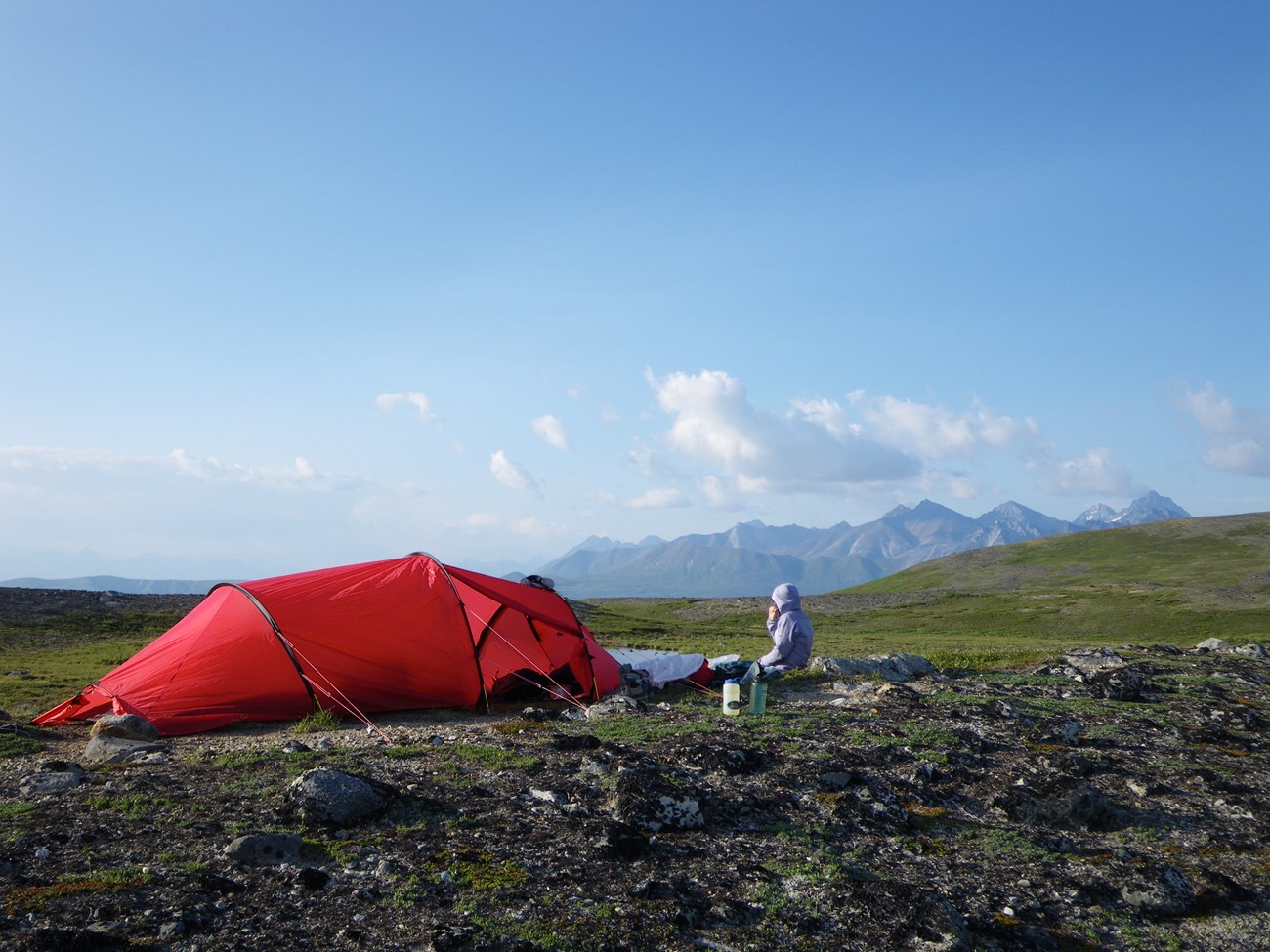
NPS / A. Lindholm
NPS / Lake Clark NP&P
Where the Wild Things Are
It takes everyone, cold, swift, remote.
Daylight: You may have heard of Alaska as the Land of the Midnight Sun and in the summer, it truly is! During the summertime, there is much more daylight for hiking. On the longest day of the year, Alaska may have approximately 14-24 hours of sunlight. During the spring and fall, areas can lose several minutes of light per day. Winter days are significantly shorter, with the shortest day having approximately 0-5 hours of sunlight. Be mindful that the actual amount of daylight varies with surrounding mountains. In areas with tall mountains, it is often dark well before sunset and remains dark until well after sunrise. If you'll be hiking in spring, fall, or winter, don't forget your headlamp! Mosquitos/biting insects: Mosquitos and other biting insects are common in Alaska. Be prepared with bug repellent and bug nets or use hats, long sleeve shirts and pants as a physical barrier to keep insects away from your skin.
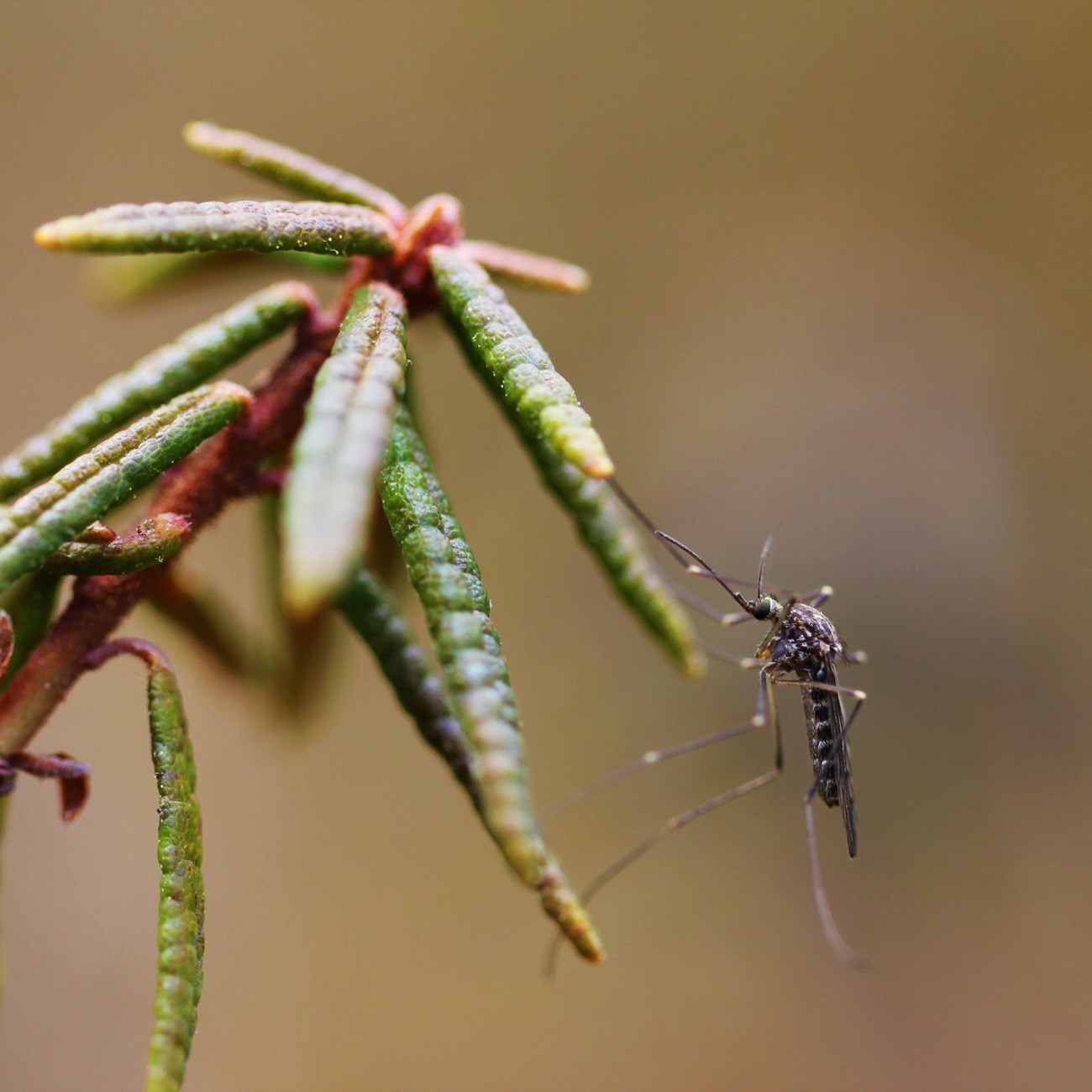
NPS / A. Kirby
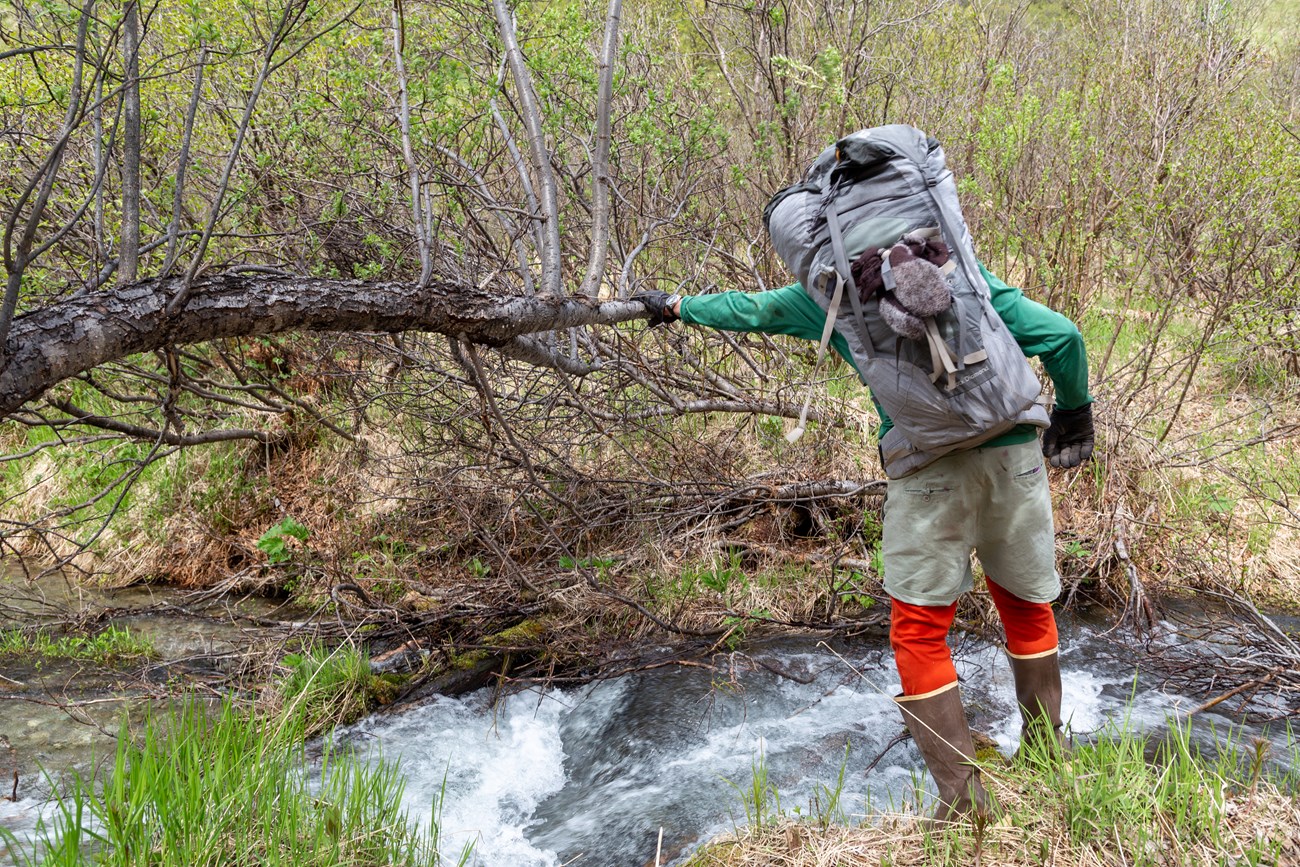
Alaskan adventures demand self-sufficiency and backcountry competence. If you master backcountry skills in this remote landscape, it may unlock a lifetime of adventure, beauty, and further exploration of America's most isolated and expansive wildernesses.
You Might Also Like
- lake clark national park & preserve
- outdoor adventure
- backpacking
Lake Clark National Park & Preserve
Last updated: October 26, 2021
- Work With Me
Home » Blog » 5 Epic Alaska Hiking & Backpacking Adventures (+ Packing Tips!)
5 Epic Alaska Hiking & Backpacking Adventures (+ Packing Tips!)
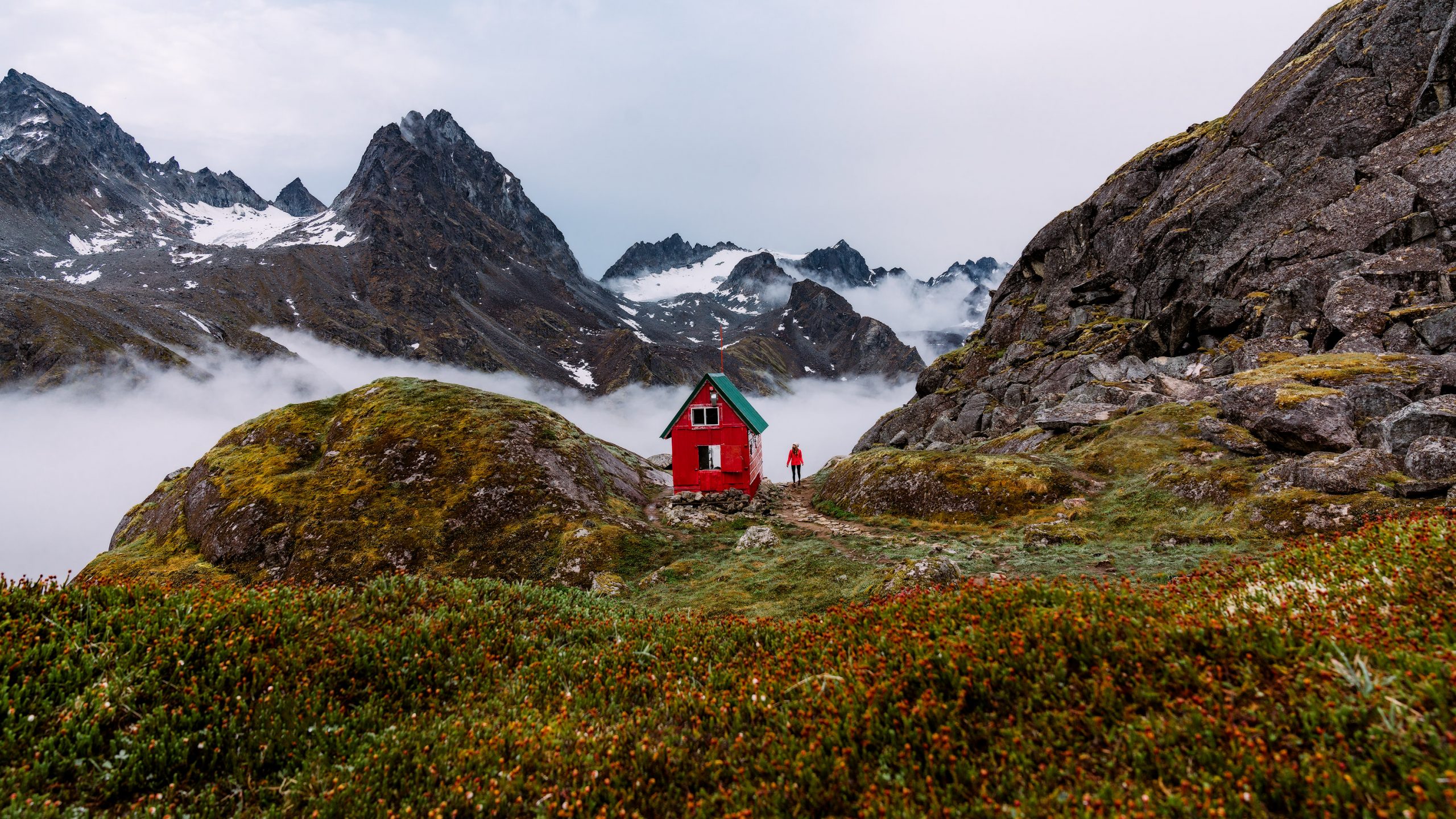
Alaska is jam packed with incredible hiking trails and opportunities for backpacking. I know it’s kind of cliche, but Alaska really does have an untamed wildness about it… and the state has some of the most rugged landscapes in the world. In saying that, you don’t have to be Bear Grylls to have your own Alaska hiking experience! In this post I have listed 5 epic hikes and backpacking trips to consider for your next visit to the last frontier (plus some packing tips!)
Sponsored by Nature Valley
5 Epic Alaska Hiking & Backpacking Adventures
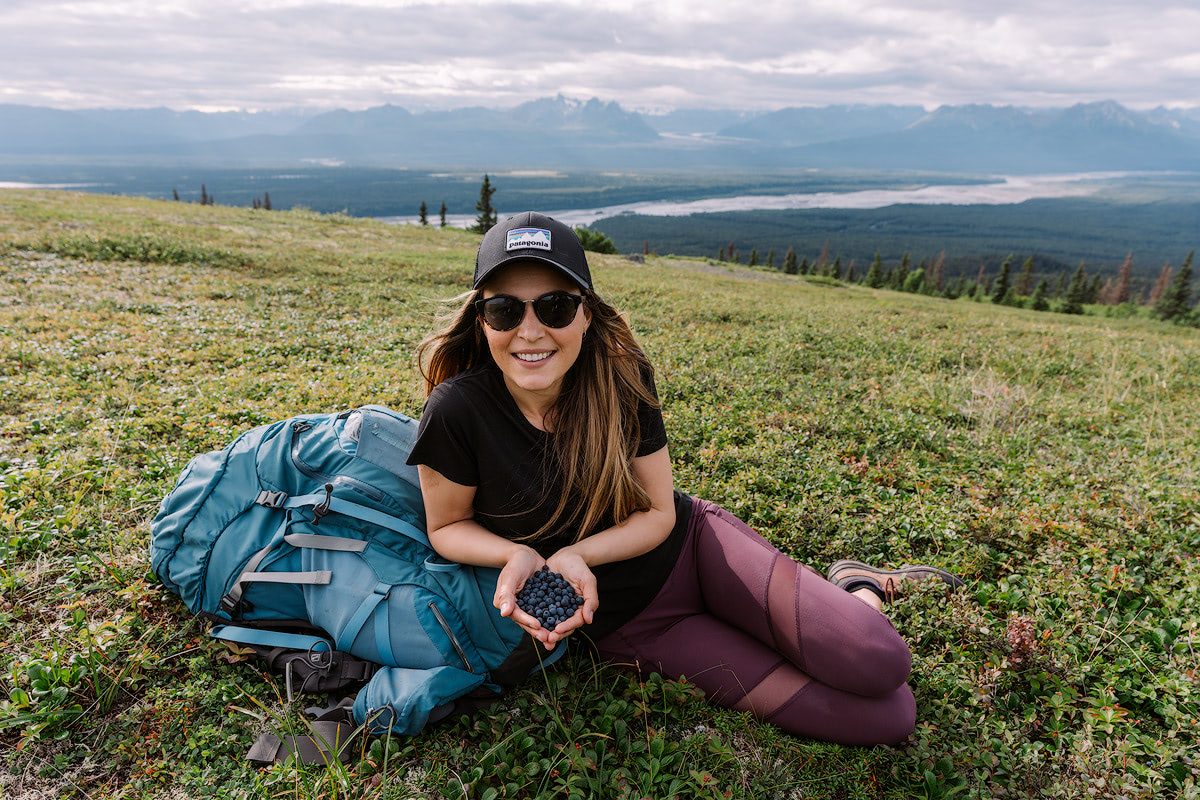
Curry Ridge, Denali State Park
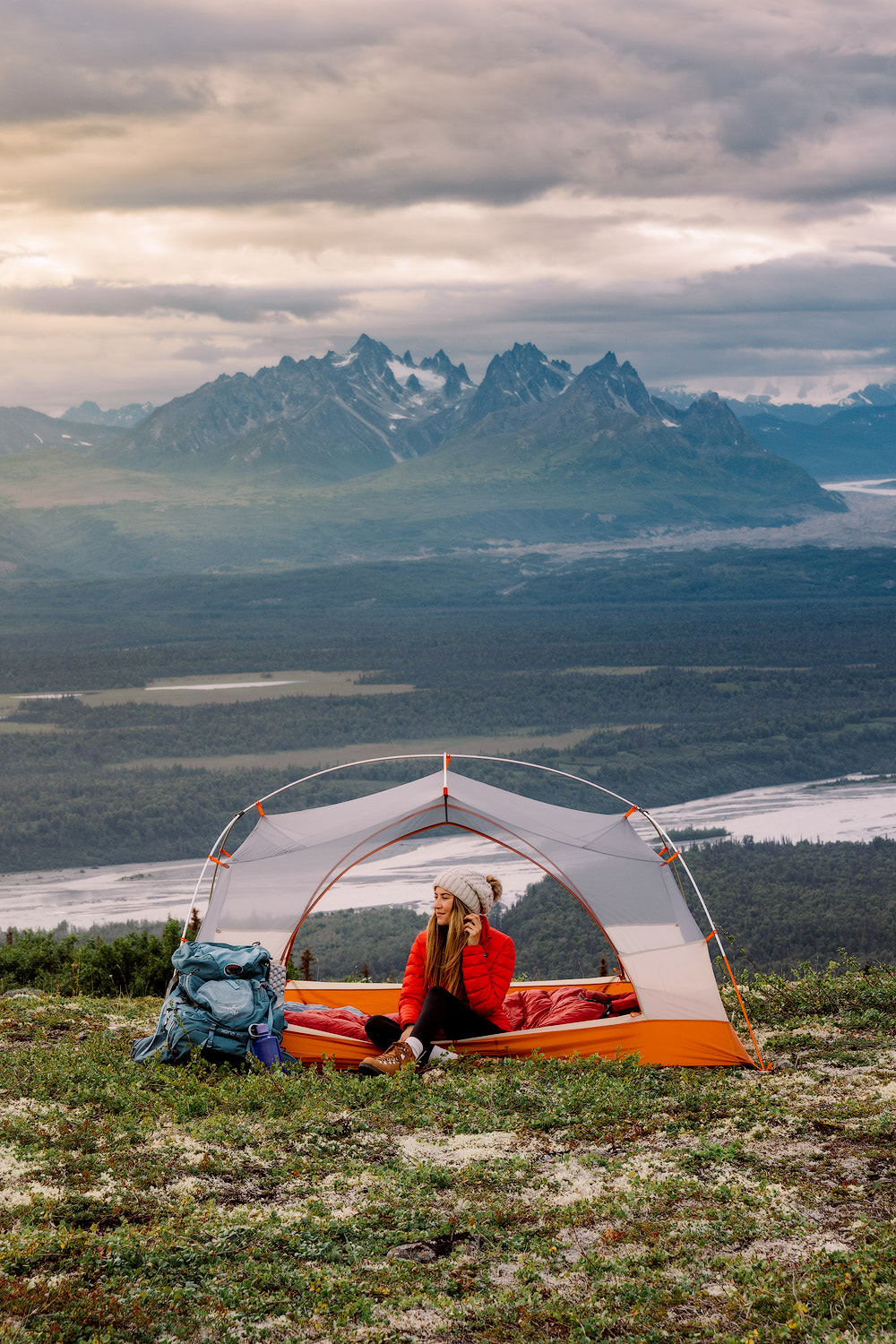
Mint Hut, Talkeetna Mountain Range
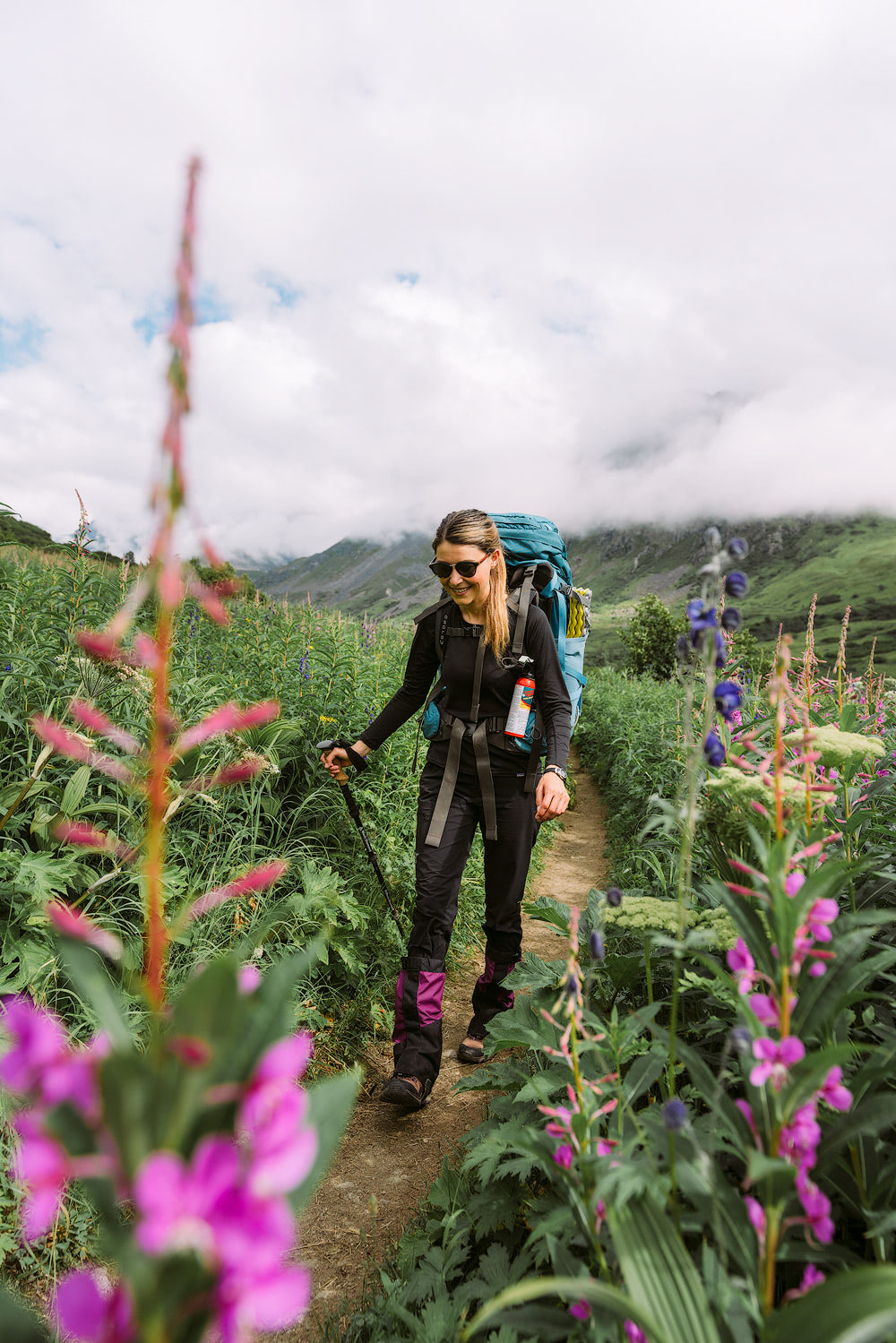
Byron Glacier, Chugach National Forest
Location: Byron Glacier Trailhead, Chugach National Forest. Distance: 2.8 miles (roundtrip) to the viewing area. Option to continue further though not advised by the USDA (due to melting snow and ice). Elevation: 100 feet gain; overall a very flat trail. Parking: Free, at trailhead. Camping: Not along the trail itself, though we were told it may be possible higher up on a ridge (off trail) – please check with local rangers first. We opted to camp at nearby Williwaw Campground ($18 a night). Details: This easy day hike offers beautiful glacial views and a well maintained gravel trail. The trail weaves through lush alder/cottonwood forest alongside Byron Creek, with numerous off-shoots to explore the water. The trail comes out at a viewing area in front of a large glacial moraine. From there it is “explore at your own risk” as the USDA reports risks involved with melting ice and snow. We really enjoyed this short hike and it made for a less strenuous adventure compared to others listed in this blog post.
RELATED: Beginners Guide to Hiking
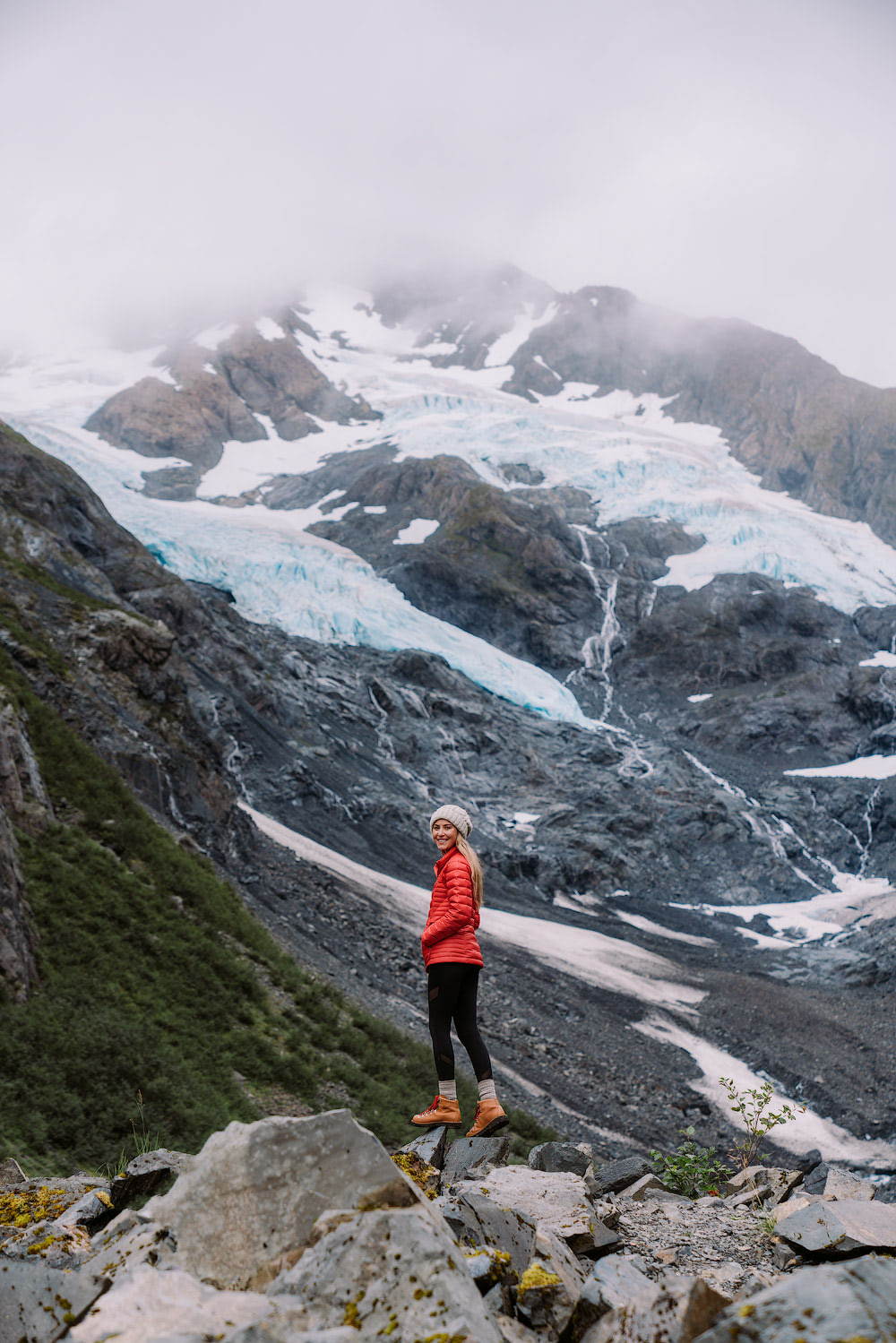
Telaquana & Turquoise Lakes, Lake Clark NP
Location: Lake Clark National Park, southwest of Anchorage. Distance: depends on the trip! (more information below) Camping: Yes, though be sure to follow Leave No Trace principles. Details: During our Alaska hiking adventure we opted to spend a week exploring the wilderness of Lake Clark National Park. Full blog post coming soon, but in short we essentially flew into Telaquana Lake, hiked over to Turquoise Lake and then base-camped there for a few days. We had planned to extend our route to Twin Lakes but circumstances didn’t allow for it. Our trip was guided by Expeditions Alaska and I wouldn’t recommended venturing into the park without a guide or solid knowledge and of the area and adequate route finding skills. Keep in mind that the park doesn’t have any marked or maintained trails and most routes involve bushwhacking and stream/creek/river crossings. Watch this space for a more in-depth blog post on our trip!
RELATED: Get a Good Nights Sleep When Backcountry Camping
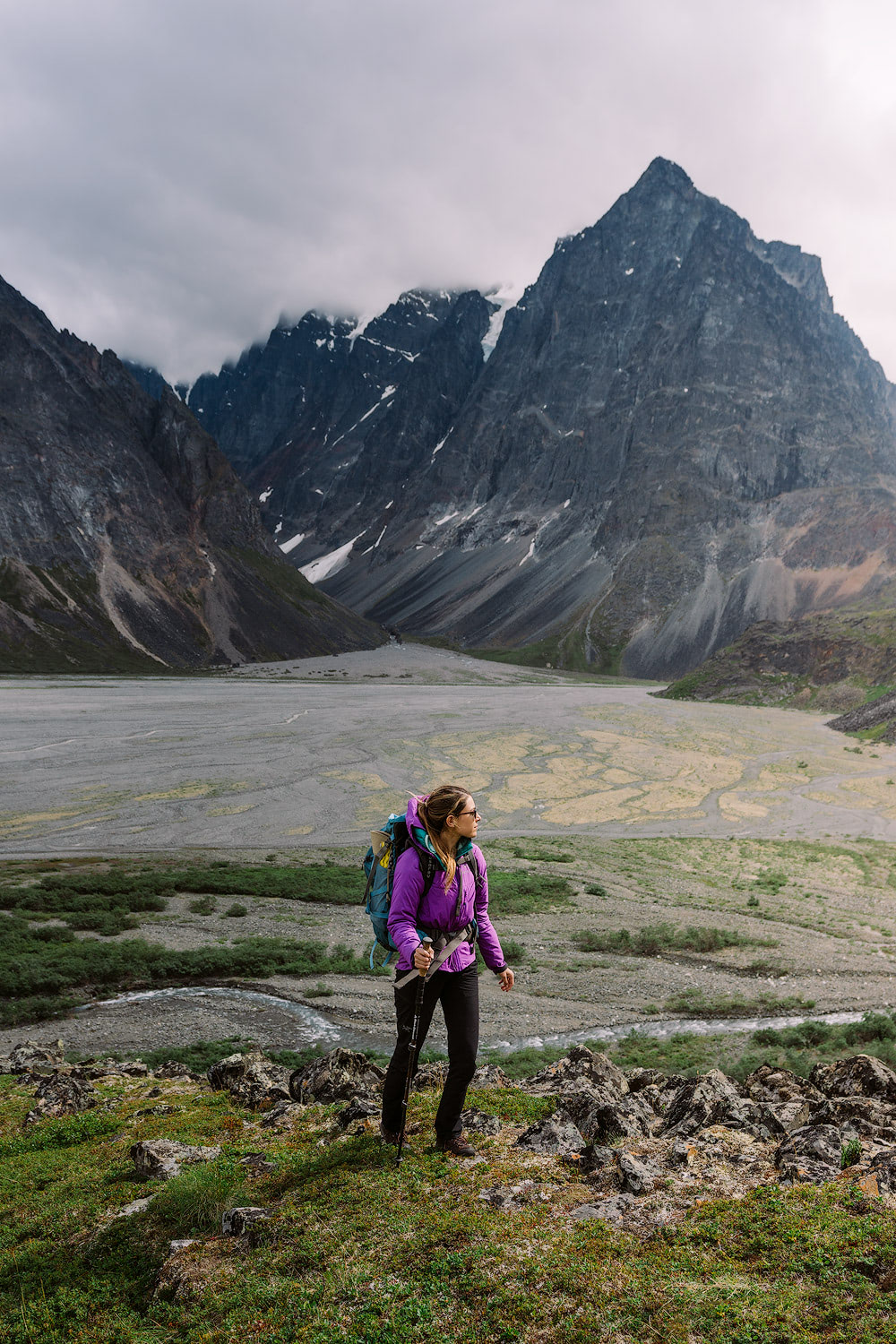
Harding Icefield, Kenai Fjord NP
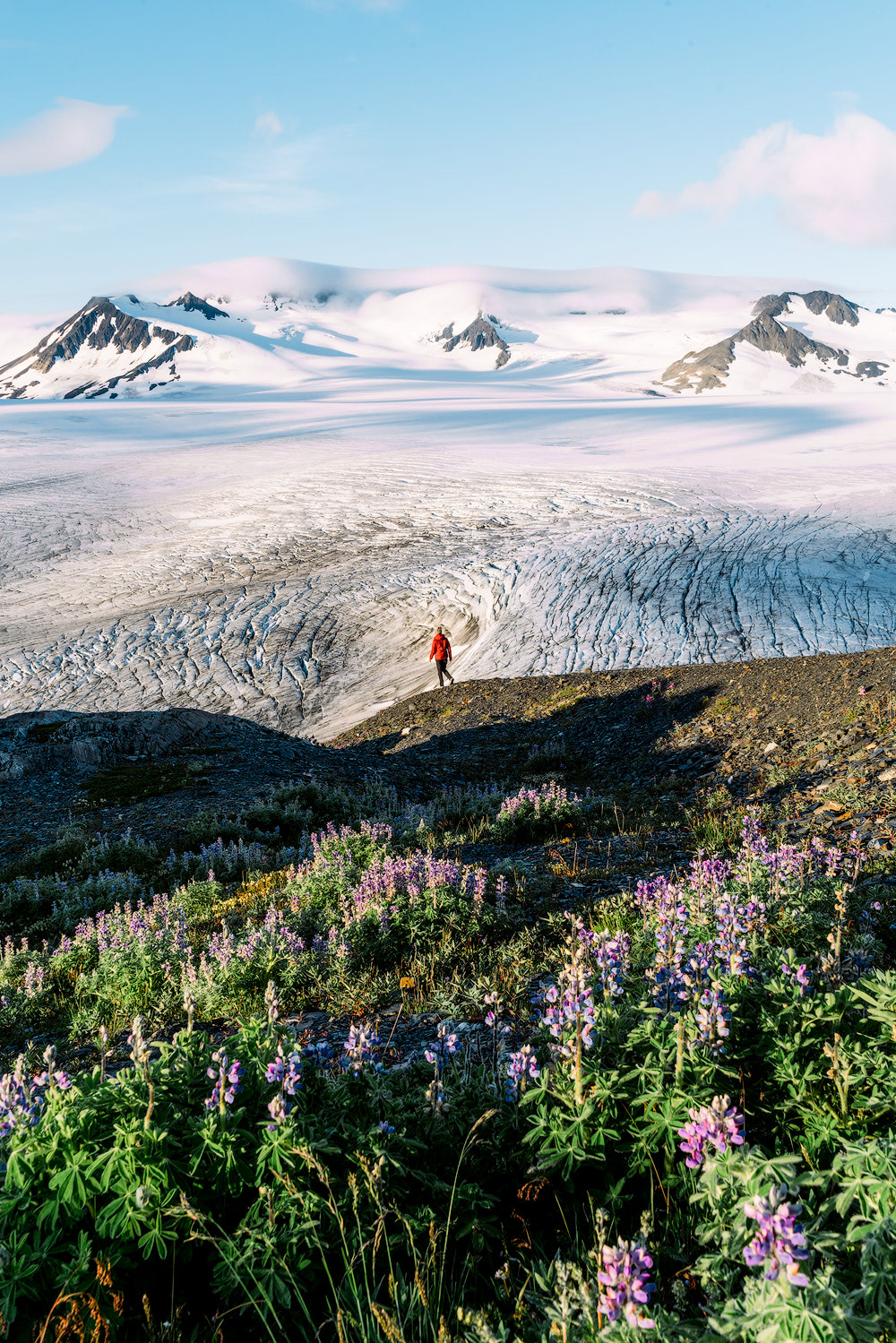
Alaska Hiking Packing Tips
Alaska hiking and backpacking can be more rugged compared to other popular places in America (in my experience). Often there aren’t “trails” as such and some bush-whacking might be involved. It’s also important to be prepared for rain and sub-optimal conditions. Be prepared for temperatures ranging from 30° to 80° F (-1° to 27° C) in the summer months. Here are some items that are recommended:
- Rain jacket and pants
- Sturdy waterproof hiking boots
- Warm layers (insulated jacket and fleece) – avoid cotton
- Quick dry hiking pants (avoid shorts on brushy hikes)
- Quick dry long sleeve hiking top (to protect from sun, bugs and brush)
- Sun hat + warm hat/beanie
- Gloves (a waterproof cover/layer would also be optimal)
- Wool or synthetic hiking socks
- Backpack large enough for your gear, with rain cover (or a dry sack inside
- Ankle/knee height gaiters (optional but I found them to be very handy)
- Trekking poles
- Insect repellent
- Mosquito head net
- Map, compass or GPS device
- Emergency gear, such as small first aid kit, knife and a signaling device such as a whistle
- Camera/phone with waterproof case or dry bag
- Snacks (we love the Nature Valley Sweet & Salty Bars! )
You can check out my Beginners Guide to Hiking for more advice on gear recommendations!
Additional if planning to camp:
- Bear Resistant Food Container (BRFC)
- Dense, high-calorie food that fits in the Bear Resistant Food Container
- Long underwear
- Stove, fuel, and cookware
- Water bottles/bladder
- Water filter or purifying tablets (also good for longer day hikes)
- Toilet paper, trowel and a bag for used toilet paper
- Tent with rain fly and waterproof floor
- Sleeping bag and pad (protection to 20° F/-7° C is suggested even in summer)
- Sleeping pillow (or you can use your jacket
- A change of shoes for camp to change out of wet boots
- Toiletries such as toothbrush, hand sanitizer, and lip balm
Check out my Beginners Guide to Backcountry Camping for more gear information!
Leave No Trace
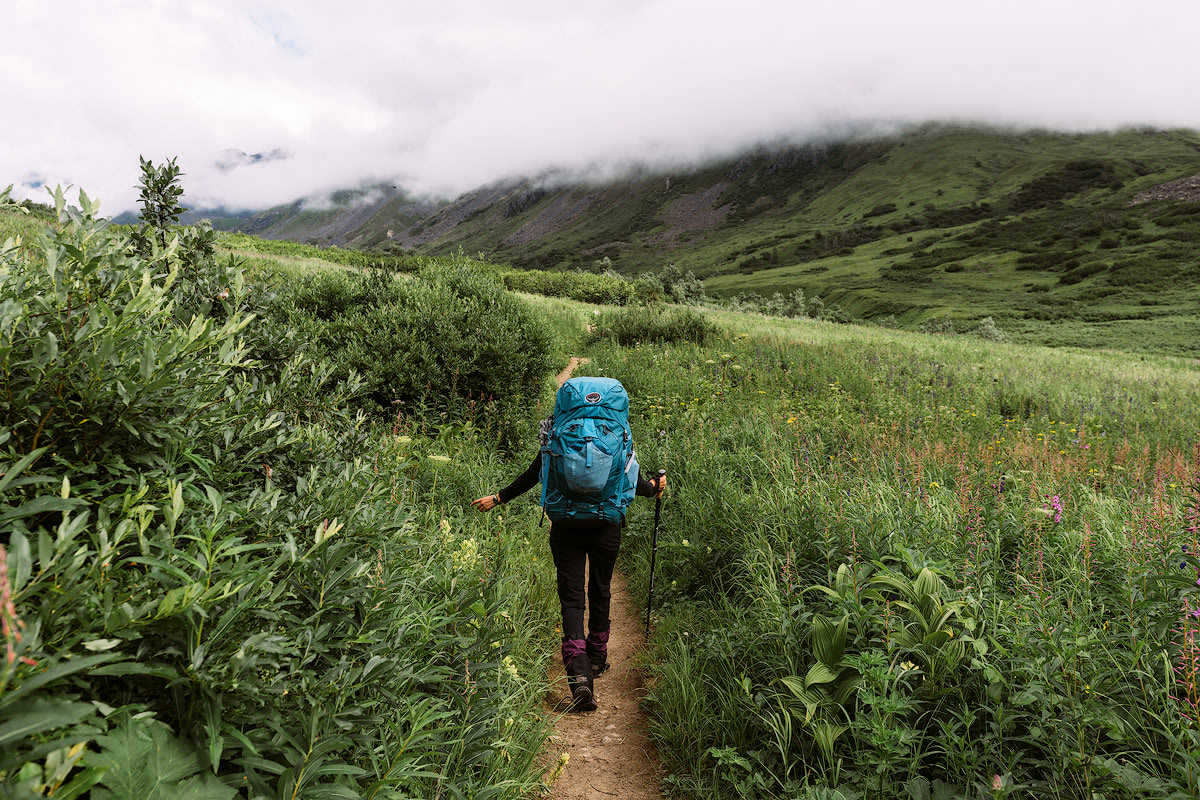
I hope you found this article to be helpful! Here is a little video I put together from our adventure.
Hiking and Camping Tips
A Beginners Guide to Hiking
A Beginners Guide to Backcountry Camping
How To Get Over Your Fears of First Time Backcountry Camping
9 Tips for Getting a Good Nights Sleep When Camping
Eco-Friendly Outdoor Hygiene Tips for Every Hiker and Camper
Top Tips for Sleeping in Your Car on Road Trips
PIN for later!
Disclaimer: Thank you again to Nature Valley for partnering on this Alaska hiking post. As usual, all opinions are my own and unbiased.
Related Guides
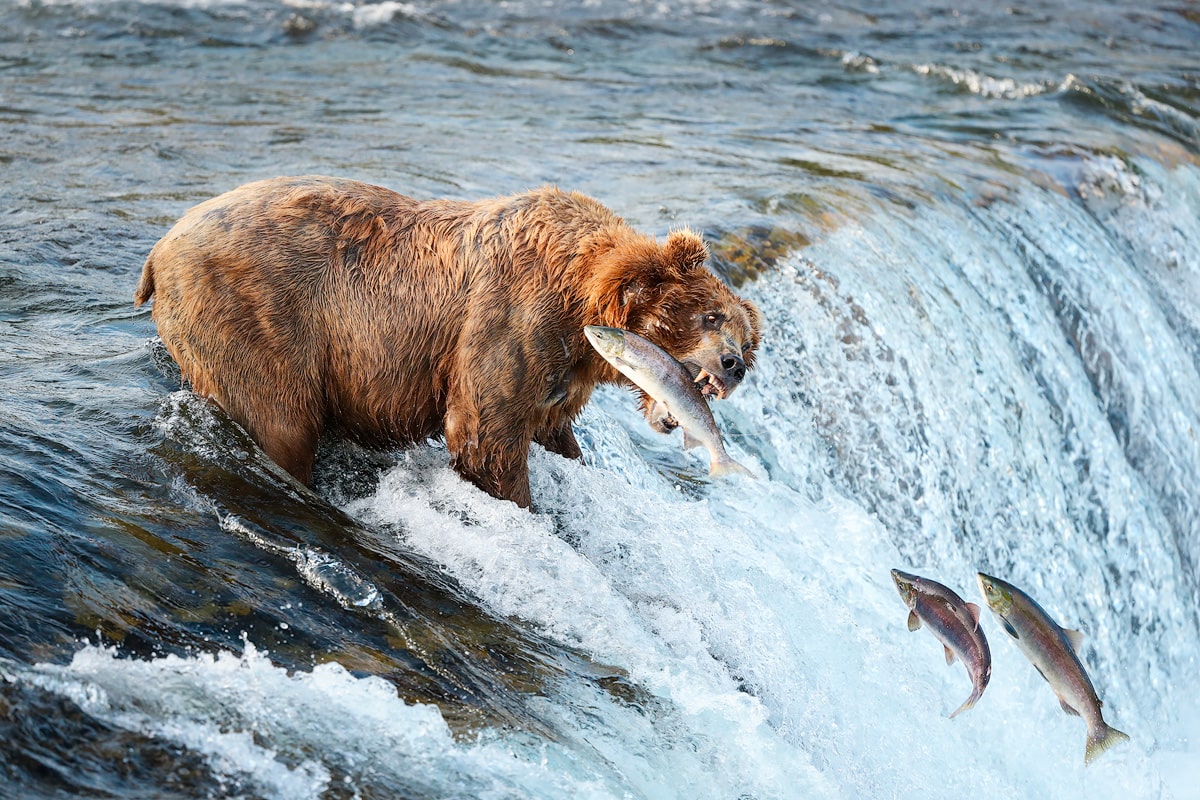
How To Visit Katmai National Park – A Comprehensive Park Guide
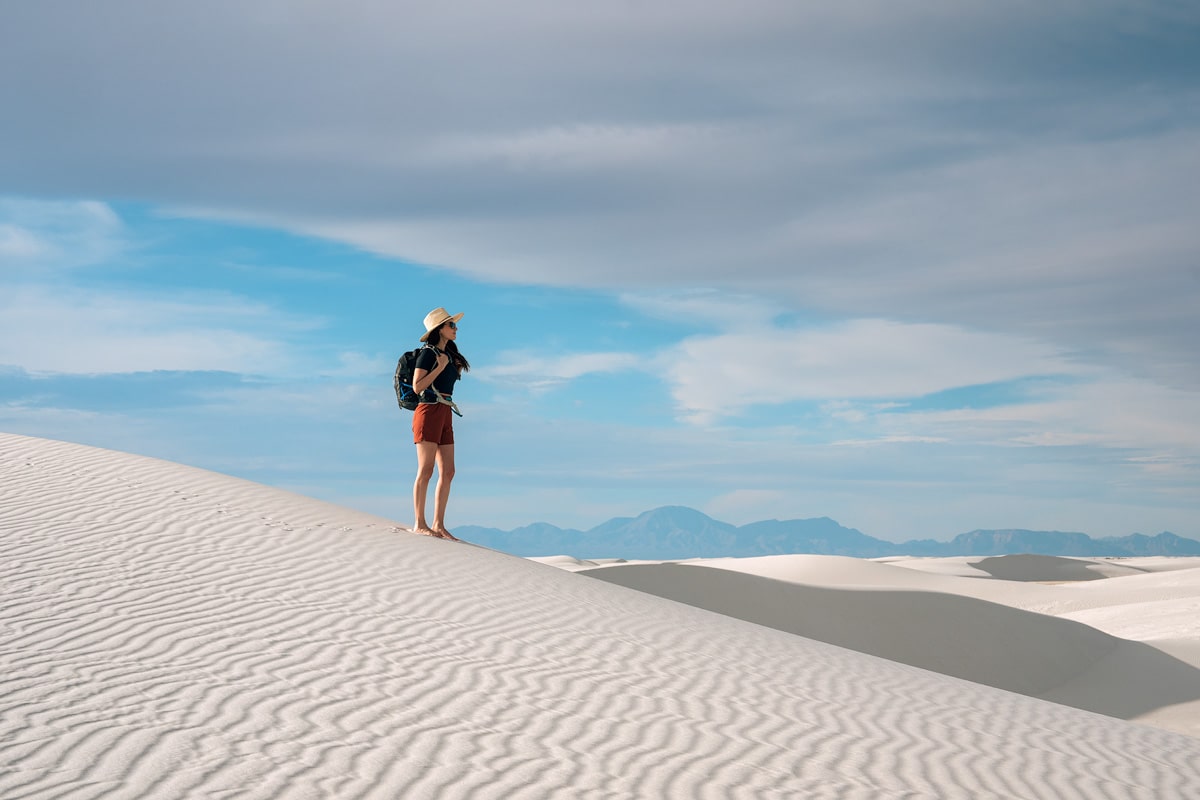
Best Things To Do In White Sands National Park: Epic 1 Day Itinerary
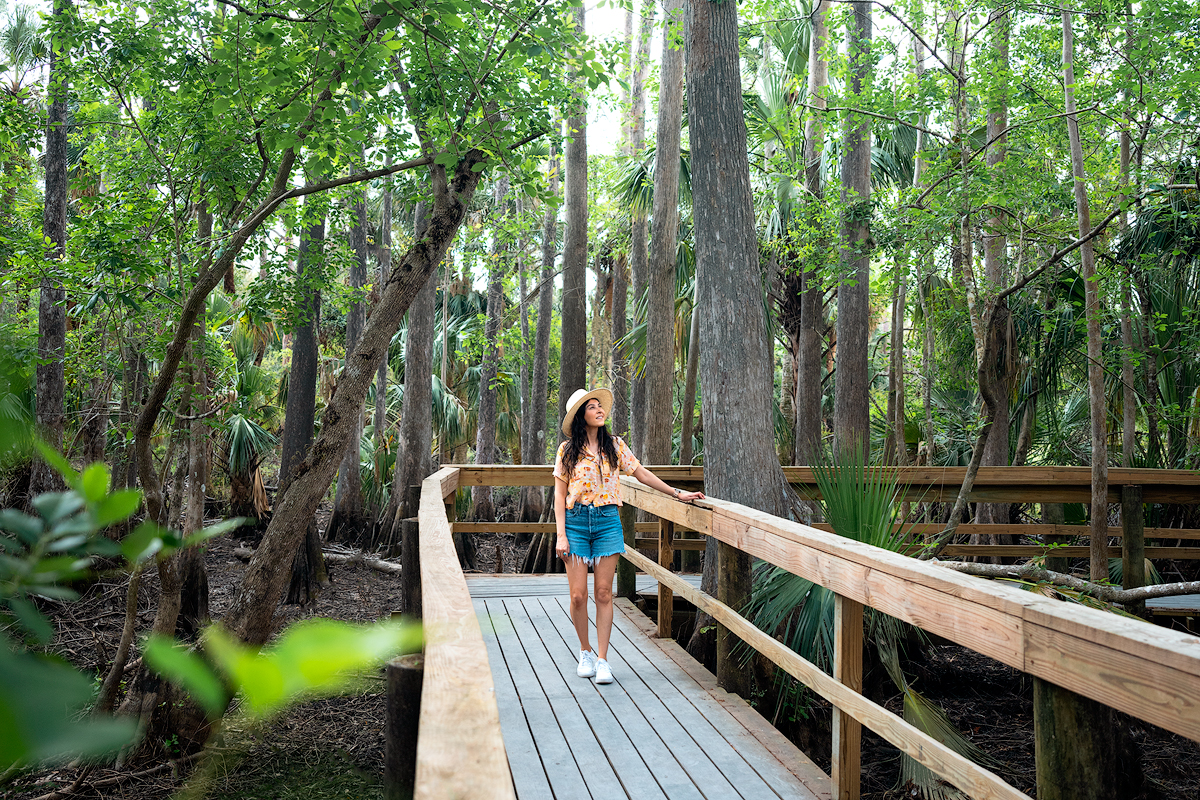
Discovering the Best Things To Do in Punta Gorda: Florida’s Hidden Gem
Join our mailing list for exclusive resources, events, and more.
Thank you for subscribing!
Leave a Reply Cancel reply
Your email address will not be published. Required fields are marked *
This site uses Akismet to reduce spam. Learn how your comment data is processed .
Follow Along on Instagram

- Information
- About Alaska
- Meet Your Guides
- Our Testimonials
- Why Choose Us
- Arrigetch Peaks
- Canning River Rafting
- Sea Kayak Icy Bay
- Above The Circle (NEW!)
- Adventure To Oz
- Decadent Denali (NEW!)
- Seven Pass Route
The Southern Traverse
The northern traverse.
- The Goat Trail
- Photo Tours
- Alaska Landscapes
- Aurora Borealis
- Bald Eagles
- Brown Bears & Coastal Wildlife
- Brown Bears of Summer
- Fat Bears in the Fall
- Grizzlies in the Mist
- Northern Lights in the Fall
- Polar Bears
- Hungry Whales Photo Tour
- Backpacking
- Packrafting
- Sea Kayaking
- Snowshoeing
Where We Go
- Arctic National Wildlife Refuge
- Denali National Park
- Gates of the Arctic NP
- Lake Clark NP
- Wrangell St. Elias NP
- Eye of the Beholder
- Expeditions
- Gates of the Arctic
- Wrangell St. Elias
- Grizzly Bears
- Guests Gallery
- Northern Lights
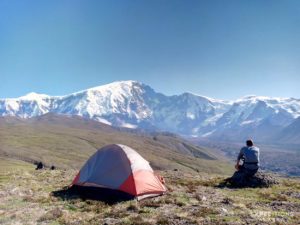
- Explore Our Trips
Denali Backpacking Trip
Backpack to the future. our newest trip to alaska's oldest national park.
- Backpacking Denali National Park
- Experience Denali National Park like few others do
- Go backpacking beside North America’s tallest mountain
- Guided by Alaska's backpacking professionals
- Step into pure wilderness
- Adventure across the Alpine, no trail required (or available)
- Stunning 360 degree Mountain Views
- Customize your trip with basecamp and through-hiking options
Everybody loves Denali. The Great One.
We love it too.
We’ve wanted to put a Denali backpacking trip together for you. For a decade we’ve wanted to bring you here. So we explored a couple of options recently and this one crushes. Totally crushes.
You wanna watch the sunset, ebbing behind the highest mountain in the country? You wanna scramble along some of the loneliest alpine ridges in Alaska? You wanna camp alone in the mountains and feel like you belong here?
Decadent Denali backpacking trip will be a perfect fit for you.
Denali National Park & Mt. Denali
It’s all about ‘the mountain’ , as the locals refer to Mt Denali. Few folks in Alaska call this magnificent mountain anything other than Denali. This derives from the native Athabascan name, meaning “the Great One” . Most days, we call it ‘the mountain’ .
A breathtaking sight.
Nothing will mesmerize a lover of the outdoors more than hiking beneath Denali. Our guided backpacking trips in Denali National Park are an opportunity for solitude, for wildlife viewing and photography. Majestic vistas and fantastic backcountry travel make this trip special. You’ll know it when you feel it.
Towering over 20 000′ high, Denali oversees our entire trip. The highest peak in Alaska, indeed in all North America. Denali’s power is omiprescient. On a beautiful Alaskan summer day, Denali is visible from hundreds of miles away. Other times it lies shrouded in clouds created by its own bulk. You feel an edge for the entire backpacking trip, alert for a glimpse of this natural wonder.
Wildlife are present, but not plentiful here. The park is often referred to as “America’s Serengeti” , yet that’s a bit of a misnomer. Life in the subarctic is hard, and population densities this far north are never high.
That said, Denali is still the premier place in Alaska to watch caribou, grizzly bears, wolves, moose, and Dall sheep. Golden eagles, wolverine, red fox, marmots and pikas, etc, also live within this park. Denali National Park is a stunning hiking trip and you’re never quite sure what you might see. Bears are abundant here.
Your Denali Backpacking Trip
We’re not hiking in from the road in Denali National Park. Our backpacking trip goes deep into the wilderness of America’s oldest National Park and explores an area few people ever visit. We fly. We backpack. We fly home.
Though Denali is easily the most popular national park in interior Alaska, and backpacking numbers dwarf any of the other parks we visit ( Wrangell-St. Elias National Park , Gates of the Arctic National Park , Lake Clark National Park , etc), we won’t see anybody here. Because nobody, not even the most ardent backpackers and explorers, makes their way here.
We’ll bring you into the park on our Denali backpacking trip and you’ll see a region of the park that is simply superb. great views of the mountain (weather permitting, of course).
Catch the park in all its fall glory in late August and early September. The tundra puts on its blazing show. A myriad of golds, yellows, reds, and every possible combination of these glowing colors. A week of backpacking in Denali National Park is a lifetime of memory. You’re in good hands. Our experience and knowledge of the area ensure you can best utilize your time here.
Relax and enjoy ‘The Great One’ .
This one is for you.
Trip Details
The backpacking is endless in this area. You’ll explore the high country, traversing ridges and walking up valleys. The hidden gems of the area are right outside your tent.
From our drop-off point, we hike to camp. It’s a steep little sidehill, and a solid hit out to get you started.
Thereafter, it’s gold.
The walking here is a mix of everything. Tundra, scree, brush, plateaus, creeks and moraine. If diversity is a strength (and we think it is), this Denali backpacking trip is one of the strongest yet.
We’ll backpack and explore the area bit. Rhane checked it out recently and came back eyes wide open and mouth agape, “Carl, you gotta get in here” . So here we are.
It’s a good fit for folks who can backpack, are comfortable on different types of terrain and bring a flexible mindset on what a trip like this looks like. If you’re a “on day 1, at 3pm, what do we do?” kinda person this one might not be for you. Yet.
If you’re an adventurer, a backcountry-capable and fit, durable kinda person, who wants to explore an extremely rarely visited area in this most famous of National Parks, tag us.
We’d love to bring you along.
We’ll meet you in Talkeetna, a tiny town with a giant personality, and the gateway to all things Denali. We’ll fly from Talkeetna to our drop-off point in the park. After the trip, we’ll return to Talkeetna for one night.
We strongly recommend that you schedule your departure flight from Anchorage for the following night after 8pm or, safer, a day later. Alaska’s weather likes to upend itineraries. So, in case we need to spend an extra night in the backcountry until our air taxi can pick us up, it’s best to build in an extra day in Alaska from the get-go.
Trip insurance is required.
Is This a Fit For You?
Who’s it for.
Adventurous experienced backpackers. Intermediate level, with advanced option.
Confident, durable and fit people.
Any wilderness backpacking trip can throw a curve, even those we’ve hiked for more than two decades. Trips we’ve seen less of can be even more challenging to navigate. Newer backpacking trips tend to have more variables we haven’t yet dealt with. We want to be comfortable with changing plans and conditions.
Not everyone can do that. Fewer people still can do it well.
Weather is always a challenge in the Alaska Range, and particularly up above treeline. Be ready for everything Denali can throw at you. Wind and rain, more rain, snow, sleet, fog, more wind and rain, and (fingers crossed) some gorgeous blue skies.
Terrain is everything. You need to be confident in your balance, comfortable with a heavy load on your back. Be able to navigate varying and steeper hillsides. The Alaska Range don’t play.
Sidehilling is your biggest challenge here. So be good on your feet.
How'd we find this spot?
With a LOT of patience and scouting and exploratory diligence.
It takes time to really get into the weeds using satellite imagery, a boatload of topo maps and way too many hours of close scrutiny of terrain and topography and the lay of the land.
Then we sent 3 different guides into the park to find what goes and what doesn’t.
This one goes.
Let's Talk Difficulty Ratings
How difficult is it?
It’s this difficult. ->
This is Rhane’s mom, on our scouting trip. She crushed it, but really enjoyed this rock for a break spot.
A good rock needs to be sat upon.
Denali & Wildlife
Denali National Park & Preserve is home to some of the best wildlife viewing in the nation, but this particular area we travel is the high country. It’s more rock and ice and tundra than lush rich wildlife habitat.
Denali National Park is a stunning hiking trip and you’re never quite sure what you might see.
That said, bears live here, so black and brown bears are present, as can be wolves and even moose and Dall sheep. Caribou don’t tend to be in this area. Foxes and other small animals are often seen here too.
Sidehilling doesn't sound too bad
Sidehilling doesn’t quite “sound” like what it is.
When I say “bushwhacking” or “river crossing” , people seem to have a good sense of what that feels like. Sidehilling is a bit deceptive. it’s more challenging than it sounds. And it’s more challenging than you think it is.
Fortunately, we don’t have too much. Maybe a mile or so.
Backpacking and Basecamping
We’ll have a couple of versions of this trip.
A Denali Backpacking trip that works for those who really wanna get after it. We’re offering both 7 and 10 day backpacking trips for you folks who want to boot up and get walking. You’ll want to be a solid backcountry backpacker.
We can adjust these and tweak the itineraries if needed. So if you want something a little longer, or maybe a little shorter, give us a holler.
We’ll also have a basepack trip, 5 days, for those who want to fly in, backpack a short walk to camp, make a great campsite and explore the countryside. If this is you, let me know .
BACKPACK OR BASEPACK
An adventurer’s backpack.
A backpacking loop brings us back to our landing spot. There are options to do this over 10 days, or cut it shorter and just do 7.
The 10 day trip is a bit gnarlier. Be on top of your game for this one. We have a couple of high, rugged passes to traverse. Don’t be intimidated. But be comfortable on mountain terrain.
This longer one is going to be a bit exploratory in 2023. It’ll work well for those hardy, experienced, fit backpackers who really like to explore something new. If this is you, reach out to us.
7 Day Backpack
The 7 day is a good intermediate version, for those who can walk and carry their gear through most terrain.
Most of the hike is pretty good walking, with little adversity beyond the normal challenges (carrying 40 pounds on your back is hard)! We have plenty of time.
This trip will work well for most folks who can backpack. This is NOT for those people with no backpacking experience.
The Basepack is not for non-backpackers.
You’ll have to backpack a few miles from our landing strip to a campsite. And it’s a challenging hike. Steep sidehilling. Then we set up camp and walk and hike and camp and eat and sleep and watch the mountain all day long. Then we return the way we came to meet our pilot.
The first 3/4 mile or so is hard. So don’t think “oh this one looks like me, it’ll be easy”. This is a good choice for those folks who CAN backpack, but want to avoid the hassle and physical stresses of moving camp every day.
This trip is a new one for us, so we’re approaching it in 2023 with a “keep on your toes” mindset. We scouted it in 2022 and are sure this trip is set to be a firm crowd favorite.
We’ll plan on meeting you in Talkeetna, Alaska.
Why Talkeetna? Because it’s one of the hippest little towns in all of Alaska. That’s why.
From there we gear check and review, and then fly in to the most famous National Park in all of Alaska, and one of the most famous parks in the world.
Backpack and basecamp and backpack and basecamp.
Fly out, back to Talkeetna, overnight and depart.
Schedule your departure a good 24 hours later. Not the following morning, but no sooner than the following evening. Give yourself a day, or 2, in Talkeetna at the end of the trip, rather than the start. It makes life a lot less stressful in the backcountry when the weather turns south and our air taxi can’t come get us til the next morning.
We have 3 trip models this year. i) a shorter basepack for those of you wanting a sample ii) A weeklong backpacking trip looking to soak up the view. iii) a 10 day trip for those rockstars looking to get after it.
Which one is the right fit for you? Read More
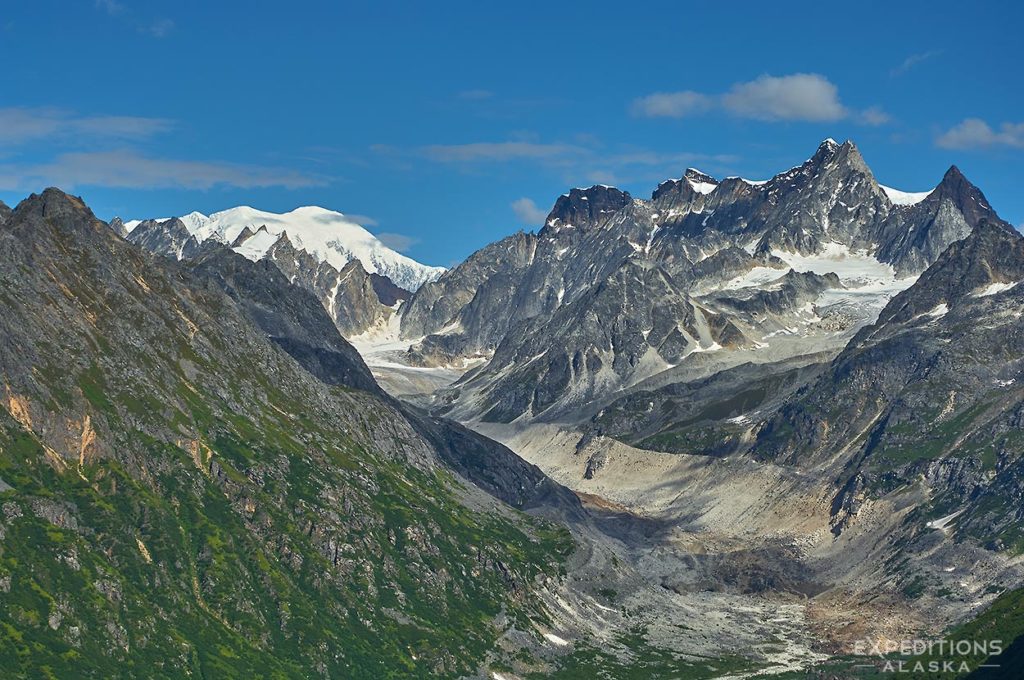
How do we get to Talkeetna?
There are a few options. A number of shuttles run daily Anchorage – Talkeetna, and that’s probably your best bet, saving a rental vehicle, etc. you don’t really need a car in Talkeetna, but if you want to spend the cash, and can get a vehicle, it does make life a little easier and more flexible.
Shuttle Service through Alaska Shuttle .
Denali Overland is a great choice with daily runs between Anchorage and Talkeetna as well.
You can also take the train from Anchorage to talkeetna, which might be a fun adventure. More info is available here.
Bus schedules can be found here .
Is there any fishing here?
How much experience do i need.
It’s hard to say precisely, but if you’ve not backpacked before, it might be a good idea to go try it before flying into one of the largest and wildest national parks in the country and walking around with no trails.
That said, we have definitely had plenty of folks with no experience do just fine on even challenging trips, so it’s a very subjective thing
Do we include Lodging in Talkeetna?
Yes we do. It varies, but we usually include the final night of the trip. Some years/trips it might be the first night, we’ll let you know as we make those arrangements.
How are the difficulty ratings defined?
Well, “ defined ” probably isn’t the right word. This is Alaska after all. But this an important question to consider.
Go to whichever trip you would like to learn about. Click on the little hiking boot icon in the sidebar for whichever backcountry trip you’re considering and you’ll see the discussion for that particular level of trip.
One boot equals easiest and five boots the most challenging option. Thanks.
As a general rule I’d suggest rating everything here one notch HIGHER from what you might be used to (assuming you haven’t hiked in Alaska before). If you consider yourself up for an intermediate level hike assume that a trip rated intermediate here will probably be a bit tougher than you’re expecting. Not impossible, but harder than you think.
As I mentioned above, terrain is the biggest factor here and it’s extremely subjective as to what is difficult terrain and what is not.
Some people really struggle walking over a boulder field, and others don’t find it difficult at all. Some people find sidehilling more difficult, or bushwhacking, and so on. Well, everybody finds sidehilling difficult. But the most common element people struggle with is almost always terrain. Your balance is probably a more important consideration than how miles you run on a treadmill each day in the gym.
One of the best ways to lower a rating is simply give yourself an extra day or 2. Make a 5 day hike a 7 day hike and it’ll much more manageable. Conversely, if you want a challenge give yourself a little less time and you’ll find just about any trip here as challenging as you could want it to be.
Again: please carefully read over the difficult rating discussion for your particular trip . It’s the boot icon in the sidebar of the trip page.
What gear do I need?
You’ll receive a Trip Departure Packet upon your reservation with a detailed Gear section and a comprehensive Gear Check List for you. Read it carefully and be sure you have the appropriate gear with you. We’ll do a gear review before your trip but you really should contact me with any questions you have before you arrive in AK.
You’ll find tons of information on gear and related stuff on the blog . You’ll find some extensive commentary there about gear and backpacking and hiking trips, etc. Rain gear and keeping dry , down versus synthetic sleeping bags , backpacks , and so forth. I update it reasonably often, so do check out the blog posts for information. Here is a link to The Gear Category on the blog.
In the meantime this should help you get started below.
Bring a sturdy backpacking tent. Lesser ‘car camping’ tents can fail miserably when you need them the most. If you don’t have a tent, or aren’t certain, please inquire with Expeditions Alaska. We’ll rent you a tent if you prefer.
Good rain gear is a must. I recommend a lightweight, gore-tex type shell. A poncho-style rain jacket or shawl is NOT recommended (as in, DO NOT BRING ONE).
A sleeping bag that will keep you warm down to 20deg (F) is what I suggest (or lower). A 32deg (F) bag would be considered bare minimum for most Alaskan summer adventures and I do NOT recommend it. Either synthetic fill bags or down bags are great – you just need to keep them dry. Read more about your sleeping bag here .
Unless you’re booking a fully outfitted trip you’ll need to bring a reliable stove. Bring a reliable stove, preferably one that burns white gas, or Coleman fuel. MSR ‘ Whisperlite ‘ or similar stoves are great. Remember that with current restrictions on air travel it is illegal to bring fuel onto commercial planes. I can provide fuel for you, available when you arrive in Alaska.
Another stove that’s very popular recently is the Jetboil .
My preference is for long sleeve shirts and full length brushed nylon pants. A mosquito headnet is also recommended for those times when the bugs get gnarly.
Do NOT bring cotton pants, shirt, socks, etc. If you’re confused about this, contact me .
Trekking poles are worth their weight in gold. Don’t head for Alaska without them. Expeditions Alaskan provide these (free) if you like.
Definitely bring sturdy, waterproof boots. Your lightweight day hikers may be fine around town but they are often not durable enough to withstand a multi-day alpine adventure. Alaska Hiking boots info .
A comfortable backpack is required and a system for carrying gear on a dayhike is very handy. Many backpacks have removable tops and these work great. A rain cover that fits your fully loaded pack is a must have!
Another choice for is a small summit pack for dayhikes. I use the Marmot Kompressor. Not requisite but handy to have.
The single most important element of gear is your ability to use it.
Practice with your equipment before heading into the backcountry. Do not wait until you’re miles into the wilderness before you realize your stove doesn’t work or that you don’t know how to set up your tent. Being comfortable with your equipment and how to use it can be paramount to a safe and enjoyable trip.
Do you have a Gear Check List?
Oh yeah. Right here
Upon your reservation I’ll also send out a detailed Trip Information Packet with more than enough information on gear to keep you busy. Until then the above check list is a good outline of what you need.
Tell me about this “off trail” backpacking?
Typically, it doesn’t mean we go “off the trail “. It means there is NO trail. These are two very different things.
Offtrail hiking, or no trail hiking, is hard at times, easy at others, and very hard at others. It’s almost always changing, and not something you should dismiss as irrelevant. In fact, it’s probably the single most important thing to understand about our backpacking trips .
I’ll say that again. Louder. It’s probably the single most important thing to understand about our backpacking trips.
When we say offtrail backpacking we’re talking about traversing boulder fields, hiking through dense brush, over steep scree and talus slopes and walking for hours on steep grassy mountainsides. All of which are harder than you think they are.
I’ll keep this post brief, but you can read a lot more about this subject (and I recommend that you do) on this blog post .
Click the link and read that post. Thoroughly.
It’s important.
What comes with the Food Add-on?
If you’d like, Expeditions Alaska can handle your backcountry food for the trip. Cost depends on trip length, but it’s typically $325 for a 2-4 day trip, and $425 for a trip 5 days or longer (backcountry days).
We will organize and pack the food, handle all backcountry prep, as well as pots and pans, the stove/s, fuel and your mess kit. Assistance for cleanup and dishes is always appreciated, but not requisite.
NB: this means, if we’re doing food for your trip, you must arrive with requisite space in your backpack for your share of the food. This typically means a BV500 , sized 8.7 in. diameter. (22.1cm) x 12.7 in. (32.3cm) height. There’ll also be your mess kit (cup, bowl, cutlery, etc) and maybe some additional group gear, whether it’s a fuel bottle, stove or pan or skillet. In general your guide will carry the bulk of this stuff, but we certainly can’t and don’t intend to carry all of it. So don’t arrive with a backpack packed full, no space left in it, if we’re doing your food for you. Your food goes in your pack.
More info linked on the page below.
All your questions about our backcountry food answered right here .
How should I structure my travel arrangements?
Travel suggestions.
3 pieces of advice
- Do NOT book your commercial flight early the next morning. The later the better. Better still, the day after that,
- Book a refundable/changeable ticket for your return flight home, and
- Purchase travel insurance.
Itinerary caveats
I put trip itineraries online here to give visitors a more detailed look at some of our trips and what options they include.
I can’t over-emphasize that each is simply an example.
What I work hardest on is tailoring trips to the specific interests and abilities and experience of the people who hike with us. No 2 trips are the same. Where possible we don’t use the same campsites when we do a route and we often even vary the route when appropriate to do so.
I try to be flexible with how far we hike each day and how many days we spend in the backcountry. What time we get up in the morning, for example, is largely up to the trip participants (unless for some reason I feel we need to be up and on the trail by a particular time – this rarely happens).
Itineraries are somewhat fluid. As they should be. Weather, hiker experience and many other factors determine the actual trip.
So don’t expect the itinerary for a trip to match an outline of Day 1 we hike abc, Day 2 we hike xyz, etc, etc. It doesn’t (and in my opinion shouldn’t) work that way. The itineraries listed on this site are
a) to outline the travel time and logistics for you, and
b) attempt to help give you some sense of the route and how it goes.
But with wilderness trail-less backpacking routes, these kinds of structured itineraries are really not very useful.
What’s Included/Not Included?
All trips and trip prices include the following.
* Professional Guide Service: Experience is paramount, as is a friendly, flexible atmosphere for your trip, and Expeditions Alaska go out of our way to bring that to the backcountry. I know the routes, the natural history and the place as well as anyone, and all the best campsites! Backcountry camping in Alaska can be intimidating for a novice and even for some intermediate and experienced hikers. A qualified guide service can go a long way to minimizing problems that may come up. Customers returning for seven eight nine ten consecutive hiking trips with Expeditions Alaska speaks volumes for the value of a good guide.
* Travel and Accommodations: Expeditions Alaska typically offers a complete Door-to-Door service .
For example, for our Wrangell-St. Elias National Park trips, we’ll pick you up from your hotel in Anchorage, drive to McCarthy in our comfortable conversion van, stay the night at the Kennecott River Lodge, enjoy a hot breakfast the following morning in McCarthy, then fly into the backcountry. Backpack and hike for your trip, fly back to McCarthy, have the afternoon in and around McCarthy, exploring the Kennecott Glacier, or the old mines up at Kennecott, spend another night at the Kennecott River Lodge, and drive back to Anchorage the final day, right to your hotel in Anchorage.
For the ANWR trips, we’ll usually travel from Fairbanks to Coldfoot or Kaktovik by plane, then fly into the backcountry. Whether we pick you up at your hotel in Fairbanks or not will depend on whether we’re driving or flying north. If we fly, we’ll meet you at the airport. If we’re driving, we’ll pick you up.
For all other trips, check first as to exactly what the plan is .
* Gear: We can provide all cookware, fuel, etc for the trip. Feel free to let us know if you’d like to bring your own. We can get the fuel you need as it’s not possible for you to fly with any fuel in your luggage. If you would prefer a fully outfitted trip we can accommodate that. You’ll need to bring your personal gear, such as a sleeping bag and backpack. We’ll also provide bear-resistant food canisters and bear spray for the trip. Expeditions Alaska trips will also provide a cook tent for the trip. We also provide hiking poles for you if you don’t have your own.
* Safety: Any professional guide service puts safety first. This means caution, it means responsibility and it means an excellent knowledge of the area: the terrain, wildlife and travel, backcountry camping and safety. Fully qualified Wilderness First Aid certification. A satellite phone available for emergency backcountry service if necessary and a backup emergency messaging device such as Delorme inReach or PLB. We bring a GPS, map and compass on every route we do. This is an owner-operated business and all participants can feel confident knowing they’re not getting an intern or inexperienced guide for their trip.
* Storage: Extra travel items that won’t be needed while we’re in the backcountry (limited space available).
What’s Not Included?
Expeditions Alaska do not provide the following unless otherwise specified.
a) food and camping gear — Expeditions Alaska will outfit your trip if you would like us to. For a minimal addition in cost, I’m glad to supply food and camping gear (you will need your own personal gear, such as a sleeping bag, pad, clothes, pack, etc). Any specific items you may need help with, just send me an email or call me and I’ll work it out for you.
b) travel arrangements to Anchorage from outside Alaska.
c) trip insurance. Our suggestion is Travelex .
d) travel meals. Any hotel or lodge meals we eat in the frontcountry are not included in your price. So if we stop to eat along the road, for example, we do not pick up the tab for that.
d) guide gratuities.
Please note
The ANWR and Gates of the Arctic National Park trips include all travel (return) from Fairbanks to Coldfoot, or from Fairbanks to Kaktovik, where we fly into the Refuge, as well as rafts, dry bags, etc. The Icy Bay and Malaspina Glacier trips start and end in Yakutat, Alaska. Because of the nature of backcountry adventure, trips vary year to year. Each trip is also available for longer or shorter durations, and trip prices vary accordingly. Similarly, group bookings (3 or more participants) can receive substantial discounts.
For more information, contact us using the Contact Form here .
All clients complete the backcountry waiver before departing for any of our trips.
Cancellation policy
Reserving your place on a trip requires a 50% deposit. Deposits are non-refundable. All trips MUST be paid in full 45 days prior to the scheduled departure date.
If the client cancels on a trip paid in full, 80% of the price can be deferred to another trip within the next 12 months, provided that
i) Expeditions Alaska is able to fill the spot, ii) the trip is full and iii) 30 days (or more) notice is given.
If cancellation is within 30 days of the trip only 50% of the fee can be carried over to a future trip.
No refunds or other reimbursements are given for cancellations within 14 days of the trip departure.
Expeditions Alaska reserves the right to cancel and/or modify the itinerary of a trip. You will be refunded your payment in full if Expeditions Alaska cancels your trip.You will be refunded your payment in full, minus a $250 administrative fees plus any unrecoverable deposits Expeditions Alaska made to organize the trip if Expeditions Alaska cancel your trip.
If weather or other factors delay or impede your trip, there will be no refund of fees. Expeditions Alaska is not responsible for any other costs incurred by the client as a result of the cancellation. Additional costs incurred through weather delays and itinerary changes are the responsibility of the client. Additional costs incurred by the client, such as changes to flights or additional costs, etc, are the sole responsibility of the client.
Why are there so many questions?

At the same time, the rewards and the thrill of a place like this are also unique. I’ve no question at all that if you’ve read this far, you’ll love your Alaska backpacking trip, whether it’s with me, or another guiding service, or a trip you take on your own. Just be careful out there.
Happy Trails!
I still have more questions
We all do. Questions are good. That’s how we learn. Either give me a call or send me an email and we’ll go through them.
I also send out a comprehensive Trip Information Packet upon your reservation and that will usually answer your questions.
You May Also Like
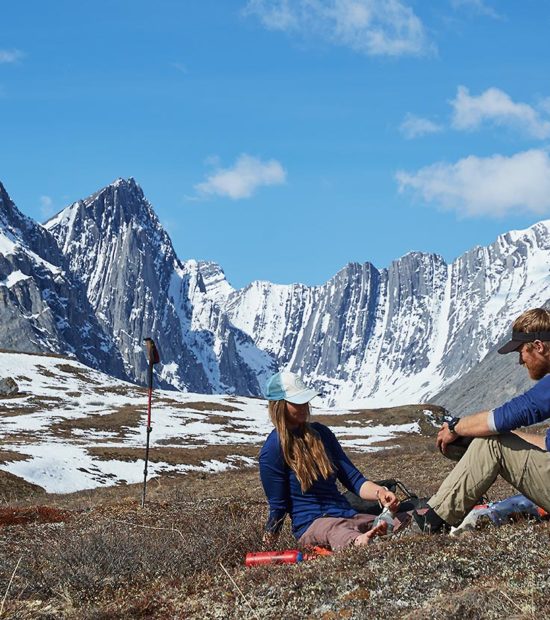
The Brooks Range. Backpacking in the Arctic just got even better.
On a scale of 1 – 5, five being the most challenging, five hiking boots is right up there.
1 boot = basecamp/dayhike easy 2 boots = easier backpacking trip 3 boots = intermediate level trip 4 boots = intermediate to advanced backpacking 5 boots = ask yourself are you really ready for this?
Expect whatever level you think might best fit you to be one level LOWER on our scale. Hiking here in Alaska is generally a step or three above what you’ll find in the Lower 48 states.
Expect it to be tougher than you think it will. At least in part, anyway. Some sections will inevitably be easier. Some will make you feel it.
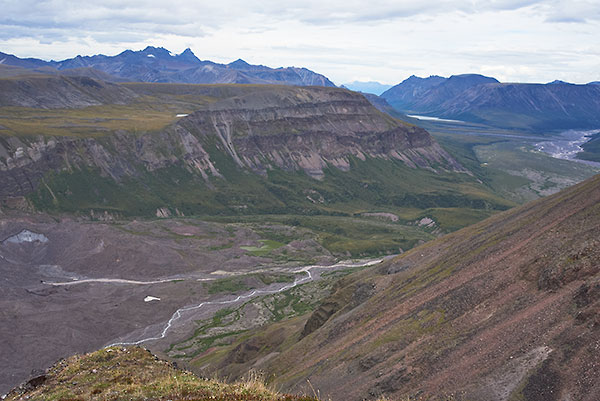
One of the best hikers I’ve walked with, Ben, said it perfectly one day, as we traversed a step sidehill on the Southern Traverse. “Man, Alaska just beats you up, doesn’t it?”
And he’s right. It does. Don’t be fooled by the low mileages and the lower elevations. The catch is the difficulty of traversing rugged country with no trails. However much you think that might impact you, double it.
You need to be athletic, well balanced, in good shape, and an experienced backpacker for this kind of trip. If you’re not that .. well, don’t say you weren’t well warned.
An epic backpack for the ages. Crisscross the divide and explore the Arctic.
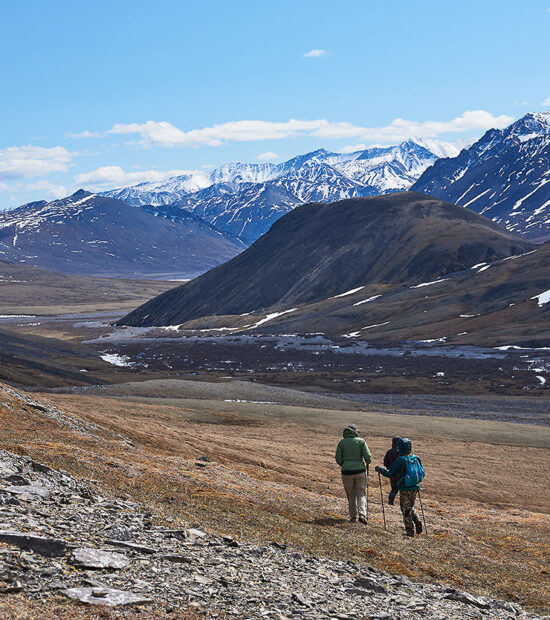
Backpacking the Arctic Refuge
A Trail of Glory. Backpacking the Arctic National Wildlife Refuge
Intermediate
On a scale of 1 – 5, five being the most challenging, three hiking boots is smack in the middle.
If you consider yourself up for an intermediate level hike, for example, assume that a trip rated intermediate here will probably be a bit tougher than you’re expecting; not impossible, but harder than you think. Intermediate level trips don’t mean you won’t be challenged, won’t struggle at times, and won’t have any easy sections either. On any trip you’ll probably find some easy sections, some harder, and some are challenging.
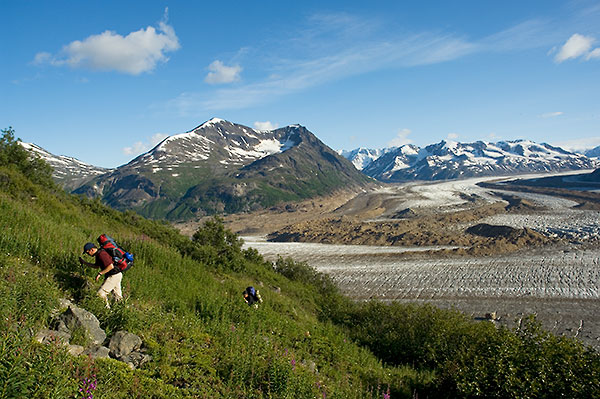
Also, understand that all these rating are so completely subjective that they’re not entirely all together practical. They’re a VERY loose idea of how the trips might compare to one another, for some people.
Lastly, understand that even a trip we might rate as “intermediate” (3-4 hiking boots) may still have some difficulty at times. Weather changes things. There may be a tough steep climb on the route that takes a few hours.
Above the Circle. Backpacking the Arctic National Wildlife Refuge
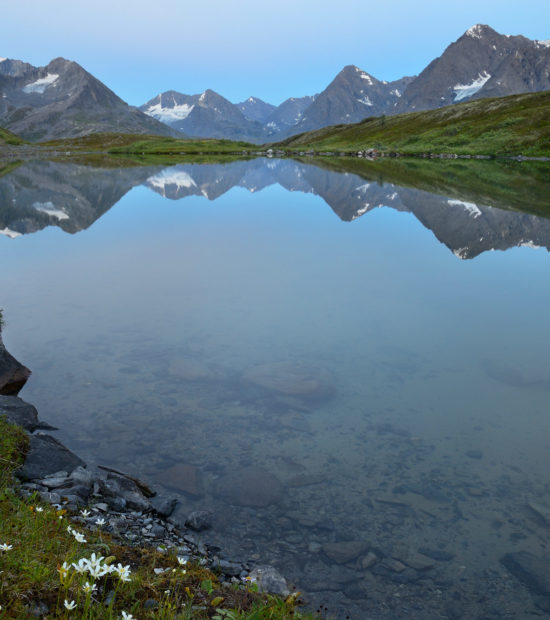
65 miles. No Trail. No people. Just Wild.
A challenging backpacking trek through the eastern reaches of the Chugach Mountains. Not for the faint of heart. But we'll get you there.
BACKPACKING
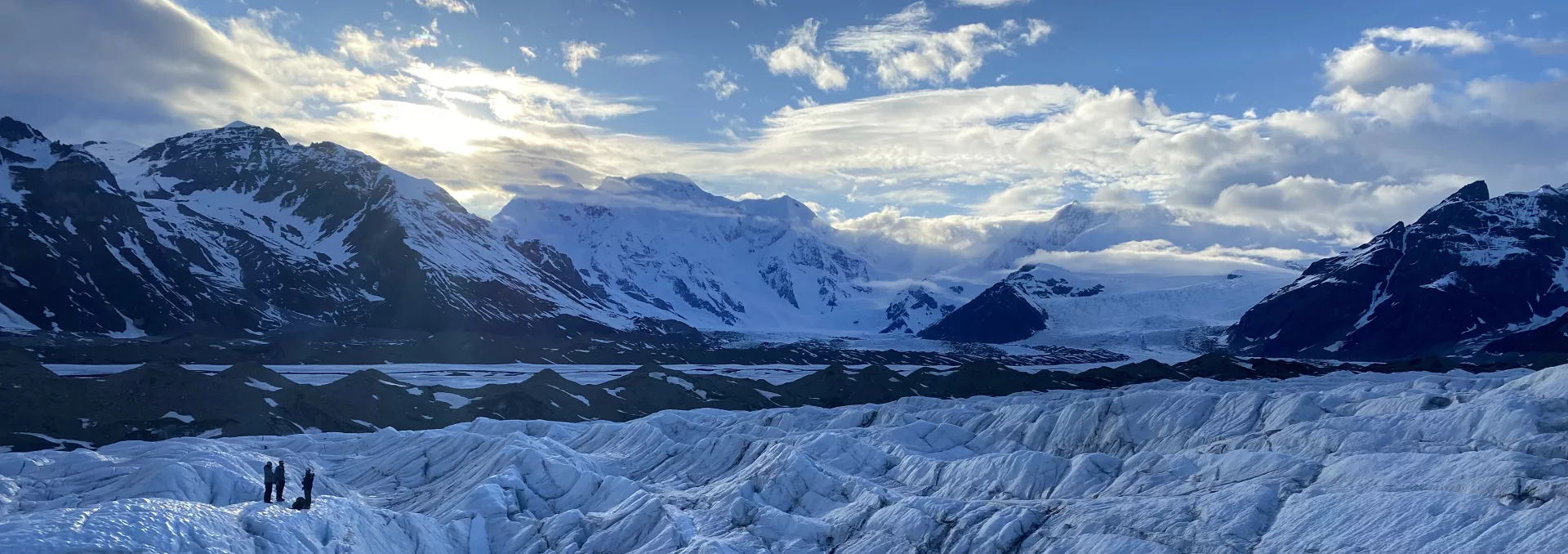
Explore the pristine Alaskan backcountry
For over 40 years St. Elias Alpine Guides has been leading backpacking trips in Alaska’s Wrangell-St. Elias National Park, with over 13 million acres of adventure! A completely trail-less and undeveloped wilderness, backpacking in the Wrangells allows you to engage with a raw and virgin landscape, negotiating unique and challenging terrain. Always an adventure, point-to-point backpacking allows you to cover the most ground and see the changing landscapes of this enormous National Park!
RECOMMENDED FOR:
- Beginner to expert backpackers
- Families with older children
- Groups with similar abilities and interests
- Adventurers looking for an epic wilderness experience and willing to push themselves
What’s Included
- Customized trip planning
- Orientation and a Gear Shakedown
- Your professional guides
- Scenic bush flights in and out of the backcountry
- All the food while you’re in the backcountry
- Group gear and technical equipment
You’ll be responsible for your own personal camping and hiking gear, logistics surrounding the trip, and food in the front country, before and after the trip.
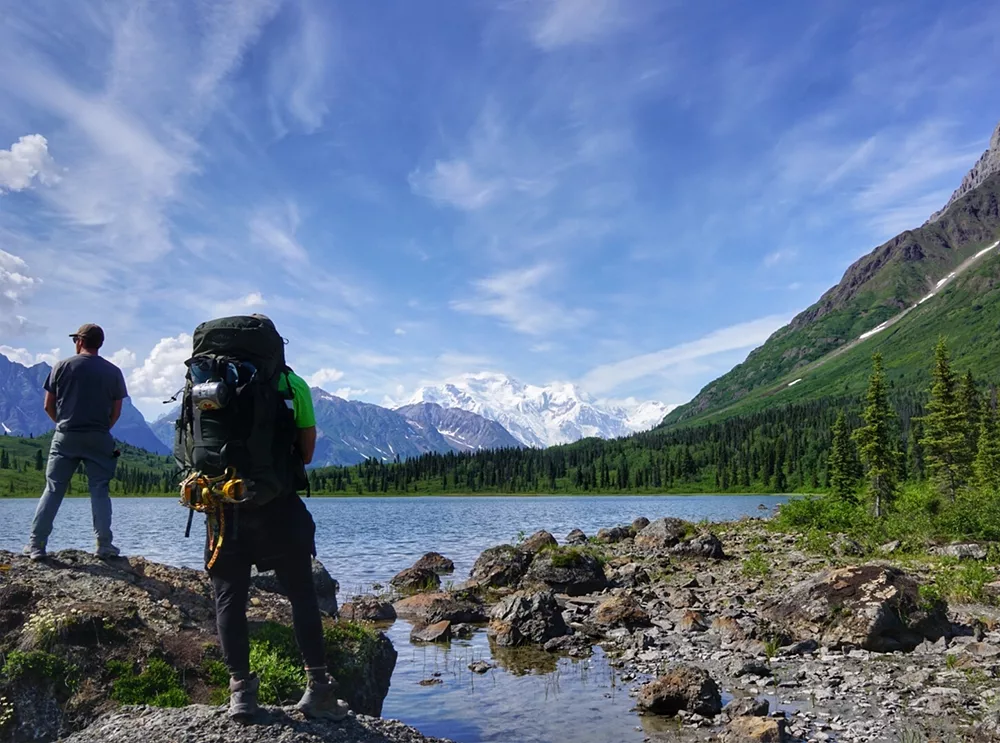
Private Trips
Private Trips are just for you and your crew; every detail is customized to your interests and goals. Book a Private trip online or contact our Expedition Coordinator to start planning your adventure!
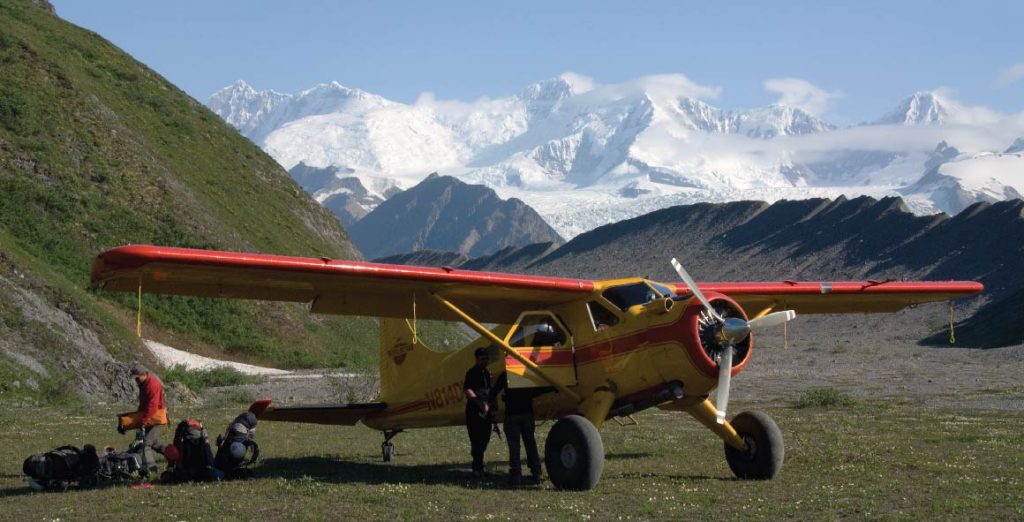
Adventures with Ease
We can arrange transportation to and from the Wrangells, local lodging, and other local activities before and after the backcountry trip. Upgrade your backcountry adventure to a Trip Package!
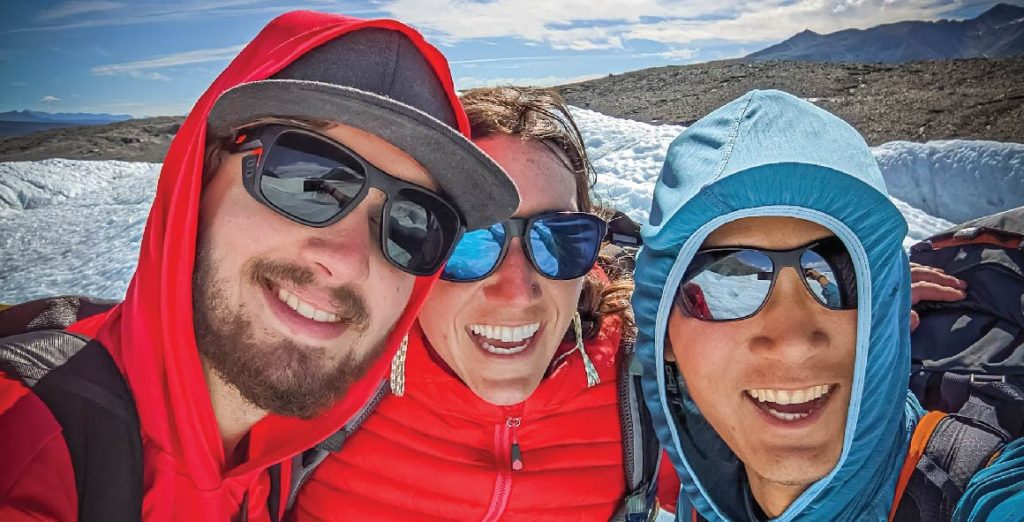
Most Backpacking Trips are also available in a Group format! Need a partner or two to meet the Group Trip minimum? Find partners and new backcountry buddies on our dedicated SEAG Group Trip Facebook page!
Explore Trips By Type
- Moderate Backpacking Trips
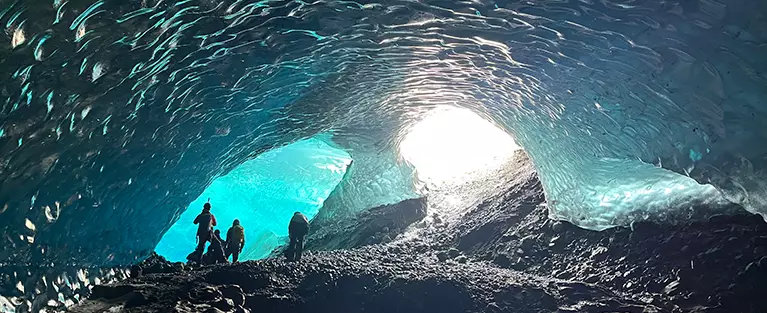
Root Glacier Overnight Discover the magic of the glacier on the best overnight trip in Alaska!
Price: $580
Length: 2 Days
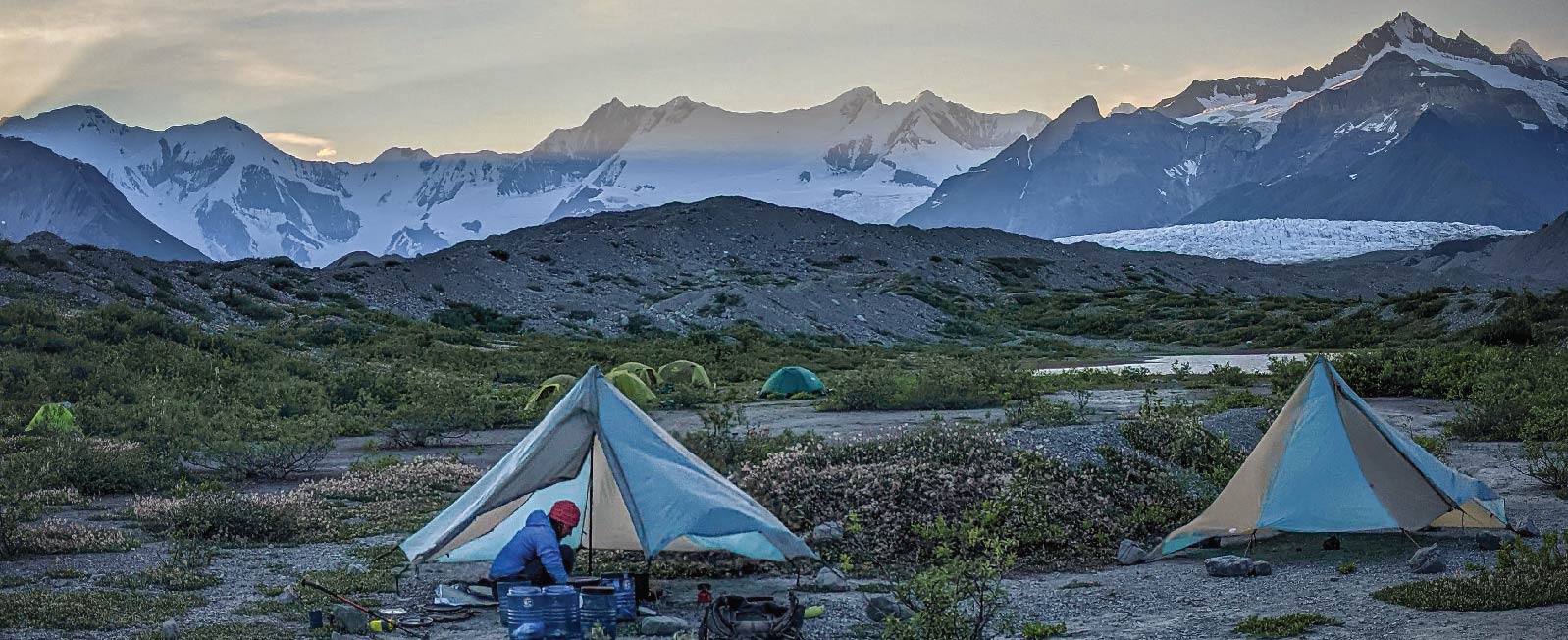
Donoho Peak Wilderness
Customize an epic route for any level in the Kennicott Valley
Price: $995
Length: 4 Days
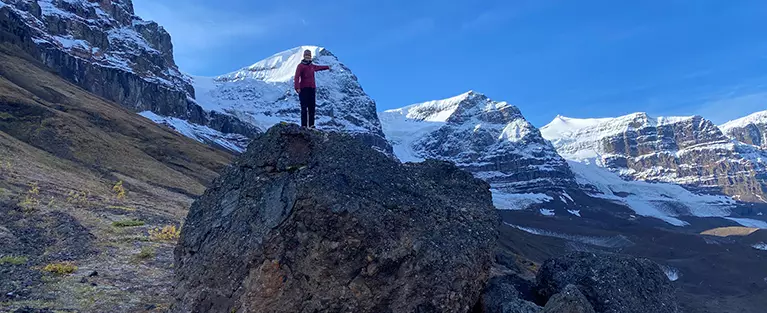
Skolai mini-Backpack Explore the tundra wonderland of the Wrangells backcountry
Price: $2,600
Length: 4 Days
Group Trip: July 15-18, 2024
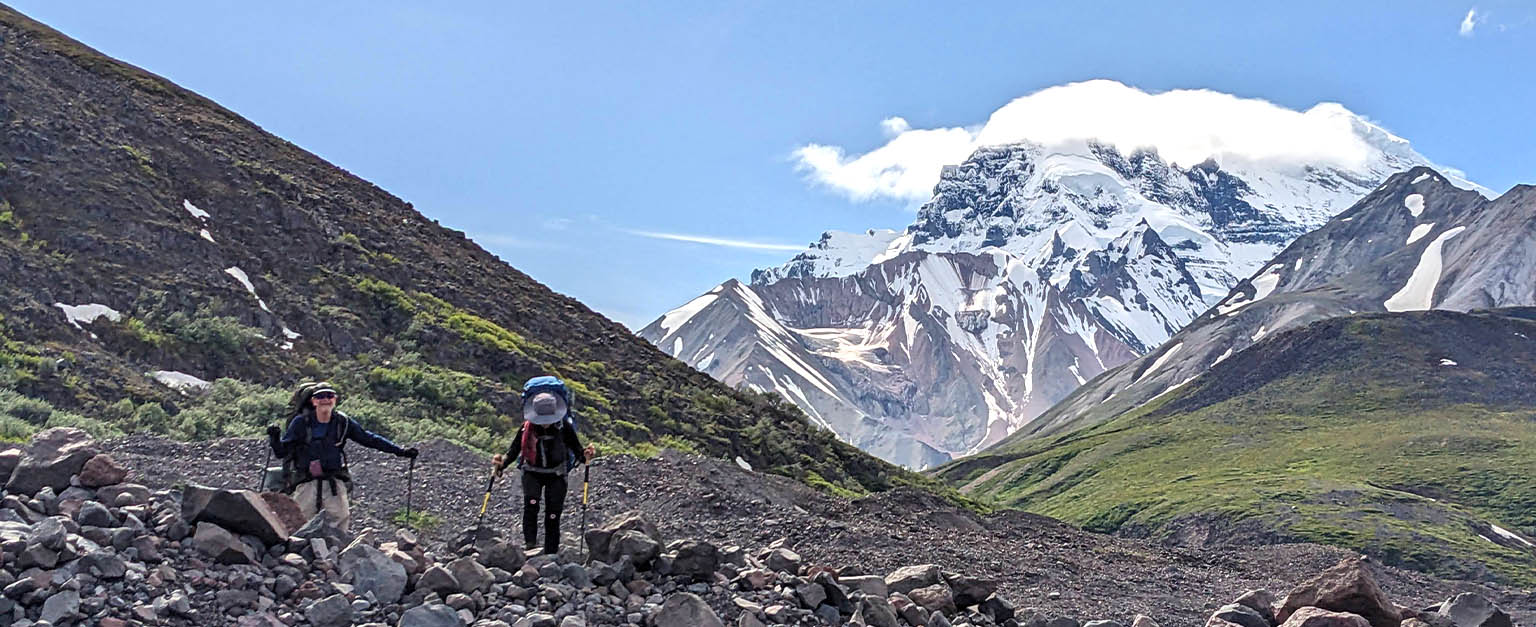
Sanford Plateau mini-Backpack
Trek under the massive faces of the giants of the Wrangells
Price: starting at $2,790
Length: 4.5 Days
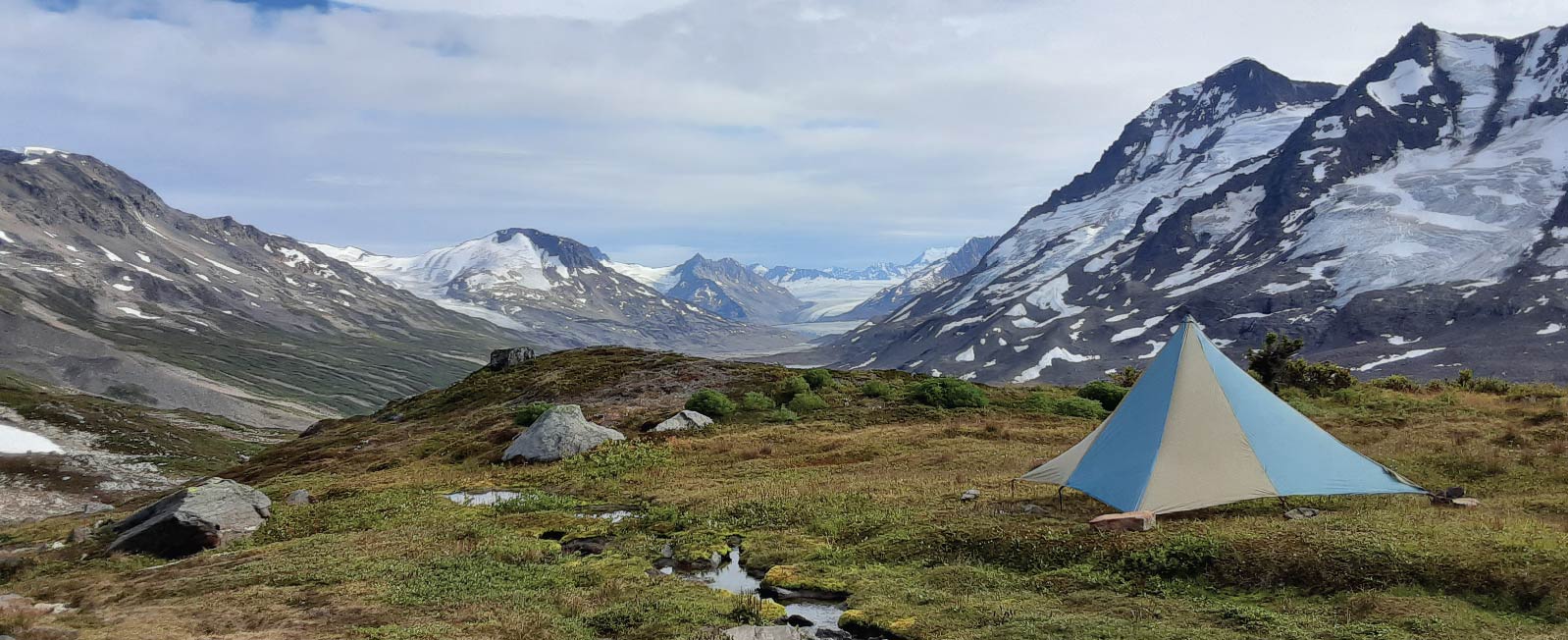
Iceberg Lake mini-Backpack Traverse the rock, ice, and tundra of the Chugach Mountains
Price: $3,040
Length: 5 Days
- Advanced Backpacking Trips
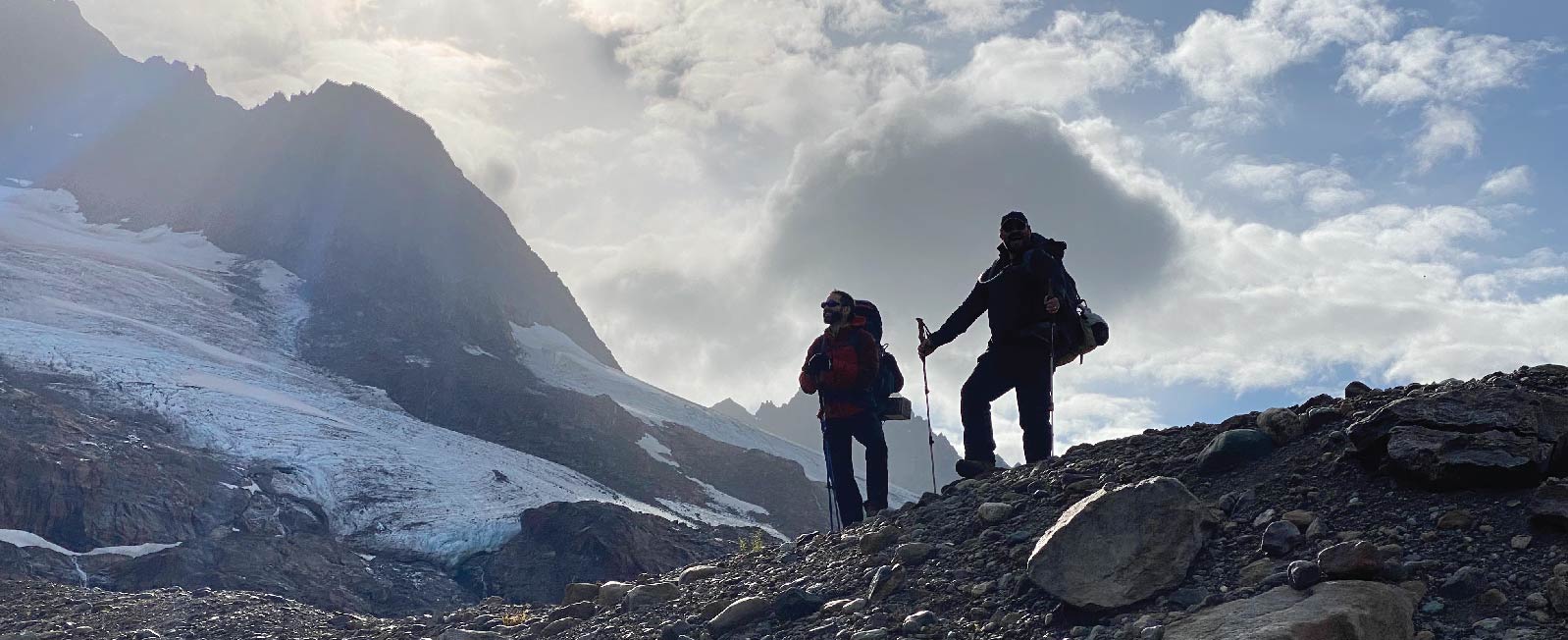
Chugach Mountain Circuit A song of ice and tundra in Alaska’s longest mountain range!
Length: 5 days
Group Trip: July 30-Aug 3, 2024
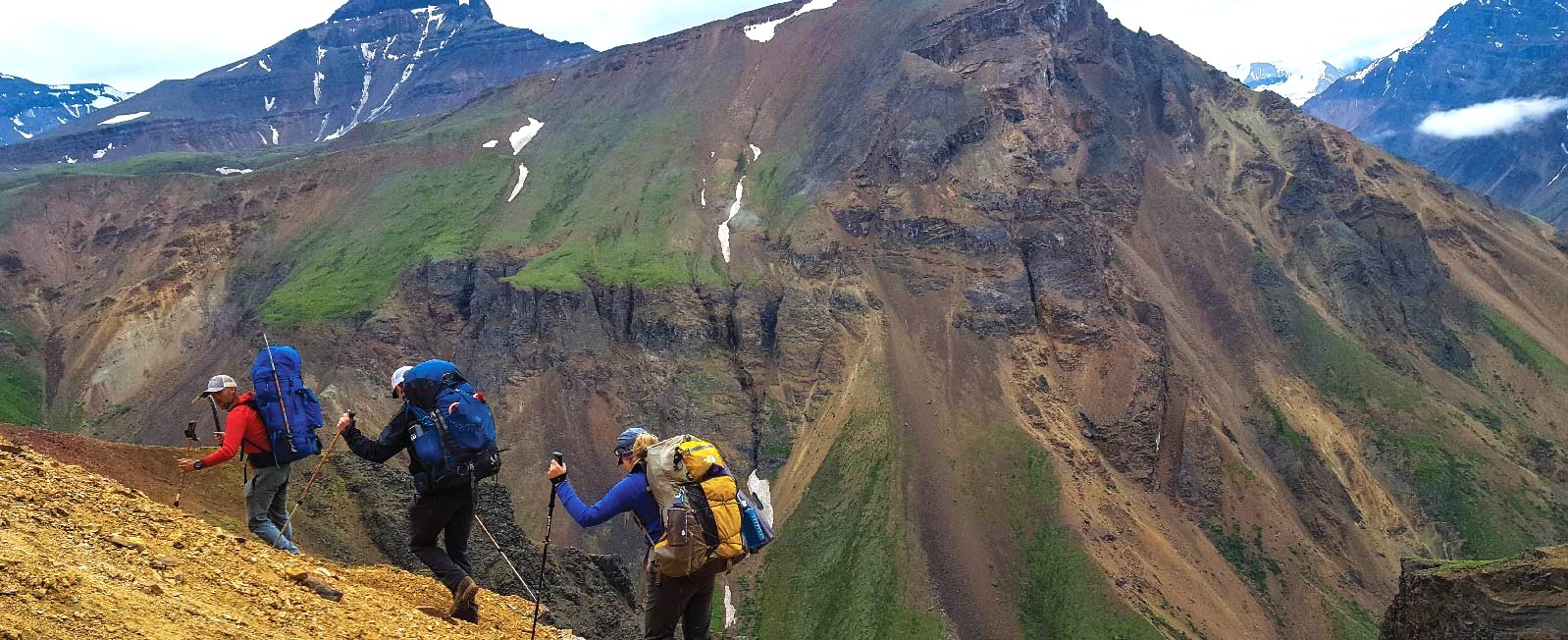
Upper Chitistone Goat Trail
The most iconic backpacking route in Wrangell – St. Elias!
Price: $2,840
Length: 5 days
Group Trip: Aug 13-17 , 2024
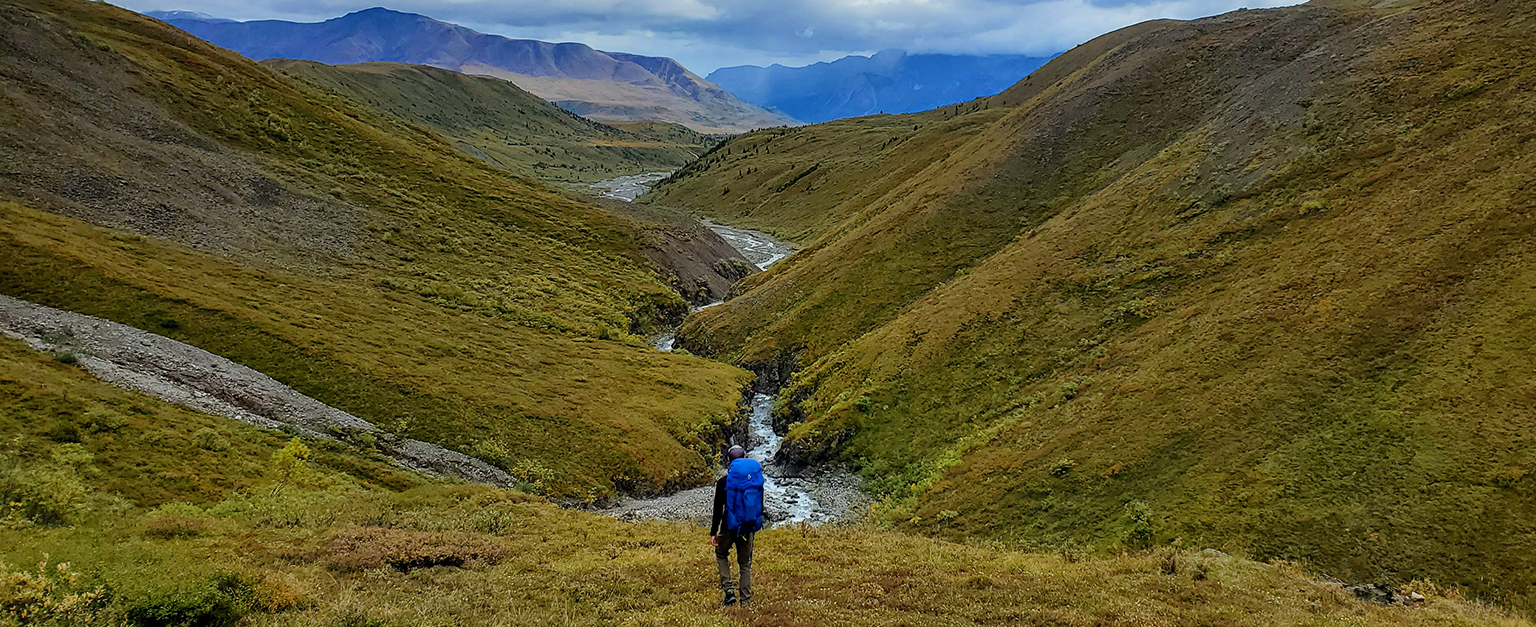
Western Mentastas Highline
An alpine adventure on the North side of the Park, right off the Nabesna Road!
Price: $1,370
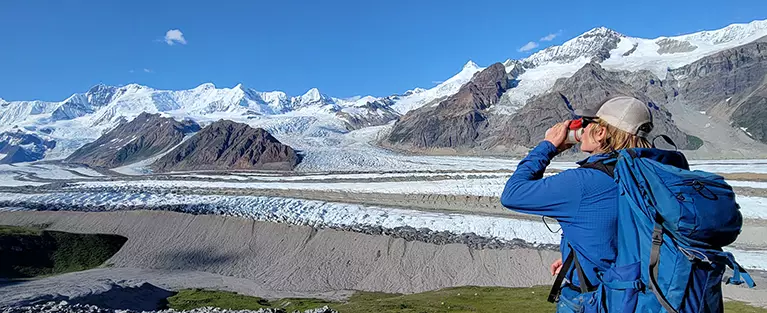
Glacier & Tundra A challenging and uniquely Alaskan trek in the Kennicott Valley
Price: $1,625
Group Trip: July 12-16, 2024
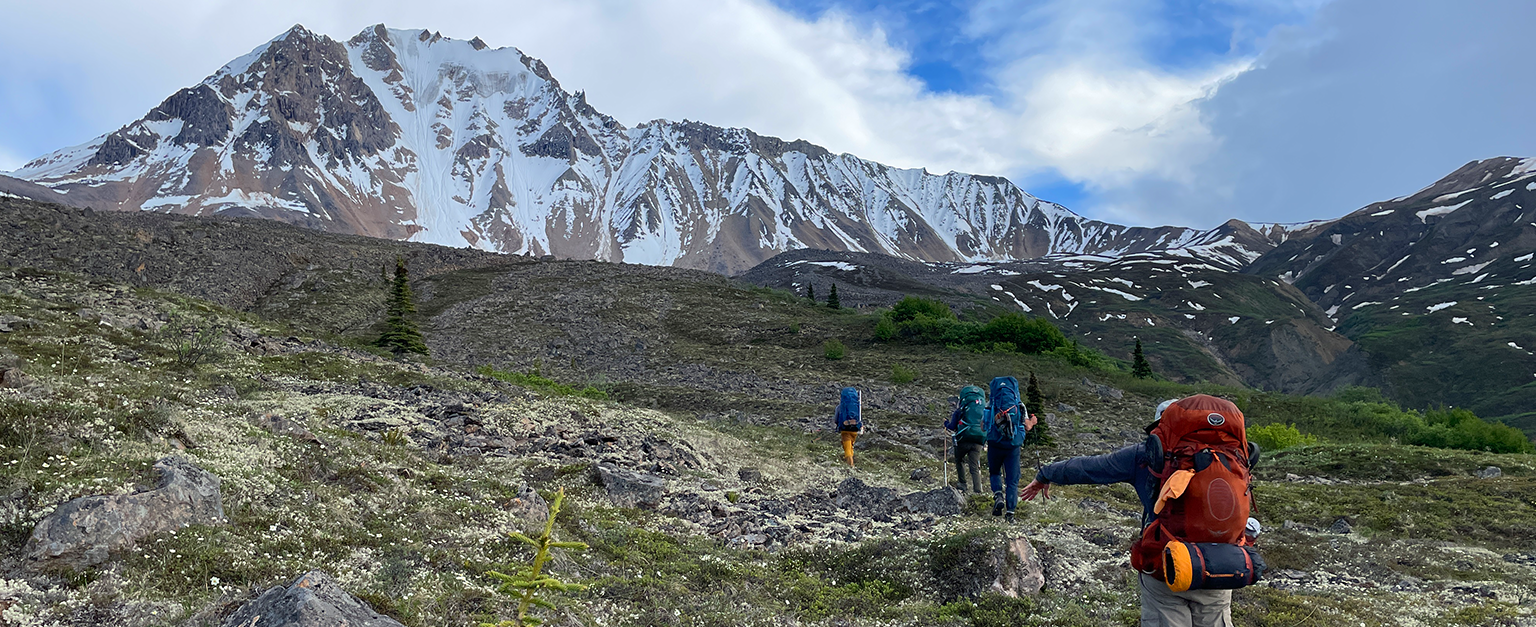
Wolverine Cirque A high alpine loop route over the Chitistone and Nizina Valleys
Price: $3,030
Length: 6 days
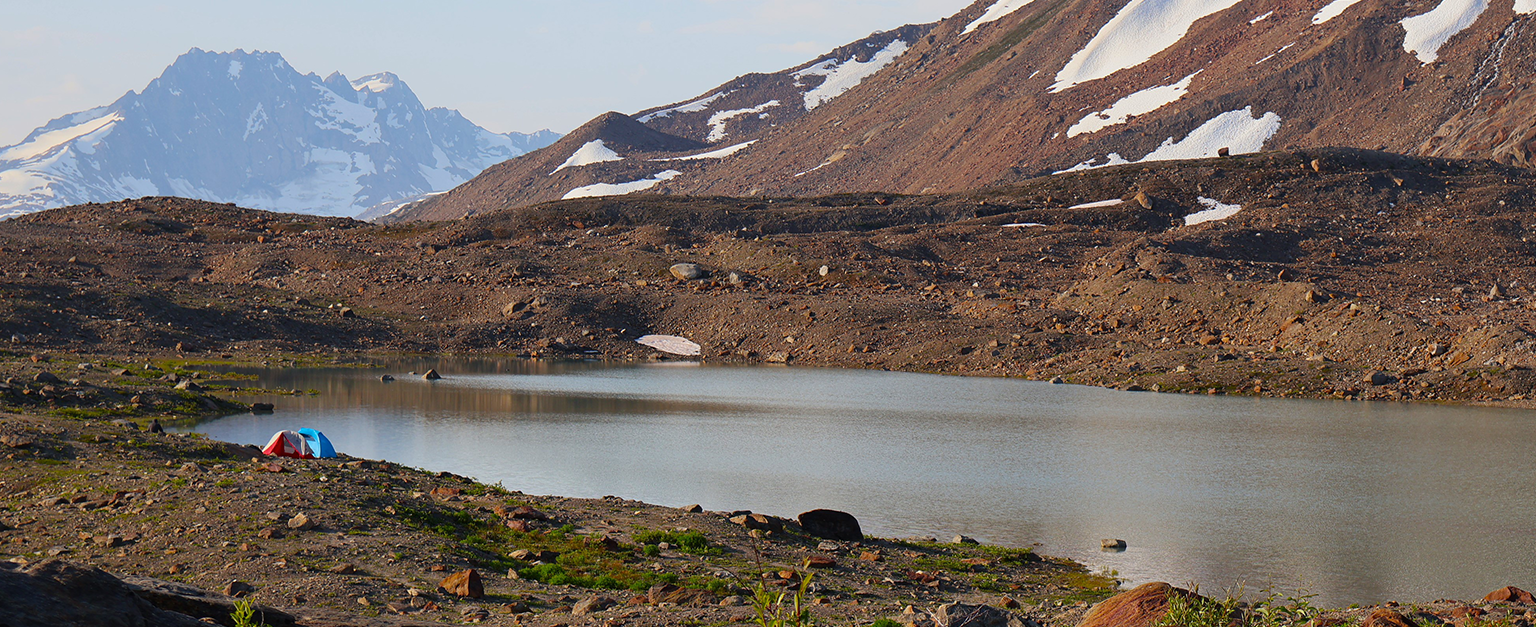
Berg to Beaches A unique route over the tundra and ice of the Chugach Mountains
Price: $3,420
Length: 7 days
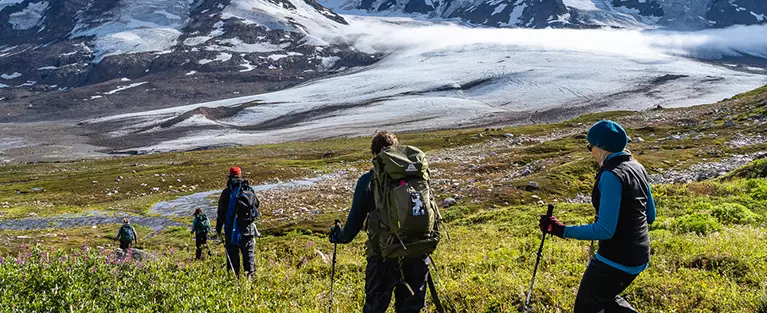
Seven Passes A classic Wrangells trek in the Chugach Mountains
Price: $3,550
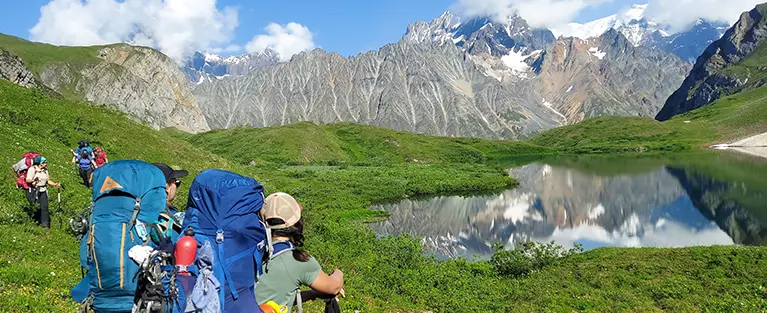
Journey to Oz A magical trek through the wilderness
Price: $2,450
Length: 8 days
Group Trip: July 18-25, 2024
All the pictures and descriptions sound amazing! How do I know what’s right for me? Here are some things to think about when selecting a trip: What is my #1 goal for this adventure? Do I want to relax and get away from a hectic schedule? Do I want to push myself on an epic and athletically challenging journey? Create life-long memories with my family or partner? Learn skills from the experts and grow my scope as a mountain athlete? See new landscapes and experience Alaska’s unique glaciated terrain? What are my interests? Birding, animals, photography, geology, wildflowers, journaling, athleticism, spirituality, art, technical climbing, etc. Will this trip be part of a bigger Alaska trip? Where else am I going and what else will I see? Our glaciated terrain, history, high-altitude peaks, and vast backcountry wilderness are what set us apart from other areas in Alaska. What am I comfortable with at my current level of knowledge, experience, and physical and mental ability? Alaska is bigger and tougher than anything in the lower 48 and it’s a great place to push yourself, but you want to be realistic and make sure you have a good foundation to build upon if reaching for higher heights.
Backpacking + Basecamp Hiking Trips + Courses: Moderate Please keep in mind that there is no truly “easy” hiking terrain in the Wrangells and often the coolest places require a little extra effort to get to. On our Moderate Trips, you will be off-trail trail for the majority of the trip, traversing some combination of rocky slopes, squishy and spongey tundra, and/or slick glacial ice in crampons - all of it uneven, most of it hilly and some of it brushy. On these trips, you will cover 5-8mi/day with up to 1500’ of elevation gain/loss while carrying your own gear along with a portion of the group gear. You will be camping in the rugged wilderness with no manmade shelters, toilets, or really any type of development. We recommend physical training in preparation for Moderate trips. These trips are great options for experienced car campers and beginner backpackers, although we always recommend as much prior experience as possible. Advanced On our Advanced Trips, we will be completely off-trail trail for the entirety of the trip, traversing some combination of steep and rocky slopes, tussocky and squishy tundra, loose and dynamic moraine, thick brush and/or slick glacial ice in crampons - all of it uneven and hilly. On these trips, you will cover 6-10mi/day with up to 2500’ of elevation gain/loss while carrying your own gear along with a portion of the group gear (total pack weights usually come in at 40-50lbs). We highly recommend starting physical training in preparation for Moderate trips 2-3 months in advance. These trips are great for very fit hikers or backpackers with at least four +3-day trips under their belts, but honestly, the more experience you have, the better prepared you will be for the “Alaska factor”! Expert We often hear that our trips are the hardest trips our clients have ever done, and we hear this even from very experienced backpackers. Why? Because Alaska’s undeveloped wilderness is rough and rugged and provides endless natural challenges which make for slow going but also an extremely engaging and fulfilling experience! Our expert trips require a high level of fitness and conditioning and training prior to these trips is mandatory. On these trips, you can expect to cover up to 10 miles a day of steep, rugged, unstable, and inconsistent terrain with a 45-55lb pack of all your personal gear plus some group gear. You can expect to gain/lose between 1,000-3,000’ a day. You will be camping in the rugged wilderness with no manmade shelters, toilets, or really any type of development. These trips are perfect for very fit and experienced backpackers and we recommend starting training 2-3 months prior to the start of the trip. Rafting Trips: Our Rafting Trips are scenic floats through incredible wilderness and on all of our trips you’ll hit Class II-III rapids. The glacial rivers we float run fast and cold so we take a conservative approach, allowing everyone to have a fun and splashy time while mitigating the risks the water presents to the boats and rafters. On Rafting Trips you can expect to go on a short hike or two each day, usually 1-3 mi total and up to ~200ft of elevation gain. Please keep in mind that there is no truly “easy” hiking terrain in the Wrangells and often the coolest places require a little extra effort to get to. There aren’t any trails where you’re headed, so most hikes will be up dry creek beds or along the brushy edges of the river. Longer and more challenging side hikes may be accessible, depending on the trip. You will be camping in the rugged wilderness with no manmade shelters, toilets, or really any type of development. No special physical training or camping experience is required . We recommend our rafting trips to anyone looking for a wilderness experience at a very comfortable pace, those wanting to spend quality time with their group, or those hoping to relax while still seeing a lot. Kids ages 8+ are welcome.
Most of our Multi-day Trips are offered in both a Group or Private Trip format.
Group Trips have set dates and are made up of individual travelers or smaller parties like couples who don’t know each other but are excited to adventure together! On a Group Trip, you’ll meet new people with similar interests and be able to spread the costs of the trip resulting in a lower per-person rate. We need a minimum of 3 people to run a Group Trip at the Group Rate and they max out at 8 participants for land-based trips and 12 participants for rafting trips. Learn more about Trip Minimums here .
Private Trips have custom dates and are just for your party. Private Trips are great for families, especially those with young children, close groups of friends or couples just wanting to spend time together, or those with special interests like photography or birding that they want to focus on during the trip. On a Private Trip, the entire experience is customized to your party and you don’t have to compromise to anyone else’s interests or abilities. Private Trips can be for just one, solo adventurer or get as big as 12 participants for larger groups.
For both Group and Private Trips, we work with a ratio of 1:4 for land-based trips, 1:3 for rafting trips, and 1:2-3 for mountaineering and ski trips. This helps with any pacing or interest discrepancies and provides additional support for bigger groups.
If you want to see the Alaskan backcountry but have no interest in carrying a heavy backpack the whole time, check out our Basecamp Trips!
LOOKING FOR SOMETHING LESS STRENUOUS?
7 Best National Parks To See Wolves

Your changes have been saved
Email is sent
Email has already been sent
Please verify your email address.
You’ve reached your account maximum for followed topics.
- One particular national park in Wyoming is the best to observe wolves, with 10 packs totaling at least 124 wolves.
- A national park in Minnesota offers frequent wolf sightings along the lakeshores and in the winter.
- One of the most underrated national parks in the Midwest has a growing wolf population, making sightings more common than before.
Wolves, like bears and wild cats, are among the most fascinating animals in the world, and it's an incredible experience to watch them roaming in their natural habitats. Although wild gray wolves used to wander much of the United States in the past, they are now only found in a few states.
Similar to how some of the most beautiful national parks in the US serve as a refuge for bison, bears, and other endangered wildlife, many of them now host gray wolves as well.
From Yellowstone to Katmai, these are some of the best US national parks for incredible wildlife-watching opportunities and are among the top places to see wolves in America. There is no guarantee that visitors will get to see wolves on their trip, but with a competent guide or ranger-led program, the likelihood of seeing gray wolves in their habitat is comparatively high.
Remember to follow NPS tips to safely watch wildlife !
Beyond Bear Spray: 10 Essential Gear Items If You're Hiking In Bear Territory
If you're camping or hiking in bear country, everyone will tell you you need bear spray, but here's what else to take with you.
7 Yellowstone National Park, Wyoming, Montana, & Idaho
Excellent opportunities to see wolves roaming in the wild.
Yellowstone was the first national park to reintroduce wolves in the mid-1990s. According to the National Park Service, as of January 2024, at least 124 wolves in 10 packs reside in the park .
Today, Yellowstone is perhaps the best US national park to see wolves in the wild. Although wolves can be spotted throughout Yellowstone National Park , the northern range is considered the best location to see them.
Lamar Valley, which is called “America’s Serengeti,” because it is home to a wide array of wildlife, is also among the best places to see wolves in Yellowstone.
Winter is an ideal season to observe wolves with fewer crowds. However, visitors need to be able to withstand the cold, but the dark wolves are especially noticeable against the snow.
6 Voyageurs National Park, Minnesota
A healthy wolf population means frequent sightings.
Voyageurs National Park , one of the most trending national parks in 2024 , is Minnesota's hidden gem. Voyageurs is unique in that it's best explored by boat . Not only that, but it's also one of the top places for viewing wolves in the United States.
Wolves are the park's primary predators, feeding primarily on beavers, moose, and deer. The park's webcam has also captured them eating blueberries and fishing in the area.
While Voyageurs has a healthy wolf population (between 30 and 50), the best chances of seeing them are in the winter along the shorelines of the big lakes and the park entrance roads.
The remote Kabetogama Peninsula area is also a fantastic place to see these amazing creatures.
Forget Big Bears: How To Scare Off Big Cats While Hiking
Bears aren't the only predators out in the backcountry. Here's how to stay safe around mountain lions and other American big cats.
5 Isle Royale National Park, Michigan
Remote island with frequent sightings.
Located on a remote island in Lake Superior, Isle Royale National Park is widely recognized for its unique wolf-moose predator-prey ecosystem. In fact, researchers have been studying Isle Royale's unique predator-prey relationship for more than 50 years.
The population of wolves declined to just two in 2018. But after their relocation in 2018, the wolf population has grown, turning wolf sightings from rare to frequent incidents.
So, those lucky ones who get the chance to see a wolf in Isle Royale National Park, the ultimate hidden gem in the Midwest , are rewarded with a memorable experience.
4 Denali National Park, Alaska
Pristine alaskan wilderness and frequent wolf sightings.
Denali National Park and Preserve is regarded as one of the best spots in the world to witness wolves in their natural habitat.
Every year, thousands of visitors see wolves in Denali, which is home to America's deadliest yet incredibly beautiful mountain , particularly while traveling along the Denali Park Road. This is the only road in the park, and only the first 15 miles are open to private vehicles during the summer.
The remaining distance is only accessible via park shuttles or tour buses. Since three packs of wolves dwell close to the park road , this is the area where wolves are most frequently sighted in the park.
7 National Parks Where You'll Find Mountain Lions
There are plenty of big animals in US national parks to be aware of. Mountain lions live in 16 states, and are common in many of America's parks.
3 Glacier National Park, Montana
Several packs of wolves live within the park's limits.
Glacier National Park is a haven for nature lovers, offering plenty to see to keep them busy for days on end. Indeed, watching wildlife is one of the Glacier National Park's top activities .
It is estimated that six to eight packs of wolves reside within the limits of the park . The park was devoid of wolves for nearly 50 years until the 1980s when their reintroduction contributed to their thriving population.
The North Fork area is noted for having the largest wolf population. Moreover, sightings of wolves have also been reported along the Oxbow Trail, the Camas Road, and the Lower McDonald Creek region.
7 National Parks Better Than Glacier National Park
As wonderful as Glacier National Park is, these parks offer the same epic views and activities without Glacier's crowds or timed entry requirements.
2 Grand Teton National Park, Wyoming
Proximity to yellowstone and a thriving population of wolves.
After the reintroduction of gray wolves into Yellowstone National Park, they spread to Grand Teton National Park and the neighboring areas.
Now, a minimum of 43 wolves (as of 2021) live in Grand Teton, which is often considered an underrated alternative to Yellowstone , as well as in neighboring areas, making it a great spot to watch wolves in the United States.
The Willow Flats region is said to be the best place to spot wolves in Grand Teton National Park because it has an abundance of moose and elk, which attract wolves, especially around dawn and twilight when they are out hunting.
Also, the Lower Gros Ventre and Wildcat Ridge areas have wolf packs where they den and raise pups, but these areas are closed for visitors to help the animals raise their young peacefully.
6 National Parks Where You Need To Carry Bear Spray
These US national parks aren’t just pretty postcards; bears roam freely. Carry bear spray to enjoy incredible adventures with peace of mind.
1 Katmai National Park, Alaska
Untouched alaska wilderness and a healthy population of wolves.
Katmai National Park and Preserve , a true wilderness gem in Alaska, is one of the world's top destinations to see bears safely (particularly brown bears).
Named after Mount Katmai, its centerpiece stratovolcano, the park is famed for the Valley of Ten Thousand Smokes and its over 1,000 population of brown bears, which are often seen fishing for salmon at the famous Brooks Falls . However, opportunities to see wolves should not be overlooked.
Wolves have been spotted roaming and hunting throughout Katmai National Park.
According to the NPS , they were often seen hunting sea otters and harbor seals along the coast, as well as fishing alongside bears in Brooks Camp, which are considered unique behaviors of Katmai coastal wolves captured by the park's camera.

IMAGES
VIDEO
COMMENTS
9 Best Alaska Backpacking Trips To Thru Hike. Table Of Contents. 1. Resurrection Pass Trail. Distance: 39 miles one-way. Time: 3 to 5 days. Elevation Gain: 2,200 feet. Difficulty: Moderate. Resurrection Pass Trail is one of the best thru-hikes in Southcentral Alaska.
Which backpacking trail has the most elevation gain in Alaska? Alaska: With an ascent of 15,534 ft, Mount Denali: West Buttress has the most elevation gain of all of the backpacking trails in the area. The next highest ascent for backpacking trails is Mount Denali: North Summit with 13,090 ft of elevation gain.
Deer Mountain, Ketchikan. 6. Eielson Alpine Trail, Denali National Park. 7. Flattop Mountain, Anchorage. 8. My Advice for Planning Your Alaska Hiking or Backpacking Trip. Alaska is massive. At more than 660,000 square miles, it's nearly one-third the size of the contiguous 48 states.
"The" mountain. To those who have hiked or dream of hiking in Alaska's 6-million-acre Denali National Park, 20,320-foot Mt. McKinley is "the" mountain. Though the park boasts many wonders-wolves, grizzlies, 430 species of flowering plants, glaciers, tundra-the mountain will most capture your imagination.
Backpack Kesugi Ridge. 4.7. 27.4 mi / 4650 ft gain. Kesugi Ridge is a 27.4 mile point-to-point trail from Little Coal Creek to Byer's Lake in Alaska's Denali State Park. To get to the trailhead from Anchorage, take the Park's Highway north to the parking area at Little Coal Creek Trailhead at milepost 163.9.
Explore miles of the best hiking and backpacking trails in Alaska. Find your next trip, from Denali National Park to the Talkeetna Mountain Range! Outdoor enthusiasts welcome! top of page. ... Find your next trip with our guide for the best backpacking locations in Alaska, organized by weekend getaways, week-long adventures and gritty expeditions.
2. Trail of Blue Ice, Portage. Best accessible trail. 5 miles one way (8km), easy. Located between Anchorage and the seaside village of Whittier, the Trail of Blue Ice is the result of an amazing effort by the US Forest Service to introduce visitors to the many glaciers of Southcentral Alaska's Portage Valley.
Since our humble beginnings in the late 90's, Alaska Alpine Adventures has been guiding Alaska Backpacking trips across the last frontier. Backpacking continues to be one of our most popular activities, and is one of the best, and certainly most authentic, ways to see the unexplored Alaska. Set yourself on a ridge top and survey the remote ...
Chugach State Park. Denali National Park. Arrigetch Peaks. Revelation Mountains. Wrangell-St. Elias National Park. Kobuk Valley National Park. Alaska is a backpacker's paradise, where your trail cred will reach new levels. Whether you're cutting your teeth on classic tried-and-true routes, or flexing more advanced backpacking skills, Alaska ...
Sitka Trail Works. Located just a short walk from the charming town of Sitka, the Indian River Trail is an enchanting walk that rewards hikers with a 70-foot waterfall at one end. The trail is 4.4 miles in length, but is a reasonably easy walk, requiring about two hours to complete one-way.
September is a beautiful time to be below 4000ft but be prepared for possible winter conditions. The main difference between Alaska backpacking and everywhere else is the lack of trails and the magnitude of the terrain. A backpacking trip up here is a completely different animal than 5 days on the PCT.
Distance: 33 miles one way. One of the most famous thru-hikes in Alaska, the Chikloot Pass Trail allows you to walk in the historical footsteps of the tens of thousands of Stampeders that hiked from Skagway to the Yukon during the Klondike Gold Rush. The entire trail takes 3 - 5 days to complete and permits are required to hike the trail ...
Backpacking - The Perfect Way to Visit The Wild. Expeditions Alaska offer guided Alaska backpacking trips for individuals and small groups (* group sizes are limited to a maximum of 5 participants) in various wilderness regions in Alaska.Wrangell-St. Elias National Park is home to the majority of our backpacking trips.We also guide backpacking trips in the Brooks Mountains of Gates of the ...
Ready to check out the best trails in Alaska for hiking, mountain biking, climbing or other outdoor activities? AllTrails has 993 hiking trails, mountain biking routes, backpacking trips and more. Discover hand-curated trail maps, along with reviews and photos from nature lovers like you. No matter what you're looking for, you can find a diverse range of the best hiking trails in Alaska to ...
Since 2003, Guided Hiking &Backpacking Adventures in Alaska's Best Wilderness Areas. McCarthy Alaska. 907-795-5252. See: - - -. Easier Backpacking, Base Camp and Family Trips (4-5 days) Good for all ages and abilities, families with small children, first time campers, or those wanting an easygoing trip.
Backpacking in Alaska is a unique and incredibly rewarding experience. NPS / A. Lindholm. Hazards Wildlife: Most of Alaska is bear country.Stay safe around brown bears. Avoid areas frequented by bears and avoid bear travel corridors along lakeshores and salmon streams or near game trails.
Water filter or purifying tablets (also good for longer day hikes) Toilet paper, trowel and a bag for used toilet paper. Tent with rain fly and waterproof floor. Sleeping bag and pad (protection to 20° F/-7° C is suggested even in summer) Sleeping pillow (or you can use your jacket.
Experience Denali National Park like few others do. Go backpacking beside North America's tallest mountain. Guided by Alaska's backpacking professionals. Step into pure wilderness. Adventure across the Alpine, no trail required (or available) Stunning 360 degree Mountain Views. Customize your trip with basecamp and through-hiking options.
The most iconic backpacking route in Wrangell - St. Elias! Price: $2,840. Length: 5 days. Group Trip: Aug 13-17, 2024. READ MORE. Western Mentastas Highline. An alpine adventure on the North side of the Park, right off the Nabesna Road! Price: $1,370. Length: 5 days.
Many backpacking trips in Alaska require off-trail travel for a portion or the entirety of a route. Sometimes, off-trail travel means following a well-worn caribou path that resembles a single-track mountain bike trail; other times, it means hiking on lumpy bumps in the tundra (called tussocks) that are best approximated by walking over a pile ...
So, if you plan on doing some serious hiking and backpacking in this country with a myriad of adventures, history, and unforgettable scenery, you might want to check out the popular trails of Alaska. What's in this post: hide. 1 Best Backpacking Trails in Alaska. 1.1 #1 Flattop Mountain. 1.2 #2 Alaska Range.
Guiding backpacking adventures in the Alaska wilderness Since 2003. We keep our groups small (4-5) for a more intimate wilderness experience. Want to be sure a trek is right for you? Talk with the owner: In over 19 years and hundreds of hikers, we have never had a single backcountry injury or medevac. Trips range from 3-9 days and from easier ...
Alaska Guided Hiking Trips (:48) Go with a small-group escorted tour company like Alaska Wildland Adventures and you'll have plenty of opportunities to hike. AWA offers multi-day trips with seasoned naturalist guides, nice lodging, and great food. All-inclusive packages start at about $1000 per person and are an excellent value.
Hatcher Pass: Palmer, Alaska. This drive into Hatcher Pass winds past the little Susitna River, through alpine meadows, and past Independence Mine State Historical Park, with panoramic views of the Talkeetna Mountains. Plus, there are several great hiking trails to help you get even closer to nature. Best viewpoints: Little Susitna River.
From Yellowstone to Katmai, these are some of the best US national parks for incredible wildlife-watching opportunities and are among the top places to see wolves in America. There is no guarantee that visitors will get to see wolves on their trip, but with a competent guide or ranger-led program, the likelihood of seeing gray wolves in their ...